

SURFACE MINING
> Unlocking open-pit value
> Quiet giants
> Let’s talk tailgates

Blasting into the future of mining
Electrification, automation, and digitalization of mining drills
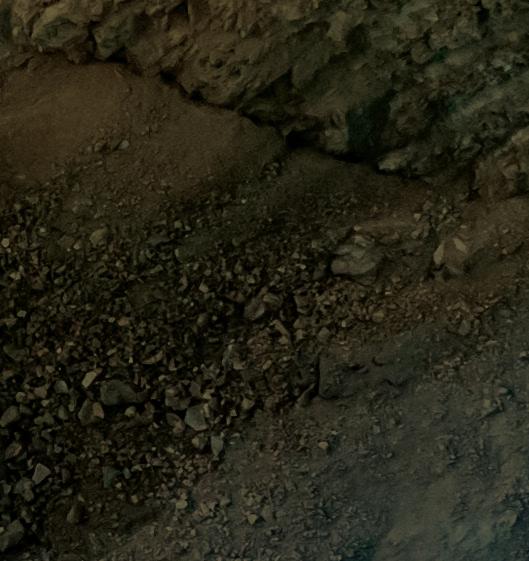
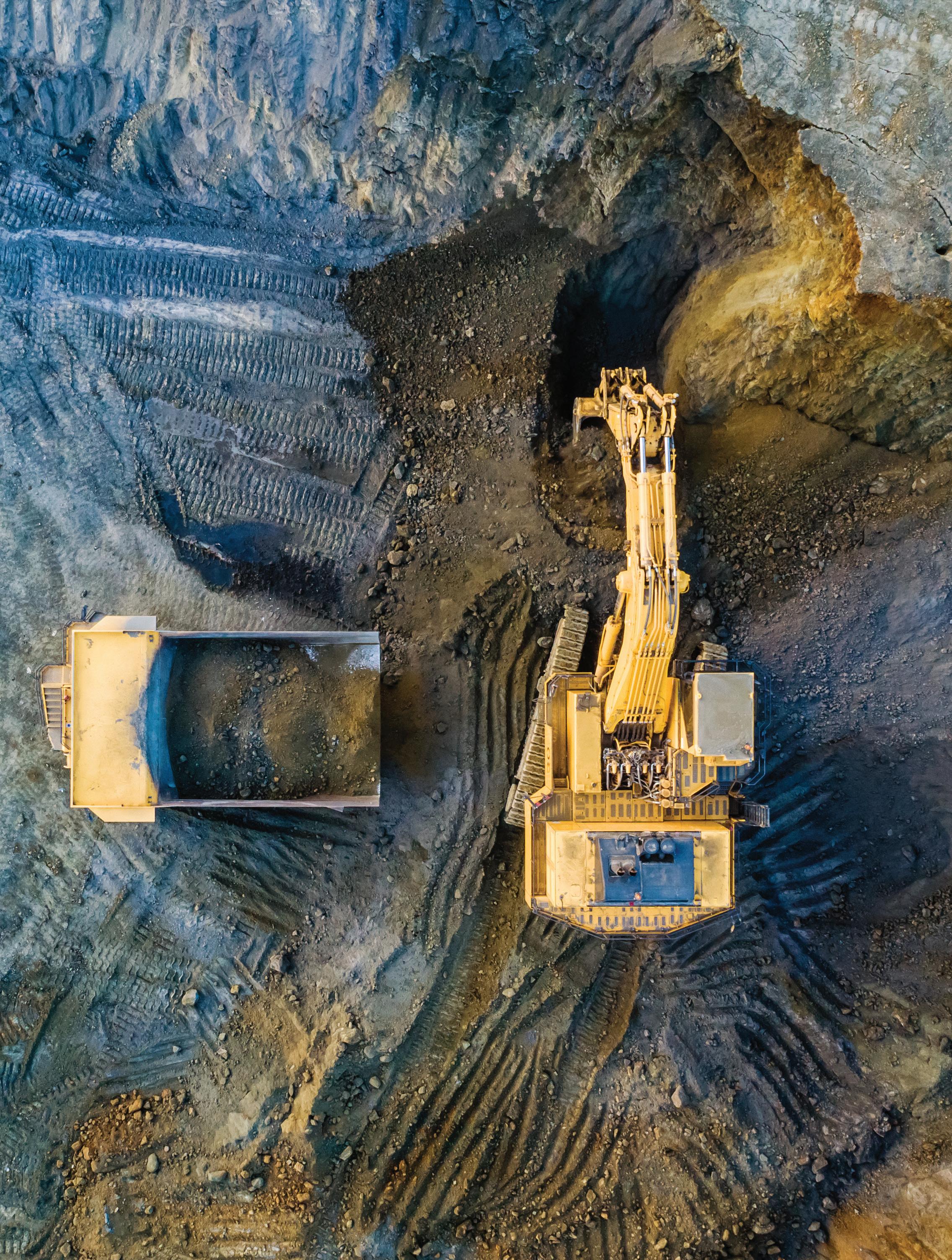

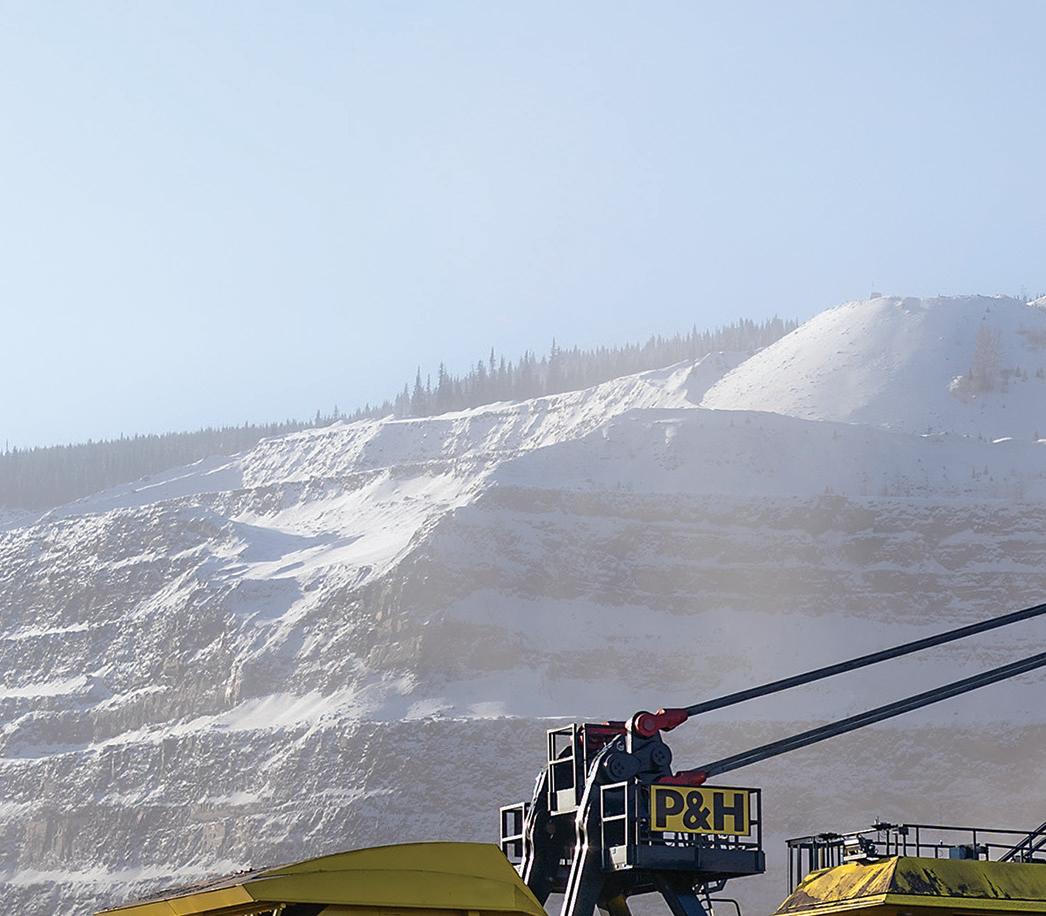
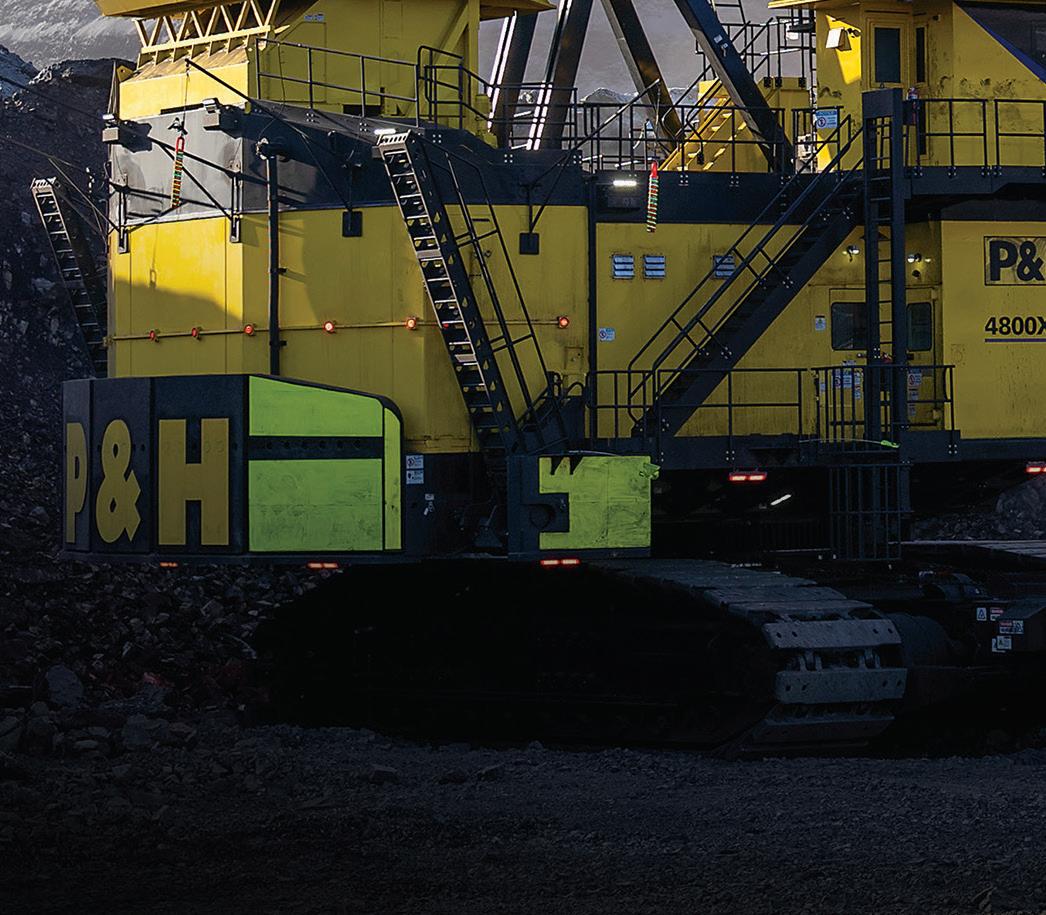








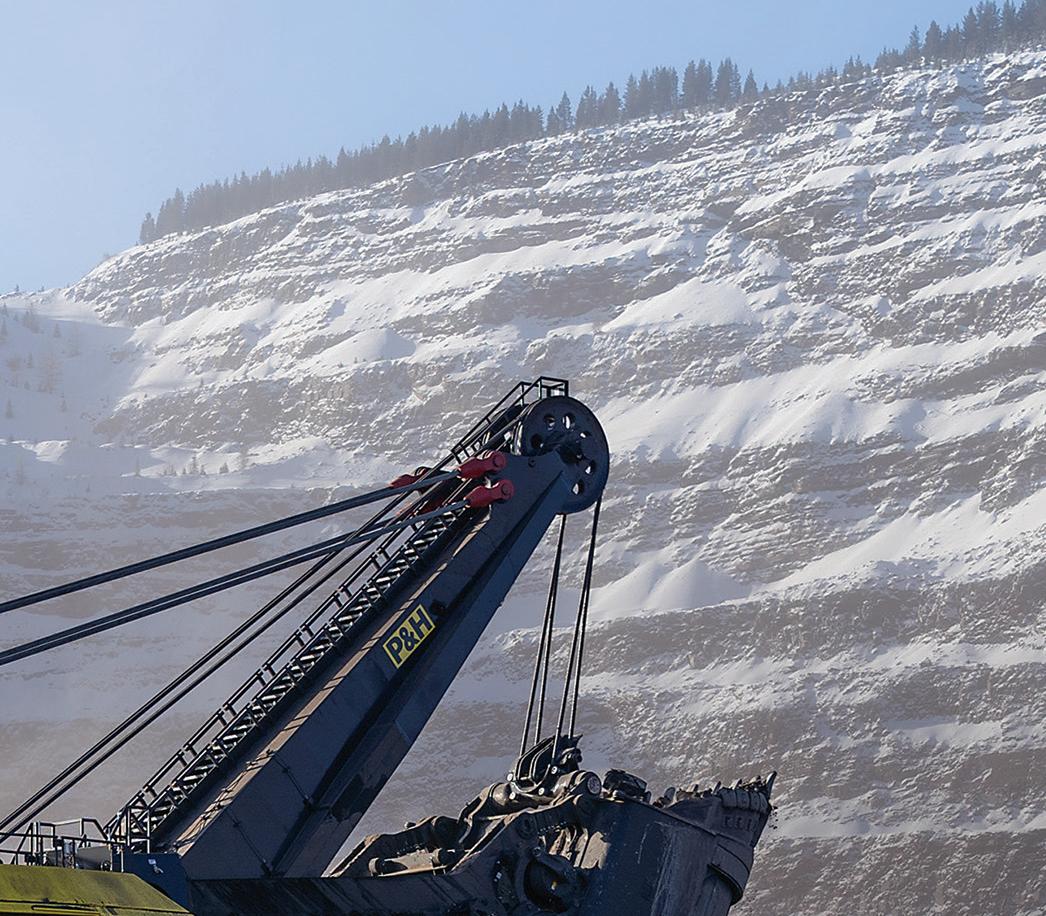
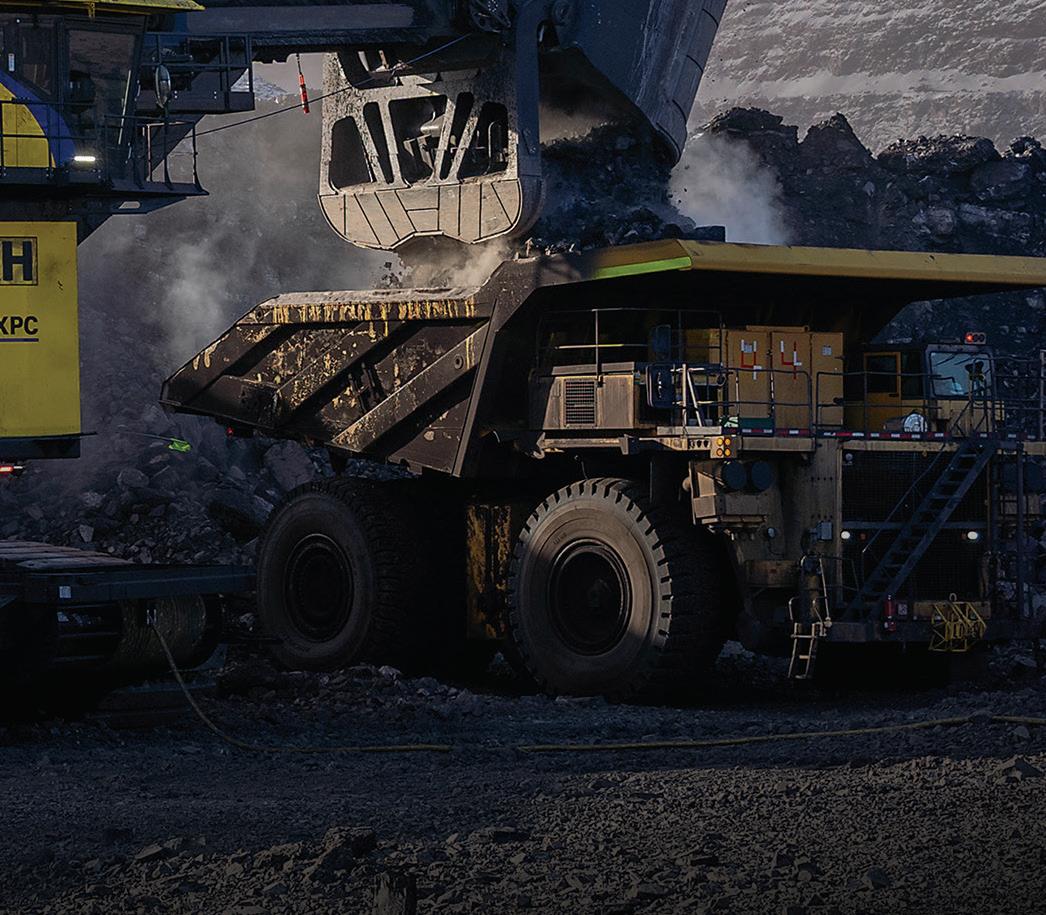










SURFACE MINING
12 Unlocking open-pit value.
14 Quiet giants: How electric machines can redefine surface mining.
28 The mining of tomorrow is here now: Advanced sample scanning enhances human expertise.
DRILLING AND BLASTING
16 From drill to detonation: Blasting smarter in surface mining.
22 Breaking new ground: Electrification, automation, and digitalization of mining drills.
24 Optimizing development drilling at Haile gold mine.
26 Blasting into the future of mining.
34 Subsurface imaging: The rise of new drilling technologies.
37 Revolutionizing tunnel development: Synthetic diamond technology for mining and infrastructure applications.
LOAD AND HAUL
29 The hidden cost of transporting equipment.
31 Let’s talk tailgates.
DEPARTMENTS
4 EDITORIAL | Breaking new ground: How technology is redefining surface mining. 6 FAST
AND
| Updates from across the mining ecosystem.
| Safeguarding your royalty interest: A primer on strategies.

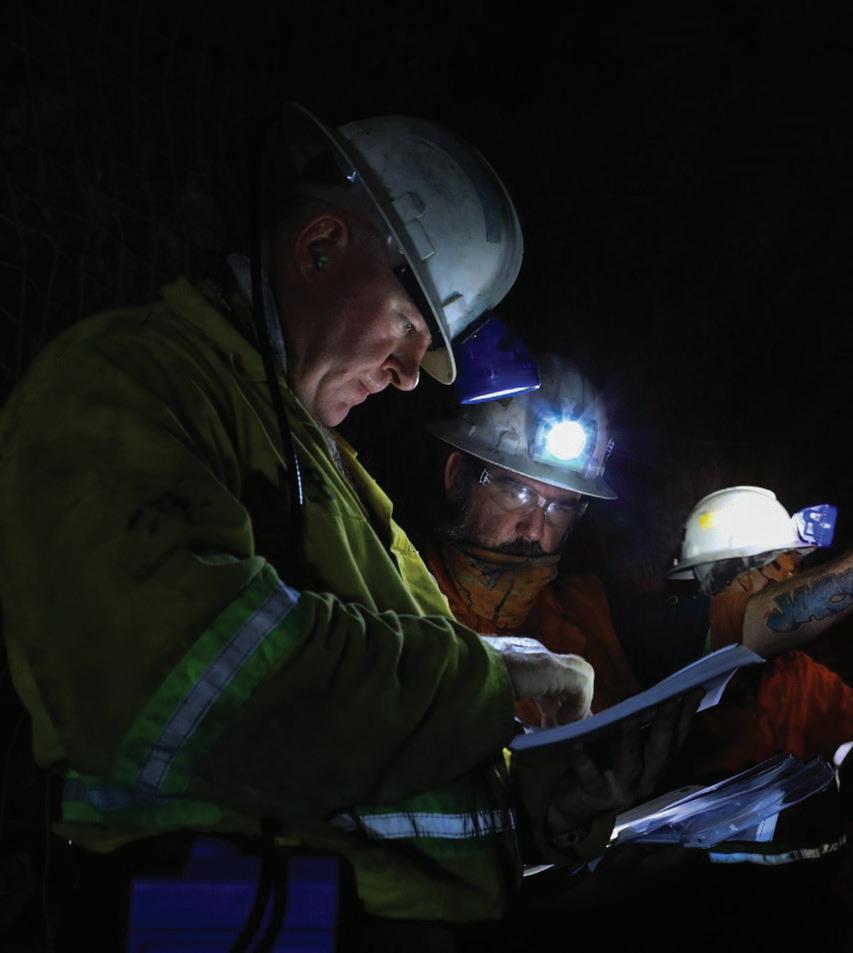
www.canadianminingjournal.com

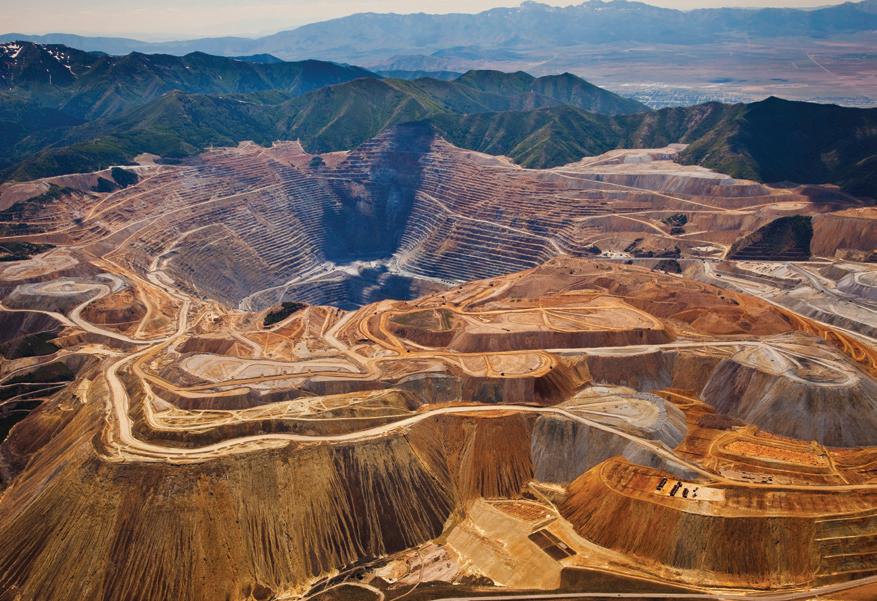
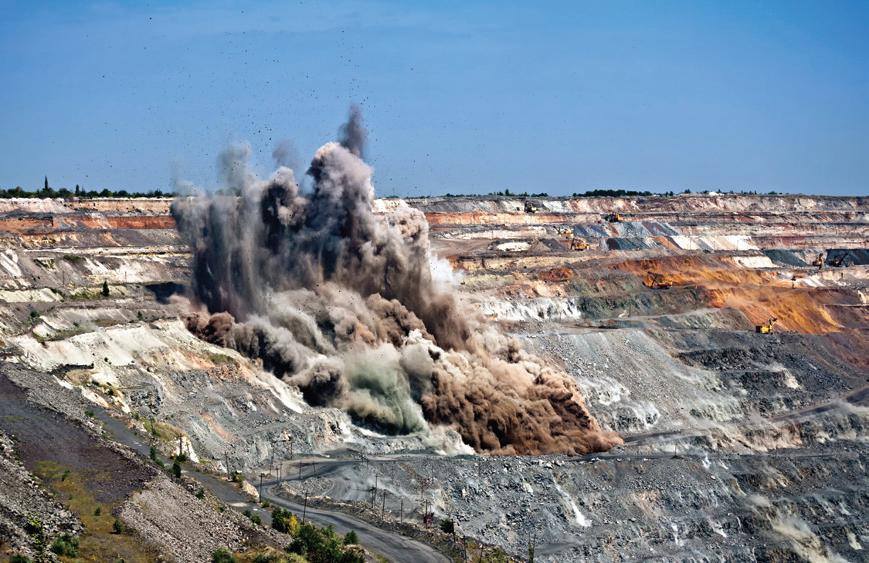


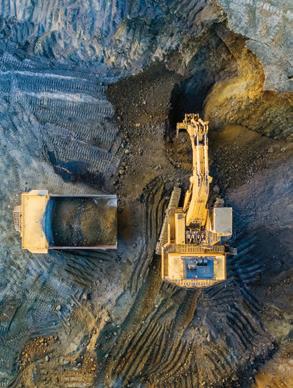

Breaking new ground: How technology is redefining surface mining
Automation, electrification, digitalization, and artificial intelligence (AI) are the key forces driving the transformation in surface mining, which is an industry traditionally defined by massive equipment and bulk earthmoving operations. Technological innovation is reshaping surface operations from drilling to hauling. The pursuit of greater efficiency, safety, and sustainability is pushing surface mining into a new era, defined less by horsepower and more by intelligence. What was once a field defined by physical intensity is evolving into an environment where digital fluency and data-driven thinking are essential.
Autonomous equipment is no longer experimental — it is operational. Driverless haul trucks, semi-autonomous drills, and remotely operated dozers are becoming integral parts of the fleet. These systems not only reduce human exposure to hazardous environments but also optimize cycle times, fuel usage, and maintenance schedules. The adoption of digital technology allows mining teams to create real-time, dynamic models of their entire operations. Additionally, as the mining industry faces mounting pressure to decarbonize, electrification is moving from aspiration to application. Battery electric and hybrid equipment — such as haul trucks and drills — are being deployed to reduce diesel consumption, lower emissions, and meet ESG targets. Finally, integrated data platforms are transforming how mines operate, connect, and optimize. With sensors embedded throughout the operation — from blast holes to processing plants — AI and machine learning (ML) models can now predict outcomes, detect anomalies, and recommend actions in real time. For example, AI can be applied to optimize blasting outcomes, reduce oversize material, and improve fragmentation.
As the digital transformation gains momentum, there is a growing emphasis on environmental accountability. Mines are adopting real-time monitoring systems for dust, vibration, and water quality, while leveraging drones and satellite imagery for progressive rehabilitation and compliance tracking. These tools not only support regulatory reporting but also help build trust with surrounding communities and stakeholders, especially First Nations.
Surface mining is becoming faster, smarter, and cleaner. As operations become increasingly data-centric and automated, the role of human expertise is also evolving — from direct control to strategic oversight and systems integration. In this new landscape, success will go to those who embrace innovation — not just in tools, but in mindset. The surface may still be the same, but what lies beneath is changing fast.
In this issue, we cover several topics related to surface mining on pages 12 to 16, and 28, with a special focus on drilling and blasting in articles on pages 16 to 19, 22 to 27, 34, and 37.
Additionally, in our load and haul section, we shed some light on recent advances in equipment transport.
Finally, in our August 2025 issue, we rank the “Top 40 Mining Companies in Canada” by revenue alongside an exclusive interview with a Top 40 CEO. The issue also includes featured reports on top development projects and material handling: conveyors, crushers and screens. Editorial contributions can be sent directly to the Editor in Chief before July 2nd.
JUNE/JULY 2025
Vol. 146 – No. 4
69 Yonge St., Ste. 200, Toronto, ON M5E 1K3 Tel. (416) 510-6789 Fax (416) 510-5138 www.canadianminingjournal.com
Editor in Chief Dr. Tamer Elbokl telbokl@canadianminingjournal.com
News Editor Joseph Quesnel jquesnel@canadianminingjournal.com
Production Manager Jessica Jubb jjubb@northernminer.com
Manager of Product Distribution Allison Mein 416-510-6789 ext 3 amein@northernminergroup.com
Publisher & Sales Robert Seagraves 416-510-6891 rseagraves@canadianminingjournal.com
Sales, Western Canada George Agelopoulos 416-510-5104 gagelopoulos@northernminer.com
Toll Free Canada & U.S.A.: 1-888-502-3456 ext 2 or 43734
Circulation Toll Free Canada & U.S.A.: 1-888-502-3456 ext 3
President, The Northern Miner Group Anthony Vaccaro
Established 1882
Canadian Mining Journal provides articles and information of practical use to those who work in the technical, administrative and supervisory aspects of exploration, mining and processing in the Canadian mineral exploration and mining industry. Canadian Mining Journal (ISSN 0008-4492) is published nine times a year by The Northern Miner Group. TNM is located at 69 Yonge St., Ste. 200, Toronto, ON M5E 1K3. Phone (416) 510-6891.
Legal deposit: National Library, Ottawa. Printed in Canada. All rights reserved. The contents of this magazine are protected by copyright and may be used only for your personal non-commercial purposes. All other rights are reserved and commercial use is prohibited. To make use of any of this material you must first obtain the permission of the owner of the copyright. For further information please contact Robert Seagraves at 416-510-6891.
Subscriptions – Canada: $51.95 per year; $81.50 for two years. USA: US$64.95 per year. Foreign: US$77.95 per year. Single copies: Canada $10; USA and foreign: US$10. Canadian subscribers must add HST and Provincial tax where necessary. HST registration # 809744071RT001.
From time to time we make our subscription list available to select companies and organizations whose product or service may interest you. If you do not wish your contact information to be made available, please contact us via one of the following methods: Phone: 1-888-502-3456 ext 3; E-mail: amein@northernminergroup.com
Mail to: Allison Mein, 69 Yonge St., Ste. 200, Toronto, ON M5E 1K3
We acknowledge the financial support of the Government of Canada.

Tamer Elbokl, PhD
THE RIGHT PARTNERSHIP MAKES EVERYTHING POSSIBLE.
At SMS Equipment, we’re more than machines from trusted brands like Komatsu. No matter your project, we’re the people beside you— today and every day—bringing industry-leading technology and expertise to your job site.
Because the right partnership makes everything possible.
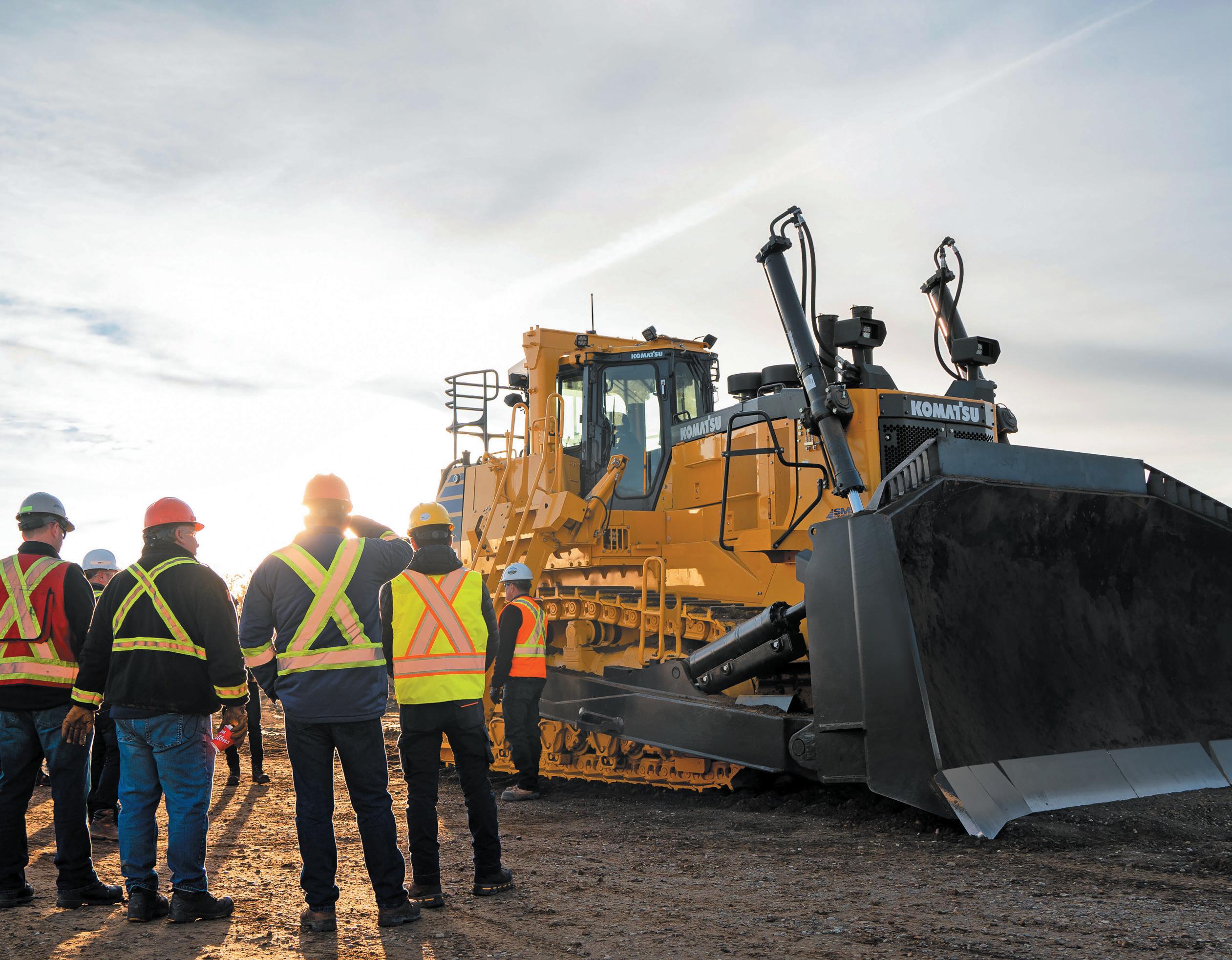
• EXPLORATION GROUNDWORK | Integral Metals starts phase 1 exploration at its KAP project

Integral Metals has engaged GeoCraft Geological Services to conduct phase 1 exploration activities on the company’s KAP Project, located in the Sahtu region of the Mackenzie Mountains in the Northwest Territories. Integral is an exploration stage company, engaged in mineral exploration for critical minerals, including gallium, germanium, and rare earth elements.
This initial phase sets the groundwork for targeted drilling planned later this year, with particular interest in following up on historical exploration which demonstrated zinc-lead mineralization, including high grades of gallium and germanium, which are critical metals known for their roles in advanced electronics and renewable energy technologies.
Paul Sparkes, CEO of Integral Metals, said: “We’re excited to kick off phase 1 exploration at the KAP Project alongside the experienced team at GeoCraft.”
• NEW TECH | Avonlea unveils new tech to transform lithium extraction
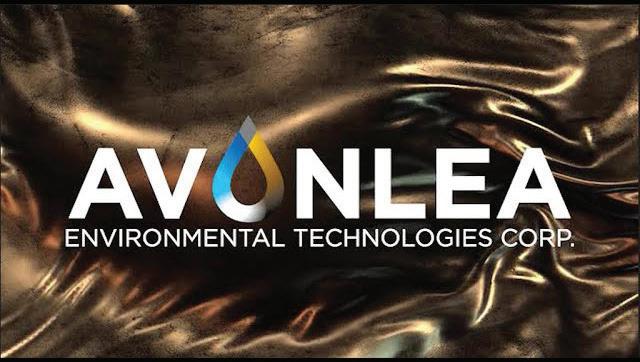
•
BEST
Avonlea Environmental Technologies
– a leader in eco-innovative industrial technologies – announced the launch of Cavitek, an innovative new technology that promises to transform lithium extraction through advanced cavitation science. With the global demand for lithium surging due to the rise of electric vehicles and renewable energy storage, Cavitek introduces a faster and more energy-efficient method of lithium mining.
At the heart of Cavitek lies a patented process harnessing controlled cavitation—a phenomenon where a localized pressure drop within a liquid causes the formation of microbubbles. These microbubbles become unstable and implode upon themselves releasing intense energy, at the molecular level in the form of high temperature and high-pressure shock waves, imposing powerful physical and chemical interactions.
Douglas Brett, president at Avonlea Environmental Technologies, said: “We’ve engineered a platform that applies science at the molecular level to drive real-world industrial transformation. Cavitek is not only a leap forward for the critical mineral extraction sector but also a win for sustainability— delivering unprecedented efficiency without compromising environmental stewardship.”
•
FIRST ESTIMATE | Abasca Resources releases inaugural mineral resource estimate for Loki Flake
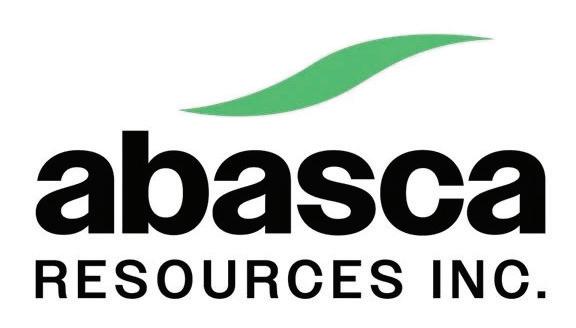
Abasca Resources has unveiled the inaugural mineral resource estimate (MRE) for its Loki Flake graphite deposit at its Key Lake South (KLS) project near regional infrastructure which services Cameco’s Key Lake operation. The project is located on a 23,977-ha exploration project in the Athabasca Basin region in northern Saskatchewan, about15 km south of the former Key Lake mine and current Key Lake mill.
The graphite MRE denotes a major milestone for the project and positions Abasca to play a significant role in contributing to North America’s secure supply chain of graphite.
The MRE has the following highlights: Total Inferred Resource: 11.31 Mt of Graphite at an average grade of 7.65 % Cg, contained graphite: 0.86 Mt, and a cut-off grade: 2.78 % Cg.
RESULTS | Troilus Gold reports single best intercept at Southwest zone of project

Toronto-based Troilus Gold announced positive drill results from its 2025 drill campaign at the Troilus copper-gold project in north-central Quebec. The program is focused on identifying and delineating higher-grade mineralization. The results reported today include the best intercept drilled to date in the southwest zone based on linear grade (grade x width). These results confirm the continuity of higher-grade material within the phase 1 reserve pit, which covers years one to five of the mine plan.
These first reported results include Troilus’s single best intercept in the history of drilling at the Southwest, in terms of linear grade. Drill hole SW-25-688 returned 2.44 g/t gold-equivalent over 56 metres from the primary ore shoot on which the phase one pit is centered and surpasses the previous strongest result from the southwest of 1.56 g/t gold-equivalent over 73 metres in hole TLG-ZSW20-189.
Justin Reid, CEO of Troilus Gold, commented, “We are very encouraged by the latest results from the southwest zone, which will be the first area mined when production begins. Hole SW-25-688 returned the highest linear-grade intercept drilled to date in this zone, highlighting the continuity of wide, high-grade mineralization in the core of the deposit. Additionally, SW-25-679 encountered strong near-surface grades that could further strengthen the early years of the mine plan. As the campaign progresses, we look forward to sharing more results that continue to improve confidence of the block model, de-risk the early production years, and enhance the overall development plan for the Troilus project.”
CREDIT: AVONLEA ENVIRONMENTAL TECHNOLOGIES.
CREDIT: ABASCA RESOURCES.
CREDIT: INTEGRAL METALS.
Troilus copper-gold project. CREDIT: TROILUS.
Harvest Gold announced it successfully received all required government / ATI permits, providing the company latitude for selecting drill targets in the northern and central areas of the Mosseau project. The project spans 147 claims totaling 7265.88 ha (72.66 sq.km). The project is located just east of Lebel-sur-Quévillon, Quebec.
The company has prioritized targets in the northern area. The company’s geological team has finalized targets in the central area. This team expects that process to be completed within the next two weeks. Harvest Gold continues to work with government regulatory authorities and First Nation communities
• CONSTRUCTION | Foran Mining reports first quarter construction progress for McIlvenna Bay
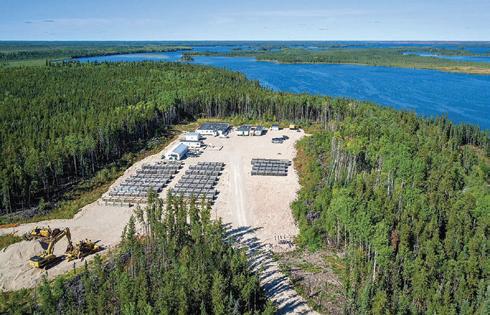
Foran Mining provided a construction update on its McIlvenna Bay project in Saskatchewan. As of the quarter ending March 31, 2025, the project continues to advance steadily, with significant progress made across key areas of development. Foran Mining is a copper-zinc-gold-silver exploration and development company.
The company has announced that overall construction progress reached 32%, with major ongoing work across the process plant, underground mine development, fresh air raise excavation, main electrical transformer station earthworks, coarse ore bin earthworks, truck shop, emergency vehicle storage building, tailings storage facility, permanent administrative building and camp expansion. Foran also stated that commercial production remains on track for H1 2026, aligned with previous guidance.
The company also said key structural milestones achieved include completion of primary steel installation and enclosure around the SAG and ball mills, initiation of roof panel installation, and progress on the process building foundations for secondary structural steel, wall panels and roof panels. Overhead crane installation and flotation equipment foundation work also continued. Detailed engineering is 92% complete, with a forecast to reach 95% by the end of April 2025.

to ensure proper consultation and compliance with all environmental and operational requirements.
Harvest Gold, president and CEO, Rick Mark, stated: “This set of government approvals clears the path to drilling in late spring/early summer. Our team has worked diligently to secure these permits and now turns to finalizing drill targets at Mosseau, which are being identified through an extensive compilation of historical data and Harvest Gold’s recent geological and geochemical surveys. This marks a significant milestone for the Company as it advances exploration efforts to unlock the potential of our flagship Mosseau project.”
• MINING LAWSUIT | Xatśūll First Nation launches legal challenge against B.C. for approving Mount Polley mine expansion

Xatśūll First Nation has filed a judicial review with the Supreme Court of British Columbia against the province’s minister of mining and critical minerals, the minister of environment and parks, the provincial deputy permitting officer, major mines offices and the Mount Polley Mining Corporation to overturn two provincial decisions authorizing Mount Polley Mining to raise the height of the dam at the tailings storage facility.
Xatśūll First Nation is a First Nations government that is part of the larger Secwepemc (Shuswap) nation, located in the Cariboo region of British Columbia near Williams Lake.
The First Nation is alleging provincial decision makers allowed this work to proceed without an environmental assessment, which is legally required in the circumstances. In addition to the judicial review, Xatśūll will also seek an injunction, which will be filed in the coming days, preventing construction of the dam raise until the court process is concluded.
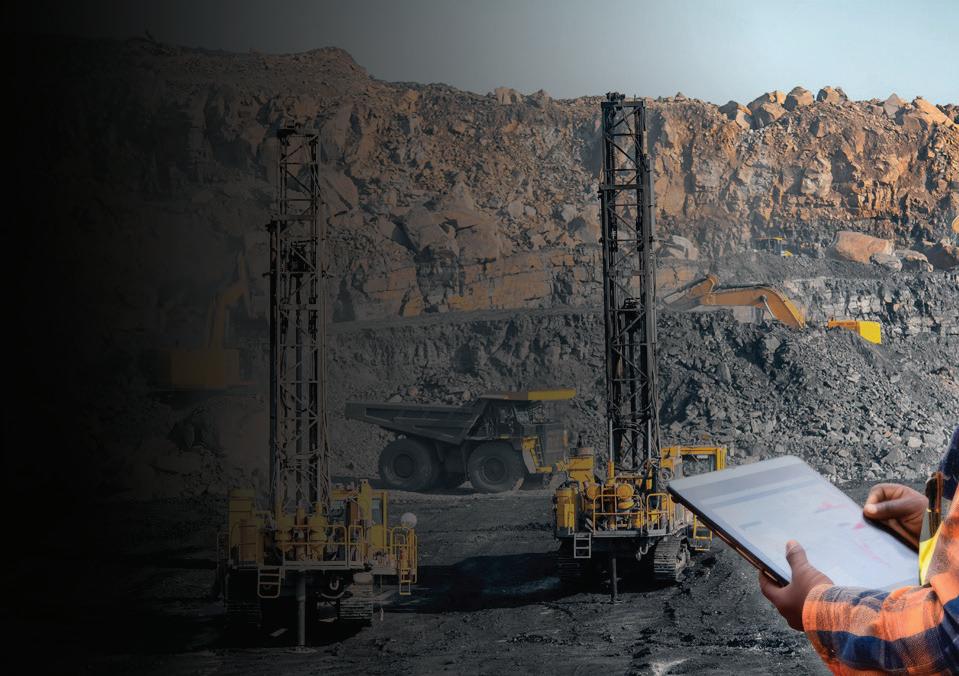
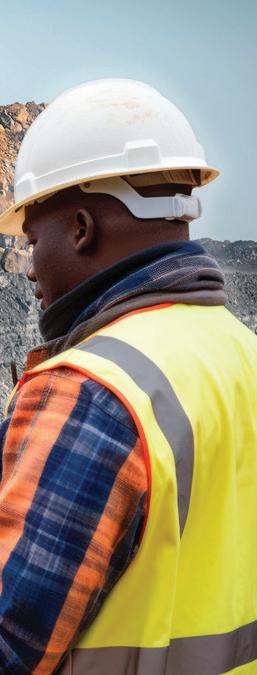
The camp at Foran Mining’s McIlvenna Bay polymetallic project in Saskatchewan. FORAN MINING PHOTO
Aerial view of Mount Polley tailings dam breach in August 2014. IMAGE COURTESY OF BUSINESS IN VANCOUVER.
FAST NEWS
•
NEW COMPANY | Commerce and Mont Royal merge to create a Quebec-focused critical minerals company
Commerce Resources has entered into an agreement with Mont Royal Resources to merge the two companies. The merger will create a Quebec-focused critical minerals explorer and developer, combining Commerce’s Ashram rare earth and fluorspar project and Eldor niobium project with Mont Royal’s Northern Lights lithium project. The new critical minerals developer and exploration company will have a strong focus on rare earths, fluorspar, niobium and lithium exploration.
The newly combined entity will be dual listed on the TSX VentureExchange (TSXV) and the Australian Securities Exchange (ASX), enhancing access to capital and liquidity. The merger also unites
experienced leadership teams with strong track records in capital markets, project development, and operations.

The companies involved have listed the following rationale for the merger: The deal will create a complementary exploration asset package at Mont Royal’s Northern Lights project, covering an area of 536km2 in the Upper Eastmain Greenstone belt, offering lithium, copper and gold potential; and achieving a dual listing on the ASX and TSXV, which aims to attract a broader range of investors for the Merged Group, increase liquidity and greater ability to raise capital.
• PROJECT REVIEW | Impact Assessment Agency accepts public comments on approved James Bay lithium project
The Impact Assessment Agency of Canada (IAAC) is accepting public comments as part of its post-decision phase for the James Bay lithium mine project. The project is for a lithium mine located east of James Bay and the Eastman Cree community in Quebec. As proposed, the James Bay lithium mine project would have an estimated mine life of 15 to 20 years and produce on average 5,480 tonnes of ore per day. The project would include an open pit mine and concentrator facility, tailings, waste rock, ore and overburden storage areas, as well as related infrastructure.
This comment period cannot change the project’s approval. It strictly applies to certain proposed amendments to the decision statement that already resulted in an approval.
Galaxy Lithium – the project proponent – became subject to certain legally binding conditions when the project was approved back in 2023. Galaxy Lithium must comply with these conditions throughout the life of the project, including advising IAAC of any proposed changes to the project that may result in adverse environmental effects.
Since then, the company has submitted information to IAAC proposing project changes. The proponent wishes to adjust the location and configuration of certain waste rock piles.
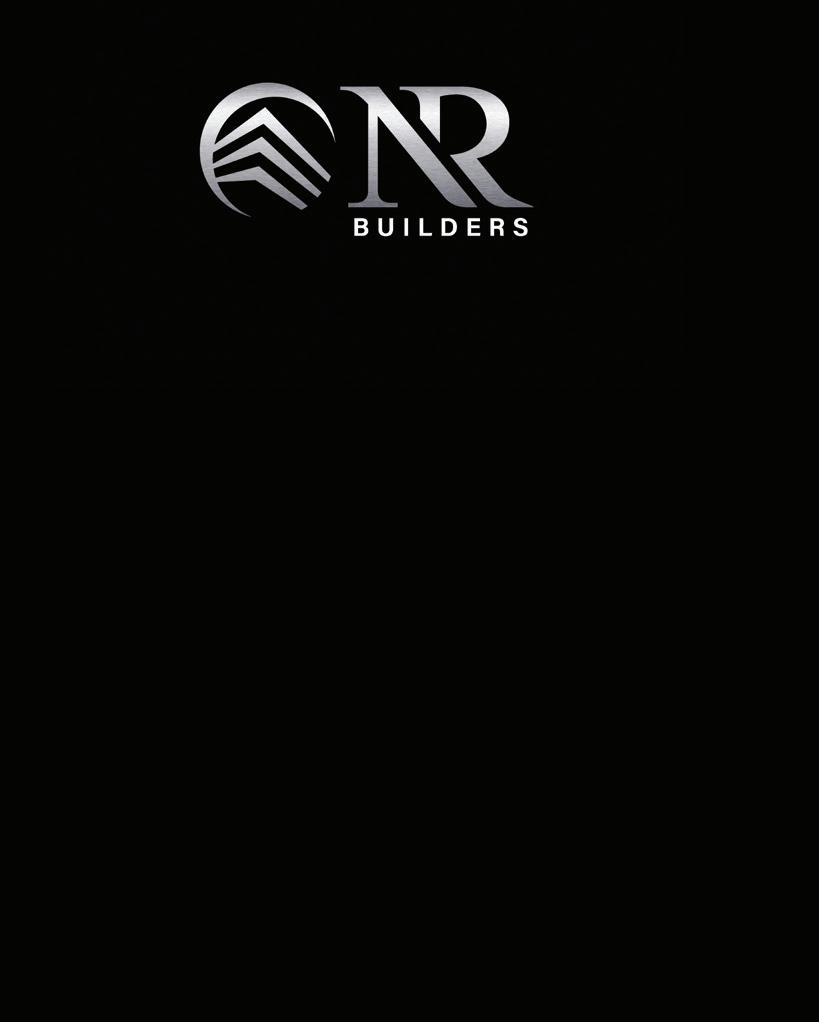
MINE CONSTRUCTION AND MAINTENANCE
Noah Rain Builders…tackling extreme conditions in remote locations, overcoming tough terrain and weather to build essential infrastructure safely and efficiently. Effectively and efficiently maintain operational mines to ensure smooth flow of production and operations. www.noahrainbuilders.com
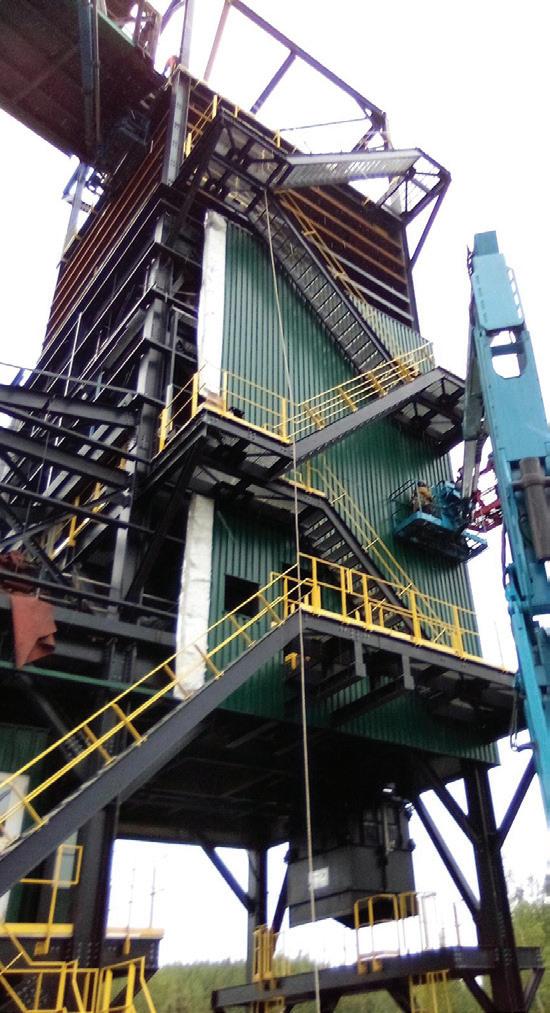
• WOMEN IN MINING | Top three mining companies recognized for advancing women in the industry in 2024
In a groundbreaking achievement for advancing gender equality in the mining industry, Artemis Project announced its top three mining companies in Canada for their exemplary commitment to gender-responsive procurement (GRP) in 2024.
These companies are recognizing and accessing innovative talent through their supply chains, driving diversity and cutting-edge solutions within the industry. Their exceptional leadership in embedding gender equity into procurement policies, building an inclusive supply chain, and creating new opportunities for women-owned businesses sets a powerful example for the entire sector.
The top three companies honoured for their progressive practices are: Eldorado Gold, New Gold , and Rio Tinto
These companies were selected after an evaluation process based on key criteria, including, the extent of their outreach and partnerships with Artemis Women-Owned Businesses, and the measurable impact of their initiatives in fostering gender equality within their supply chains.
Heather Gamble, CEO of Artemis Project, said, “These companies are setting a powerful example of how the mining industry can tap into innovative, specialized talent while advancing gender equality.”
Commerce Resources’ Ashram rare earths project in Quebec.
By Samantha Weng, Simon Grant, Jane Helmstadter, and Ali Naushahi

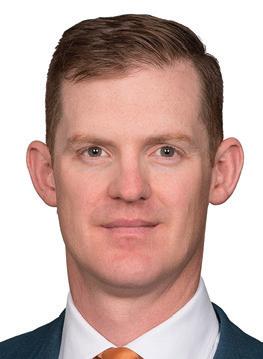
Safeguarding your royalty interest: A primer on strategies

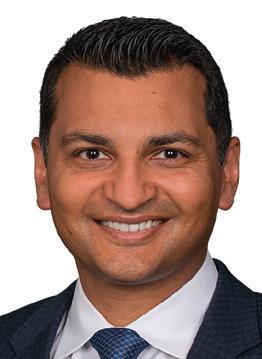
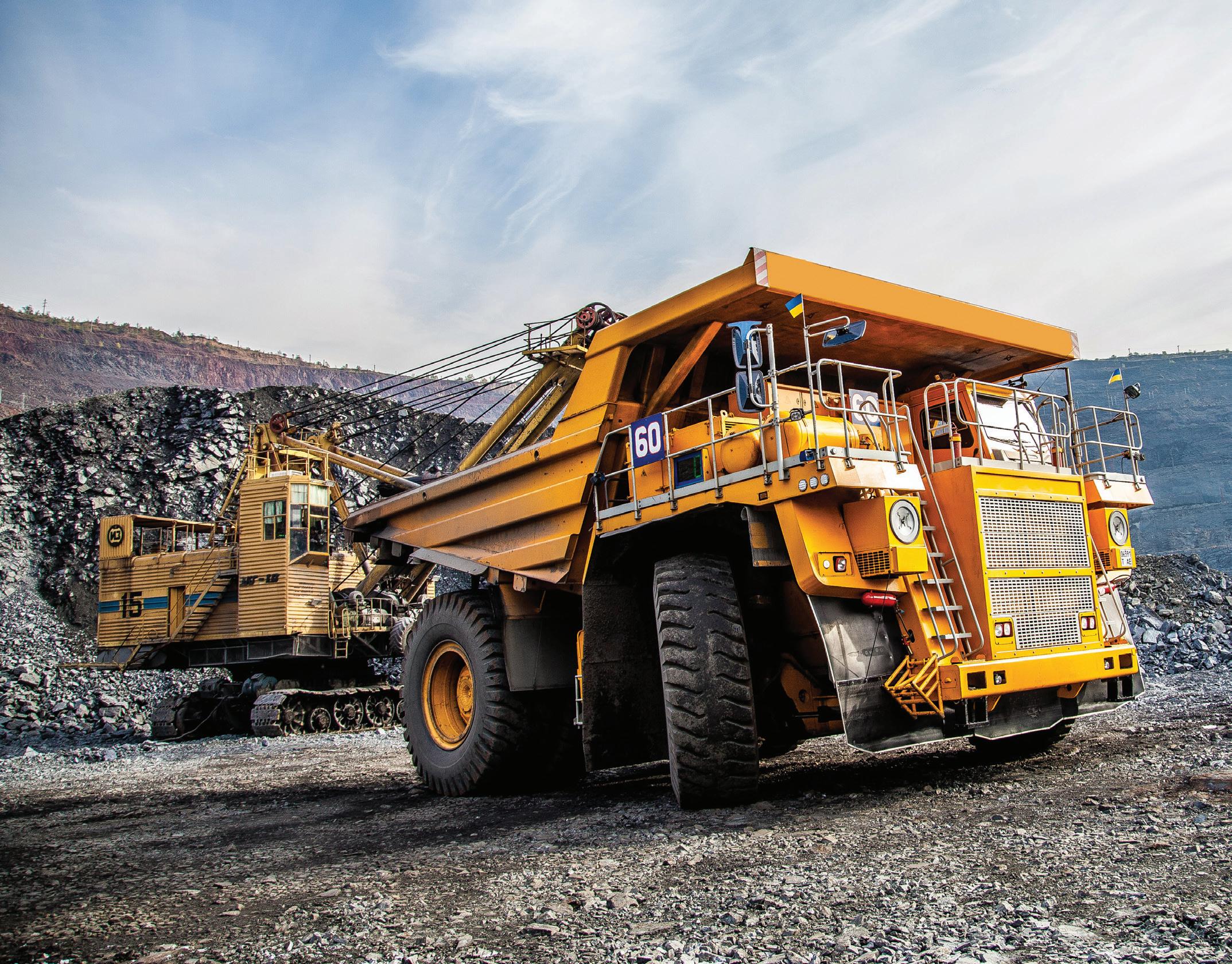
Royalty financing is a well-recognized alternative to traditional types of financing in the mining world. It is an attractive means for companies to obtain capital for projects without share dilution, increasing leverage, or relinquishing operational control. For investors, the returns can be significant, but so can the risks. The question of how best to protect royalty interests from potential downsides is therefore ever-present.
The predominant legal issue concerning royalties, according to Barry Barton, author of “Canadian Law of Mining,” is ensuring the royalty binds subsequent property owners. Royalty holders want their interests to be enforceable against successors of the royalty grantors, increasing the lifespan of the investment and therefore profitability (or its prospect). How-
ever, the law has not always been straightforward on what is required to achieve this.
Structuring a royalty interest
Generally, structuring a royalty interest as a property interest rather than a contractual interest increases the likelihood that the royalty and associated obligations will bind successors. At law, an interest in land typically runs with the land through ownership changes, whereas a contractual interest is a personal right enforceable only against the original grantor. This “land interest versus contractual interest” distinction is often at the heart of the dispute in insolvency proceedings involving assets subject to royalties — highlighting the importance of characterization.
Structuring a royalty interest as a property interest rather than a contractual interest increases the likelihood that the royalty and associated obligations will bind successors.
Royalty holders in Canadian common law jurisdictions cannot assume that their royalties are, by default, interests in land that will survive property transfers — even if that is the parties’ expectation. When creating such interests, royalty holders must be guided by, among other things, the two-step measure endorsed by the Supreme Court in “Bank of Montreal versus Dynex Petroleum Ltd.” and ensure that: (i) the royalty agreement clearly expresses the participants’ intent that the royalty constitutes a property interest, and (ii) the interest out of which the royalty is carved is an interest in land.
Royalty agreements, according to Barton, should unambiguously incorporate legal provisions that enhance the probability that the royalty will “run” with the land, such as the following: (i) language granting or reserving a royalty interest in the real property; (ii) a complete list and legal description of the properties subject to the royalty; (iii) the right to register a notice of interest on title; and (iv) a prohibition against property transfers unless the transferee expressly assumes the royalty and related obligations.
A caution from the court
caveat of its interest against the relevant properties with the applicable land title office or ministry. This registration will establish the priority of interest in the properties against subsequent interests of third parties, and the act of notifying the public may also be seen as evidence that the royalty is intended to bind new property owners.
Ontario law does not preclude courts from granting vesting orders conveying land to purchasers free and clear of encumbrances such as royalties. However, the Court of Appeal for Ontario said in “Third Eye Capital Corporation versus Dianor Resources Inc.” that “it is difficult to think of circumstances in which a court would vest out a fee simple interest in land.”

The Ontario Superior Court of Justice cautioned in “St. Andrew Goldfields Ltd. versus Newmont Canada Ltd.,” that “royalties and royalty agreements are unique and have to be read with care.” To safeguard one’s royalty interest — regardless of type — the agreement must be thoughtfully crafted, moving beyond the incorporation of some “magic words” and give due regard to, at a minimum, all the facts of the transaction, the type of interest out of which the royalty derives, each party’s intention and objective, potential future disputes, and clarity in drafting. If a litigant later challenges whether the royalty runs with the land, the expressed intention of the contracting parties should at least guide the court in adjudicating the dispute.
Once an agreement is entered into, the royalty holder should, where possible and as soon as practicable, register a notice or
In “Dianor,” although the holder’s gross overriding royalties — which were deemed by the Court to be between a property interest and a contractual interest — were
extinguished by the motion judge erroneously and not reinstated on appeal, it was primarily owing to the company’s failure to appeal the initial ruling within the legislatively prescribed timeframe. This is another reminder to royalty holders to stay vigilant in safeguarding their interests.
Samantha Weng is an associate; and Simon Grant, Jane Helmstadter, and Ali Naushahi are partners at Bennett Jones LLP in Toronto.
Samantha’s practice centres on the acquisition, disposition, financing, and leasing of commercial properties throughout Ontario. Simon advises on a broad range of financing and lending matters, with an emphasis on complex cross-border financial transactions. Jane advises clients on a full range of domestic and cross-border purchase and sale, property development, financing, asset management, leasing, and JV transactions. Ali practices corporate and securities law, with an emphasis on corporate finance, M&A, and mining.
Establishing the triangle of trust: Creating the necessary dialogue

By Peter Bryant

In our last column, we emphasized the significance of establishing a triangle of trust that includes companies, the government, and Indigenous communities, creating a shared vision of prosperity with all stakeholders and owners. But in a world of such low trust and high tension, how can we go about creating the necessary dialogue between the government, communities, and companies? What does this look like from a practical standpoint? While this type of co-created shared value is relatively a new way of thinking for companies across the minerals value chain, there are some examples we can look to that can provide an approach. One is the Development Partner Institute’s (DPI) Responsible Sourcing Coalition (RESCO), launched in late 2019 in partnership with The Rockefeller Foundation. To date, this remains one of the few, if not the only, value chain, multi-stakeholder/owner dialogues that bring all voices to the table, particularly community and Indigenous (at both the provincial and country level) perspectives. This international coalition is focused on responsible sourcing and was a result of a special dialogue hosted at the Rockefeller Foundation’s Bellagio Center, where the group came together to discuss a vision for responsible sourcing, strengthen the understanding of each stakeholder’s challenges and priorities, learn from attempts to standardize sustainability efforts in other sectors, and align on a pathway for the minerals sector. This dialogue involved breaking down the different stakeholder motivations and expectations, including mining companies, Indigenous communities/owners, government, investors, downstream companies, and more. Representatives from each group shared perspectives. This ultimately resulted in a set of workstreams to develop a vision and set of principles for responsible sourcing that provide flexibility, allowing for the variations of each commodity and jurisdiction. Key to the success of this approach was clearly defining roles for each stakeholder in the conversation and ensuring there was equal representation across those groups. Radical transparency is critical in these dialogues, and that can only be achieved by giving participants freedom and protection to express their views openly. Creating a safe environment for what can at times be difficult conversations is key, as is ensuring that one group is not dominating the conversation or bringing forth a prescriptive solution. Government can play a key role here in establishing the “sandbox” (environment) with the appropriate guardrails, so that discussions consider the unique aspects of each project and its jurisdiction but still adhere to a co-created set of principles.
While this is a good example of how to convene on a global level, there are several models we can look to build upon that are specific to Canada. The First Nations Major Projects Coalition is an active and important driver of these key dialogues in the Canadian territories and should be looked to as a model for how to bring different stakeholder groups together in a productive way while speaking truth to power. Not only do they advocate for ownership in major mining projects, but they bring a value-driven approach to bringing together stakeholders from the government and the private sector, advancing major projects around issues like clean fuels, responsible sourcing, and transportation corridors, among others.
International policy changes, like the adoption of Free, Prior, and Informed Consent (FPIC), are important. Equally important are national efforts and legal frameworks that provide stronger protections and greater autonomy for Indigenous communities over their resources, leveling the playing field for the key stakeholder group — owner — that has long been neglected. In Canada today, there are over 50,000 Indigenous-owned resource management companies, and the mining industry in Canada has become the largest private-sector industrial employer of Indigenous peoples and partner of Indigenous businesses, with over 500 active agreements between companies and communities.
Governance models that enable Indigenous communities to make decisions over resource management and incorporate their knowledge and perspective in policies are giving them an even stronger voice in these dialogues. Indigenous-led resource management boards, such as the Nisga’a Nation in B.C., is a great example. These protections and policies are important elements to ensure that each stakeholder that comes to the table to align on a vision of prosperity is empowered and therefore can engage in open dialogue. At the heart of these efforts must be the core values of communication, coordination, and collaboration. As the demand for critical minerals becomes more urgent than ever before, it is key that the players that can affect progress and the necessary development trust one another and are aligned on a shared vision of success.
Peter Bryant is a managing director and board chair of Clareo and the co-founder and chair of the Development Partner Institute. Lana Eagle is an Indigenous relations strategist and a member of the Whitecap Dakota First Nation. She is currently on the board of the Prospectors and Developers Association of Canada (PDAC).
By Kabelo
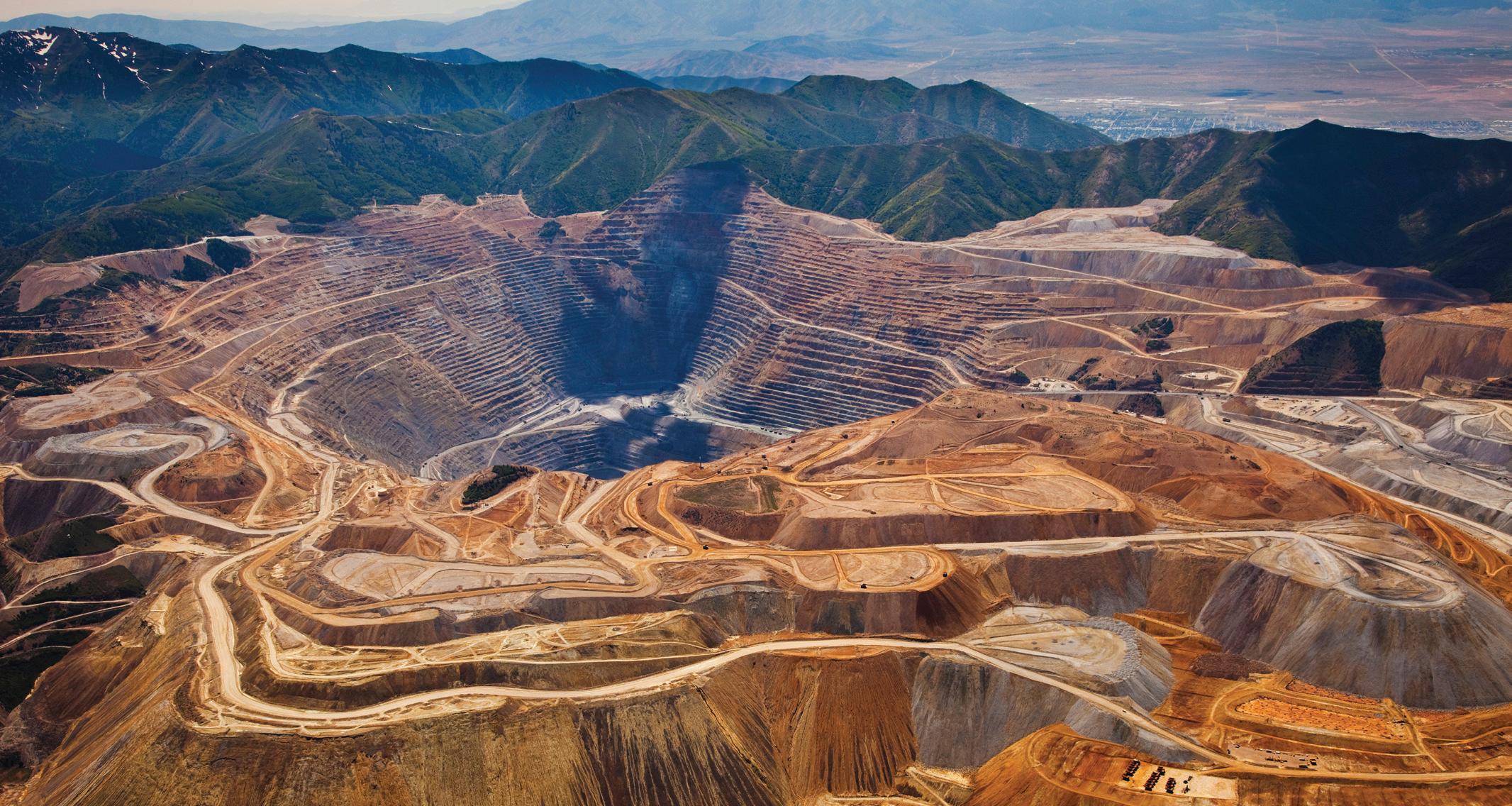
Unlocking open-pit value through holistic approach from operations to life-of-mine (LOM) planning
Surface (open-pit) mining is constantly under increasing pressure of cost efficiency owing to deeper mines, increased waste handling, and related strip ratios. Broader challenges such as declining ore grades, rising operational costs, and heightened stakeholder expectations are forcing operators to rethink how to maximize value from their assets.
And while both local optimization of parts (including drill and blast, loading, hauling and processing in the short-term) and sequential optimization (cutoff grade optimization, ultimate pit limit, and sequencing) remain sine qua non to any successful open-pit endeavour, truly moving the needle in this area means recognizing the value in simultaneous optimization at both operational and strategic levels.
However, achieving this goes beyond localized and siloed optimizations, instead requiring a holistic approach to open-pit mining that connects tactical execution with long-term planning to achieve sustainable outcomes. To maximize value, mining companies must critically consider, identify, and solve for a complex array of operational imperatives while implementing sustainable solutions derived from a life-of-mine (LOM) planning lens.
Waste management as a strategic challenge within operations
Firstly, effective waste management remains a critical issue for open-pit mining. As mines move more material to access ore, they face the dual challenge of balancing higher material movement with technical and operational constraints, alongside financial pressures.
An increased environmental, social, and governance (ESG) focus is also elevating waste management beyond a simple operational task. A survey by EY found that 44% of mining executives believe waste management will represent the most scrutinized ESG element from investors in the mining and metals sector in 2025, emphasizing the importance of transparent reporting on waste generation and management efforts. By proactively addressing these operational realities, mining companies can mitigate risks, reduce liabilities, and enhance their reputation in an increasingly competitive landscape.
More than ever, operational efficiencies in waste management are emerging as measurable proof points to underscore cost efficiency and the strengthening of brand reputation among stakeholders. It can also serve as a reflection of an organization’s sustained commitment to environmental obligations.
At the operational level:
Unlocking immediate value through operational discipline
To unlock near-term value, some miners are using tools like value driver trees (VDTs) to identify which operational levers offer the highest impact. These typically include areas such as drill and blast, loading, and hauling. By mapping out value pathways, VDTs help site teams focus efforts on where they matter most.
In addition to performing traditional analyses like reconciliation and compliance, there is an increasingly sophisticated pool of tools at a miner’s disposal to visualize the impact of the VDT and simulate different scenarios, quantifying trade-offs,
Leeka, Daniel Morales, and Theresa Sapara
The Bingham copper mine is an open-pit mining operation extracting a large porphyry copper deposit southwest of Salt Lake City, Utah. CREDIT : ALLEN/ADOBE STOCK
and supporting decision-making. These tools connect operational performance with financial outcome, making improvement opportunities clearer and more actionable.
Starting at the operational level creates visible wins, builds internal momentum, and lays the groundwork for broader strategic initiatives. It helps teams provide the value of change with real results on the ground.
At the strategic level: Simultaneous optimization
The incorporation of advanced simultaneous optimization tools into LOM planning offers another compelling avenue for open-pit activities, providing opportunities to enhance operational efficiency and maximize asset value. Certain software solutions currently available in the market look to leverage stochastic modeling to generate optimized production schedules that align with evolving market conditions and resource availability. By leveraging the simultaneous optimization of when, where, and how to process material, these tools enable operators to make informed decisions that significantly increase the net present value (NPV) of their assets.
Not to be forgotten and equally important is the strategic allocation of capital which also plays a determining role in open-pit mining, ensuring investments are directed toward high-impact initiatives that drive both short-term gains and long-term sustainability. Miners can even avail themselves to tools that specifically facilitate the optimization of capital decisions like capacity increases through equipment acquisition or the honouring of ESG key performance indicators (KPIs) like decarbonization.
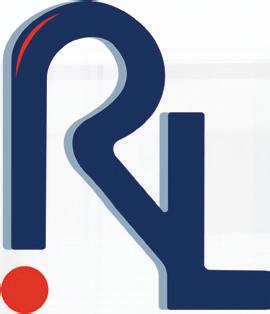
Future-proofing mining operations through innovation and strategic alignment
The current economic landscape is exacerbating many of the challenges inherent in open-pit projects. That is why the industry must proactively address the challenges of productivity, cost efficiency, and waste management to remain competitive. By adopting a systems-level approach that harmonizes technical performance with financial outcomes, mining companies can unlock new value in their operations.
Moreover, the integration of advanced diagnostic tools can further enhance operational efficiency and support long-term sustainability goals. These modern digital platforms provide insightful dashboards focused on KPIs, enabling data-driven decision-making that enhances productivity and reduces costs. These tools are specifically designed to help companies identify operational bottlenecks, optimize resource allocation, and simulate operational scenarios to forecast outcomes, ensuring that every decision is backed by robust data to maximize openpit productivity.
By embracing a comprehensive suite of operational and strategic tools, mining companies can navigate their open-pit operations, ensuring they are well-equipped to meet future demands while maximizing their value proposition. Ultimately, proactive management of these issues will enable miners to thrive in a competitive market, allowing for growth.
Kabelo Leeka, Daniel Morales, and Theresa Sapara support the Americas Metals & Mining Centre of Excellence at EY.





QUIET GIANTS:
How electric machines can redefine surface mining
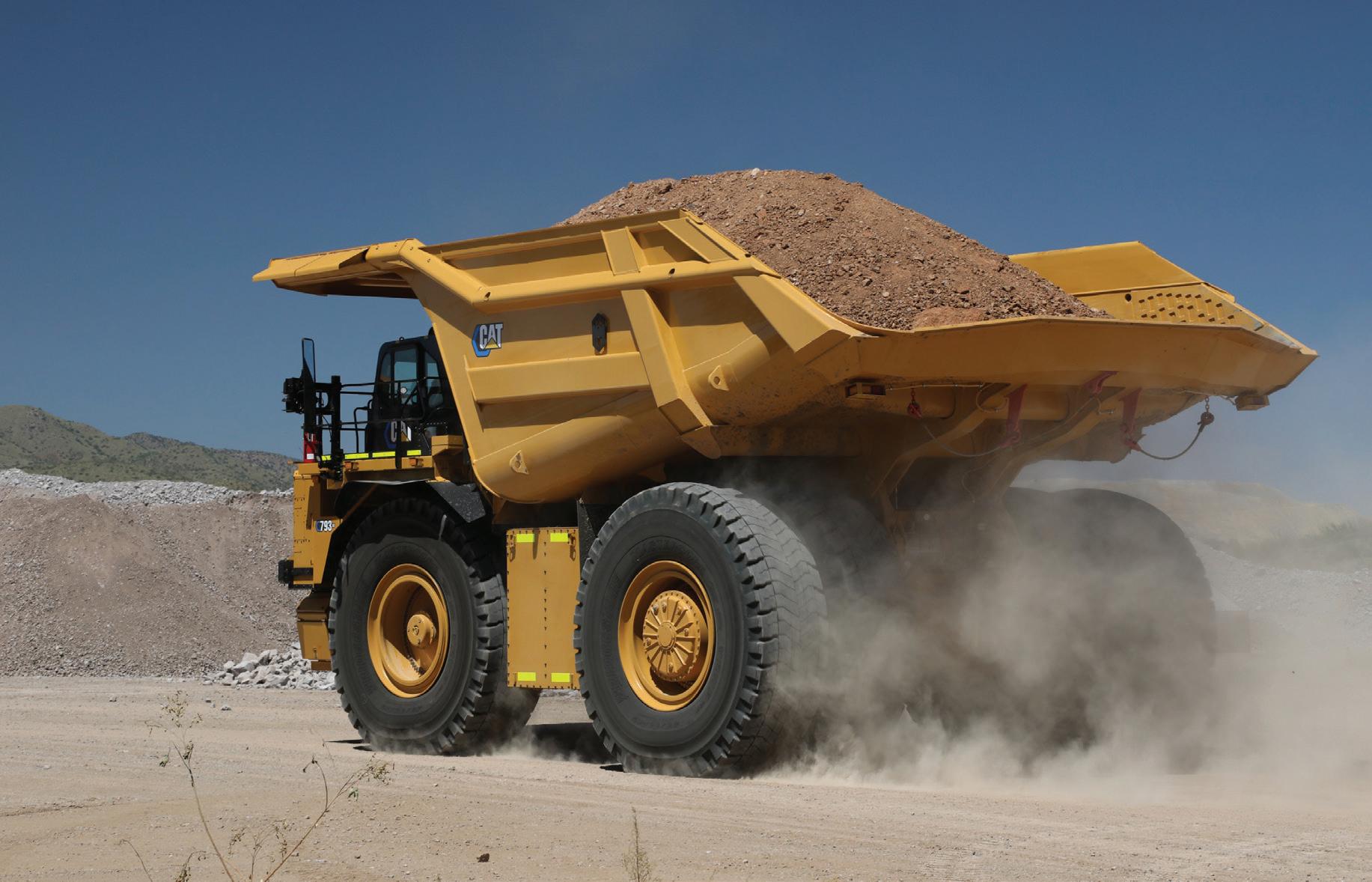
There has been much written about the transition of underground fleets from diesel to electric. Largely, the impetus for this trend has been credited to the decrease in ventilation costs and impact on workers’ health inherent with battery electric equipment. These adoption pressures do not exist in surface mining in the same way but still, surface mining is on the cusp of a major transformation as electrification moves from the underground to the open pit. The diesel-dominated fleets that have powered surface operations for decades are now facing different pressures to evolve, driven by a mix of regulatory, economic, environmental, and social forces. Electrification is now emerging as a strategic priority for surface operators looking to future-proof their assets, reduce costs, and meet increasingly ambitious emissions targets. With proven technologies rapidly maturing over the last decade and innovative companies stepping into the space, the path forward is becoming more defined, and Canada has a significant role to play.
The motivations for electrifying surface fleets are multi-faceted but reducing carbon emissions is chief among them. Governments around the world, including Canada, are enforcing stricter emissions regulations, and major mining companies are setting aggressive net-zero goals in response to investor pressure and stakeholder expectations. Electrification offers a direct means of addressing Scope 1 emissions, particularly from haulage and support vehicles, which collectively represent a large share of a mine’s carbon footprint. However, transitioning to battery electric equipment is not just about optics, it is about aligning core operations with climate policy and staying ahead of tightening regulatory frameworks. Beyond compliance, cost efficiency is a powerful driver of electrification in surface mining. According to a report 2021 by Coencorp, diesel fuel alone can account for 3% to 10% of a mine’s total operating expenditure, and it is one of the largest operating expenses for mines. Battery electric vehicles (BEVs), while still carrying a higher upfront capital cost, can deliver
significant savings over their lifespan. With fewer moving parts than internal combustion engines, BEVs are cheaper to maintain, require less downtime, and eliminate the need for large quantities of fuel and lubricants. When paired with renewable energy sources for charging, they offer a stable and often cheaper energy profile that can give firms a valuable edge in increasingly competitive commodity markets.
Electrification also addresses growing expectations around worker health and community safety. Diesel particulate matter (DPM) has long been a concern in mining environments, and reducing emissions at the source creates healthier conditions for operators and maintenance staff alike. DPM remains a significant health concern in open-air surface mining operations owing to its fine particle size and chemical composition. Despite the open environment, workers are still at risk of inhaling these particles, which can penetrate deep into the lungs and enter the bloodstream. Quieter electric vehicles reduce noise pollution, improve working conditions, and strengthen relationships with nearby communities. In regions where mines coexist with Indigenous communities or environmentally sensitive areas, BEVs offer a pathway to reduced environmental disturbance, which can ease permitting and support the long-term viability of a site.
Operationally, BEVs have begun to prove their worth. Electric drivetrains offer instant torque and smooth acceleration, which can improve productivity in key tasks like hauling and earth moving. In a recent blog post, electrification expert Eric Zeng noted that electric mining trucks can experience a 40% boost in acceleration during loaded starts and a 25% increase in climbing speed compared to their diesel counterparts. Also, with fewer points of mechanical failure, BEVs contribute to higher fleet availability, and they integrate well with emerging technologies such as automation and fleet telematics. These advantages are particularly valuable as mines confront growing skill shortages and seek to optimize operations through digital transformation. Despite these benefits, challenges remain. Battery capacity
Cat 793 XE Early Learner battery electric trucks recently began testing and validation at global customer sites. CREDIT:
continues to limit the deployment of BEVs in surface haul trucks, and the infrastructure required to support fast charging at scale is not yet widely available. Solutions like the ABB eMine
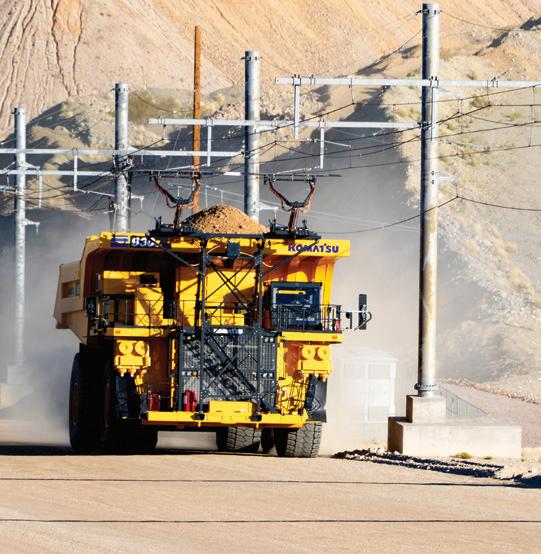
FastCharge or Eaton’s Green Motion EV chargers are aiming to solve this issue and there will be undoubtedly more high-tech innovation in this space soon. Remote sites with limited grid access will also need creative solutions including microgrids, hybrid systems, and modular charging stations to make electrification feasible. Cold-weather performance is another hurdle, particularly in northern regions where batteries may lose efficiency and require robust thermal management systems. That said, progress is being made on all fronts, with OEMs, utilities, and mining companies collaborating to overcome these barriers. Canada, with its history of innovation in underground mining and electrification, is playing a leading role in this transition. Companies based in mining hubs like Sudbury are leveraging their underground expertise to tackle the surface challenge. Among them is MacLean Engineering, a well-established OEM that has made significant inroads with battery electric solutions in underground environments. With the launch of its

new surface mining division, MacLean is extending its electrification know-how to open-pit operations, eventually offering a suite of purpose-built support vehicles and engineering solutions tailored for surface applications.
MacLean’s move into surface electrification reflects a broader industry trend: the recognition that decarbonization is not a luxury but a necessity. Drawing on decades of experience designing rugged, mine-ready vehicles, MacLean is well-positioned to support operators looking to electrify support fleets, from service trucks to water carts to personnel carriers. Their entry into this space is timely, offering mining companies a credible, Canadian-made alternative as they plan for a low-emissions future. As surface mines begin the long transition away from diesel, partnerships with experienced OEMs will be essential in making the shift efficient, safe, and economically viable.
The electrification of surface mining is no longer a theoretical aspiration; it is a practical strategy gaining real traction. With compelling benefits across cost, safety, environmental performance, and social license, the case is becoming clear. While technical and logistical hurdles persist, they are shrinking with every new deployment and demonstration project. Thanks to creative engineering and a strong commitment to innovation, Canada is helping to power the next phase of surface mining as a clean, quiet, and electric endeavour. The only question that remains is how fast operators are willing to make the leap.
Steve Gravel is the manager of the Centre for Smart Mining at


FROM DRILL TO DETONATION: Blasting smarter in surface mining

Advances in technology — artificial intelligence (AI), automation, digitalization, and electrification — are revolutionizing Canada’s mining industry. Blasting, an integral part of hard rock mining, has recently seen innovations that allow for explosives to be detonated remotely. Explosive companies that provide surface blasting for open-pit operations help mining companies to conduct more efficient and safe blasts which can result in reduced explosive costs, more ore, and increased revenue. Several global explosives companies work in partnership with mining companies to provide their signature blasting services.
BME Canada’s AXXIS Silver
With over 40 years of global experience in blasting and explosives, BME established BME Canada in 2019 — now operating from an office in Val Caron and a manufacturing plant at Nairn Centre in Ontario.
BME’s electronic detonator technology dates to 2010 with its initial introduction of the AXXIS GI, followed by the AXXIS GII in 2015. In 2021, BME launched AXXIS Silver — its new detonator technology which was specifically designed for quarries and small mining operations. Key features include advanced electronic initiation for accurate timing and sequencing, programmable delay intervals for optimal fragmentation, and remote monitoring and initiation capabilities.
AXXIS Silver is designed for up to 1,600 detonators per blast. The AXXIS Silver Logger communicates with each detonator to program it with the desired initiation time. The detonators are programmable at one-millisecond intervals up to 15 seconds, which allows for more complex blast designs. The ASIC technology delivers high accuracy of less than one millisecond at the maximum firing time for consistent quality blasting, resulting in better overall blast performance.
BME Canada’s value-added initiatives and blast optimization solutions include blast audit and assessments, predictive modelling for blast performance, blast simulation tools, blast impact and performance measurements, and integrated compliance tracking and reporting.
The benefits of the AXXIS Silver include ease of use for the operator; reduced downtime at firing stage; decreased ground vibrations and fly rock, thereby minimizing the impact on surrounding structures; improved blast fragmentation that enhances downstream processing efficiency; and increased safety through remote detonation and real-time monitoring.
BME Canada can help mining companies reduce their environmental impact by optimizing the entire blasting process from charge placement to detonation timing, ensuring regulatory compliance and improving operating costs and efficiency by minimizing explosive usage to gain maximum yield.
Tom Dermody, international technology & field services
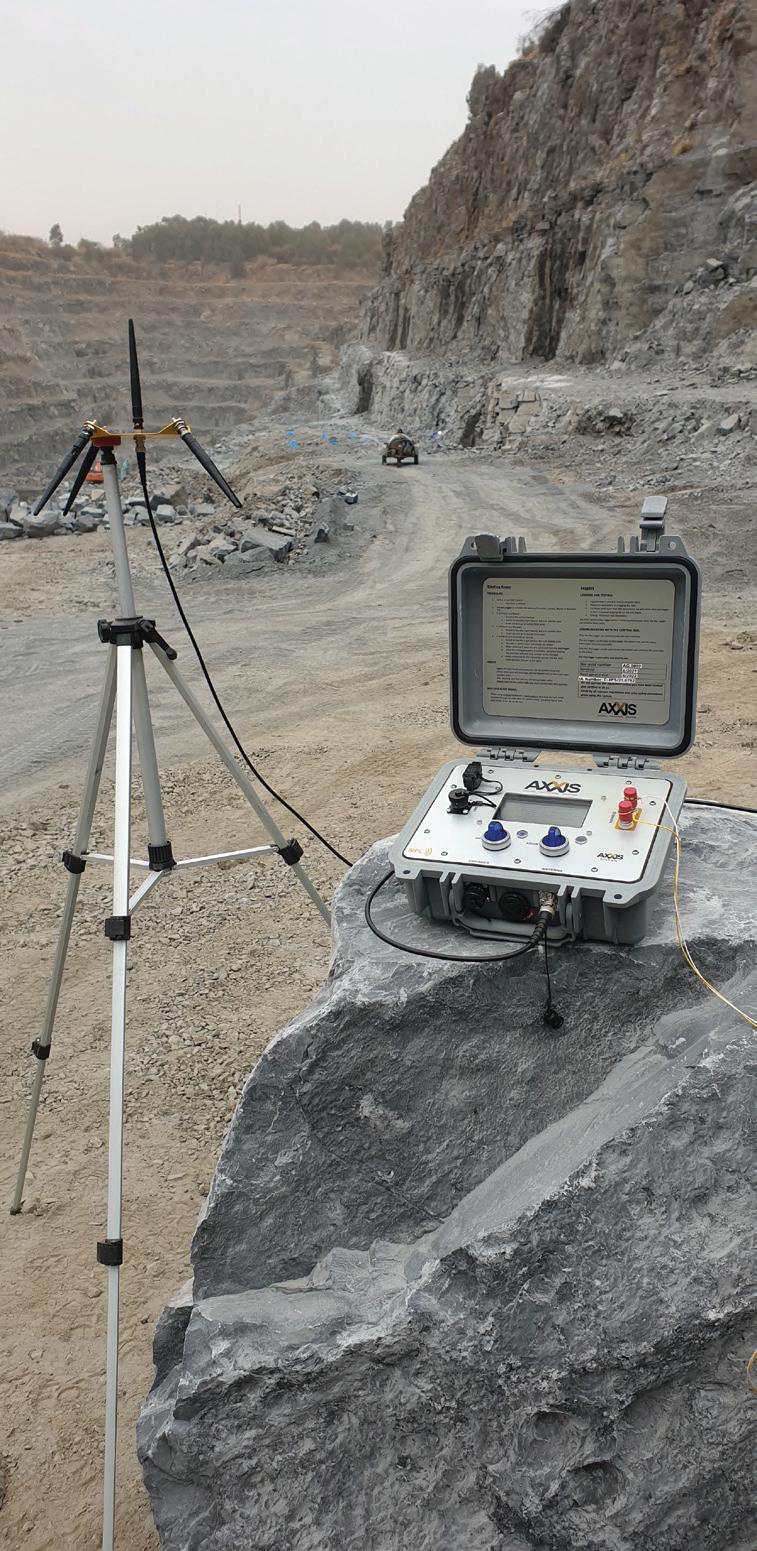
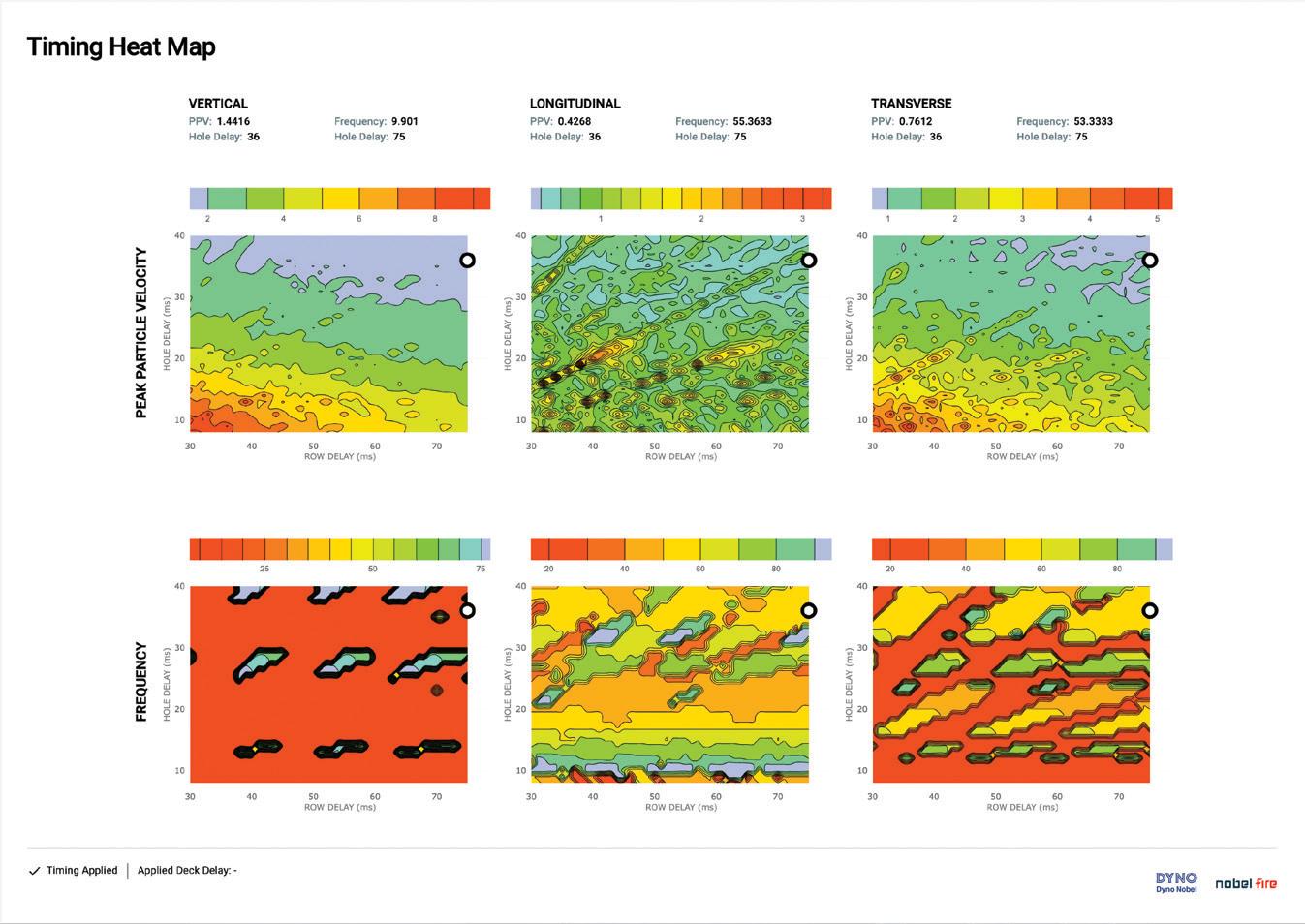
proven its success in various regions worldwide. This innovative approach not only simplifies the blasting process, but it also greatly enhances overall productivity and profitability in the mining sector.”
Dyno Nobel’s Nobel Fire
Dyno Nobel is a global leader in the commercial explosives industry with origins dating back to the 1860s. The company operates several magazine sites across Canada for the storage and distribution of explosives and blasting products.
manager at BME, says, ”We are excited to share how our AXXIS Silver electronic initiation system can truly make a difference for Canadian mines looking to enhance their operational efficiency and boost revenue. By leveraging advanced detonator technology, mines can achieve superior blast fragmentation, yielding high precision in each blast. Already, this system has
Nobel Fire is Dyno Nobel’s centralized data and blasting software platform. It connects with existing operations systems to store and analyze blasting data in one place. It enables blast design and analysis using some of the industry’s most powerful modeling tools:
• Advanced Vibration Prediction (AVP) is a blasting vibration prediction tool that accounts for variability in blasting for industry-leading accuracy.

• Vibration Timing Optimization (VTO) is a signature waveform convolution engine that helps identify blast timing pairs that help control vibration.
• Fracture Density Model (FDM) is a physics-based fragmentation modeling tool that works through an automated calibration process for extreme accuracy.
• Geological Element Movement (GEM) is a physics-based ore/waste dilution prediction model and heave modeling tool that predicts cast-blasting results.
The Nobel Fire mobile app integrates with delivery systems including EC200, EC300, and Universal Control System (UCS). Available on iOS and Android tablets, it allows users to add real-time drill and blast data to analyze and monitor the blasting process.
AXXIS Silver Hardware. CREDIT BME CANADA
Nobel Fire Modelling. CREDIT: DYNO NOBEL
Nobel Fire VTO Heatmap. CREDIT: DYNO NOBEL
DRILLING AND BLASTING

Nobel Fire generates comprehensive blast reports that meet regulatory requirements and provides post-blast analysis and dashboarding to assess trends in explosives usage and performance. Mining companies can compare designed blast parameters with actual blast results for analysis and optimization.
Nobel Fire supports the integration of existing models from industry-leading 3D tools and CAD programs for advanced blast design and analysis. In the future, users will be able to upload drone flight imagery to create photogrammetry models within the software.
Nobel Fire provides everything an operation needs to improve its blasting activities in one easy-to-use platform. Its tools offer industry-leading accuracy and allow for fine-tuning before blasts. Because the platform is designed for interoperability, Nobel Fire integrates seamlessly with existing digital ecosystems.
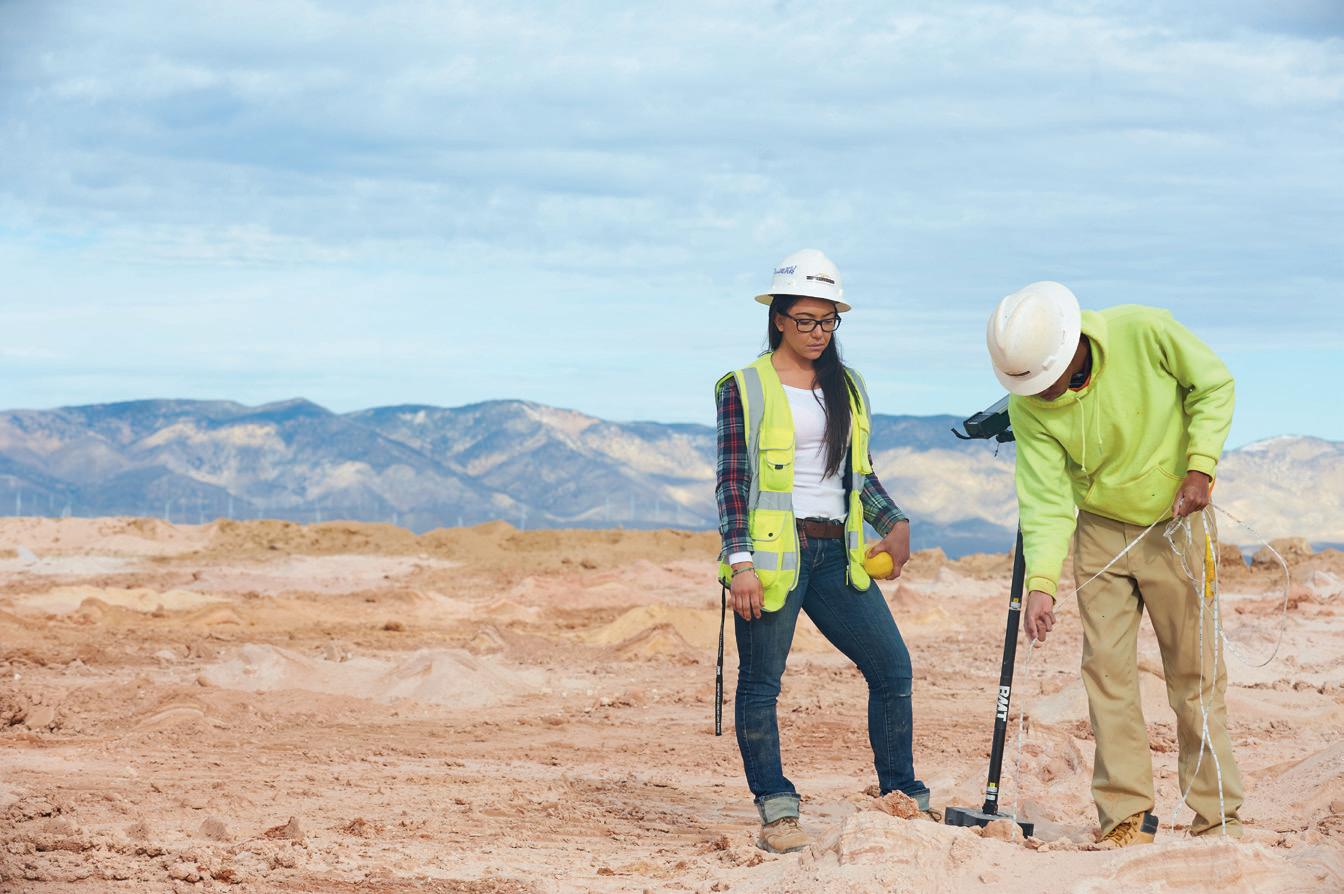
energy consumption, and explosives costs.
In a case study, Dyno Nobel’s DynoConsult team worked with a metal mine to safely and effectively blast near existing structures to free three million tonnes of ore worth $72 million.
Braden Lusk, Dyno Nobel’s chief technology and marketing officer, says, “Nobel Fire is the foundation for how we are rethinking the role of digital tools in blasting. It is built to grow with our customers by supporting smarter designs, seamless data integration, and better decision-making from the drill to the mill.”
Hexagon’s Drill & Blast
Since 1992, Hexagon has been a leader in digital reality solutions. The company’s Canadian presence includes divisions in Vancouver (mining), Calgary (autonomy and positioning), and Oakville (manufacturing intelligence).
Hexagon’s Drill & Blast (D&B) integrates software and hardware to help mines measure and improve the D&B process. Benefits can include reductions to emissions, material waste,
The platform ensures an effectively executed drillhole and blast design, accurately accounting for geology and geometry, machine-guided, high-precision drills, proven fragmentation analysis, and blast monitoring that minimizes loss and dilution.
Included is MinePlan Blast, a rapid design utility for creating and storing templates, completing bootleg analysis and creating safety exclusion zones for equipment and personnel based on actual terrain in a 3D environment.
To manage blast design and optimize fragmentation, Hexagon Split’s image processing technology measures particle-size distributions from mine to mill.
Hexagon’s autonomous drill control system, Drill Assist, applies AI to analyze downhole drilling conditions, resulting in precise drilling parameter adjustments while protecting the drill rig and associated consumables.
Hexagon’s Blast Movement Monitoring (BMM) provides accurate ore location information via Blast Movement Monitors. BMMs combine sensors and software to ensure that post blast,
Blast Movement Monitoring (BMM). CREDIT: HEXAGON
Drill Assist. CREDIT: HEXAGON
the mine knows where its orebody moved to. BMMs move with the blasted material, producing data that accurately reflects measured movement, resulting in redefined ore boundaries. Software calculates the post-blast 3D movement location of the ore polygons, outputting new dig lines. Production teams can dig in the precise location of the ore and waste, recovering all the planned resource and achieving the pits’ true value.
Hexagon’s Blast Movement Intelligence (BMI) is an AI-powered 3D solution that provides high visibility into ore dilution for informed ore and waste delineation post-blast. It produces an accurate block model of the muck pile and ultimately maximizes yield.
Hexagon’s partner, IDS GeoRadar, offers IBIS-FB, a remote sensing monitoring system based on microwave interferometry technology. IBIS-FB integrates standard vibration monitoring systems, delivering highly accurate remote broad area measurements of ground vibrations.
Jeff Loeb, senior director of new ventures at Hexagon, says, “As ore grades decline, mines are digging more earth for less ore. Improving ore recovery by just 1% can mean millions of dollars. Hexagon Drill & Blast addresses the small and com-
reliably and safely. This technology eliminates the need for downlines and surface connecting wires, significantly enhancing safety by removing people from hazardous areas. WebGen uses low-frequency magnetic waves to communicate with each primer, ensuring precise and controlled blasting operations.
WebGen offers many advantages for open-pit mines. It enhances flexibility in pit planning and mine scheduling, allowing for more efficient and adaptable operations. The system reduces misfire zones and eliminates firing window variability, ensuring precise and controlled blasting. By minimizing the impact of lightning production delays and eliminating the risk of lightning-induced explosion hazards in loaded blast holes, WebGen significantly reduces operational downtime.
Additionally, WebGen improves safety by reducing the interaction between heavy vehicles and initiating systems, lowering exposure to bench hazards. With WebGen, there is no tie-in process, no misfires from wire damage, and it reduces inventory, making operations more streamlined and cost-effective. The technology also increases blasted inventory, reduces the need for resources on the bench, and cuts down on stemming costs and backup practices.
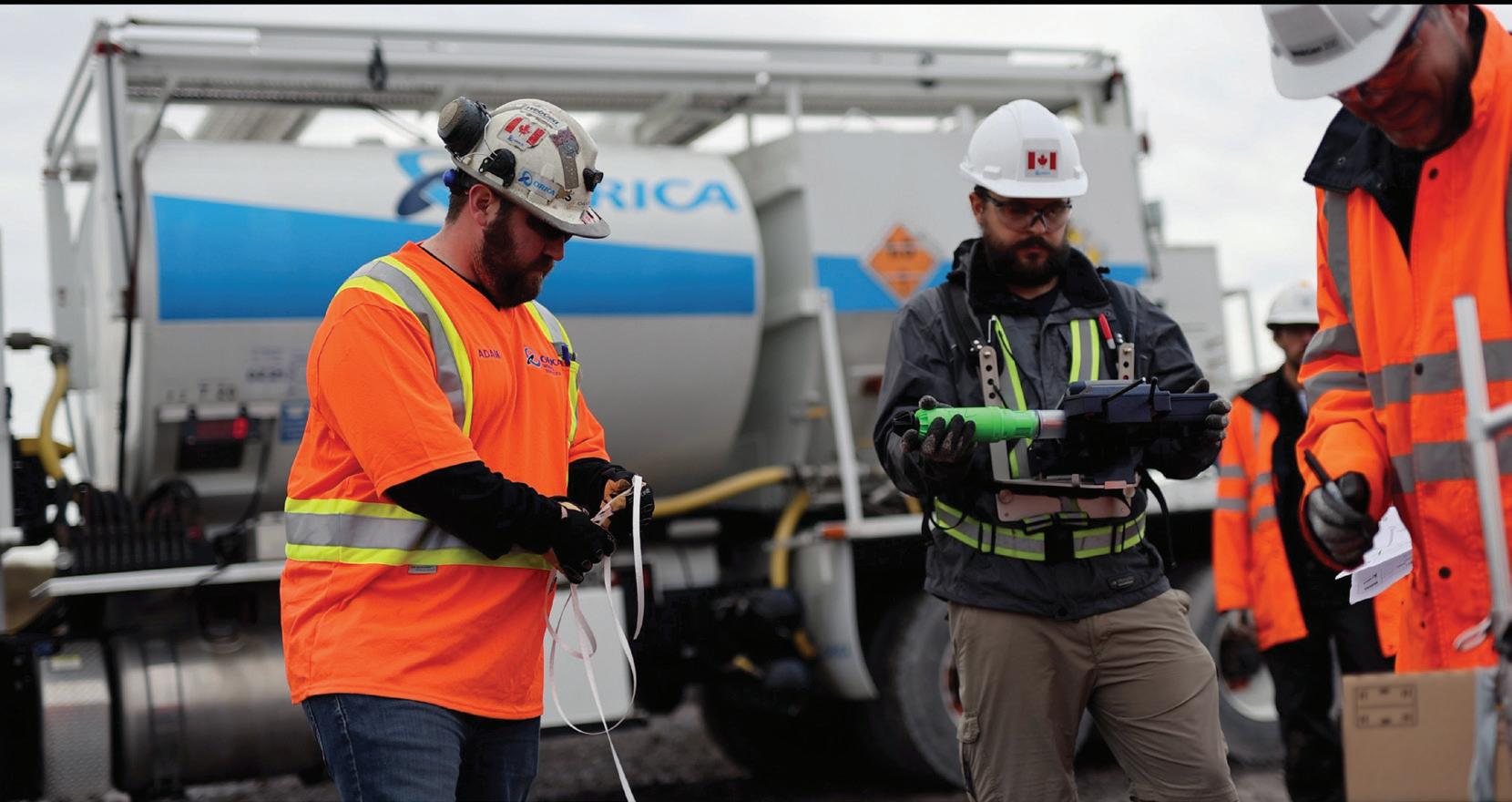
pounding errors that can lead to costly consequences. It empowers Canadian mining companies with a data-driven feedback loop, calibrated to increase profit from every blast through increased throughput, reduced energy consumption, and minimized ore loss.”
Orica’s WebGen
Orica, one of the world’s leading mining and infrastructure solutions providers, has been simplifying bench operations for mining companies for 150 years.
WebGen is Orica’s signature wireless initiating system. This innovative blasting technology allows new and better ways of mining to improve coal recovery in steeply dipping coal seams or increased vertical advance rates in hard rock. Operations are simplified and eliminate the need for downlines and surface connecting wires.
WebGen is the world’s first truly wireless initiating system, communicating through rock, air, and water to initiate blasts
In Canada, at the Musselwhite gold mine, the implementation of WebGen led to a 15% increase in ore recovery and a 10% reduction in blasting costs. The mine also reported improved safety conditions owing to the wireless initiation system. Similarly, at the Sierrita mine in Arizona, WebGen enabled the preloading of multiple benches during storm seasons, effectively mitigating lightning risks and improving operational efficiency. The wireless technology eliminated the need for extensive wiring, saving time and minimizing the risks associated with traditional wired systems.
Nigel Pereira, vice-president of commercialization, says, “WebGen has fundamentally changed the way blasting can be approached, offering new techniques and mining methods that were previously unimaginable. This system enhances safety by preventing accidental detonations from lightning strikes, eliminates possible interactions with surface connectors, and reduces exposure hours to hazardous areas such as under high walls.”
By leveraging these new advances in technology, Canadian mining companies can move toward a future where their mining operations are cleaner and more efficient while also reducing their explosives costs and increasing their ore production and revenue.
Diane L.M. Cook is a freelance mining writer.
WebGen 200: A.L. Blair Construction’s Moose Creek quarry (open pit). CREDIT: ORICA
ULTRA-LOW ZINC TECHNOLOGY:
REVOLUTIONIZING MINING EQUIPMENT PROTECTION
While zinc-based additives, often found in traditional transmission drive-train oils, have long been used to enhance performance, recent evolutions in the regulatory landscape for this technology have raised questions about its long-term function. As environmental and operational standards continue to evolve, regulatory bodies are pushing for lubricants with lower metal-based additive content to minimize ecological impact while still delivering uncompromised performance. In response to these changing regulatory requirements, nextgeneration ultra-low zinc lubricants with lower metal-based additive content are now emerging, offering a groundbreaking alternative that meets industry needs without the drawbacks of conventional formulations.
Caterpillar’s TO-4 specification has long served as the industry benchmark for lubricants used in heavy-duty mining equipment, ensuring optimal performance in transmissions, final drives, and hydraulic systems. While this specification has historically been met using conventional products, ultra-low zinc technology is now proving to not only meet the TO-4 specification but significantly outperform conventional lubricants in durability, efficiency, and environmental impact. The shift towards this next-generation formulation marks a major advancement in lubricant science, promising longer service intervals, improved wear protection, and enhanced sustainability.
THE EVOLUTION OF HIGH-PERFORMANCE LUBRICATION SYSTEMS
For mine managers, every operational decision impact productivity, safety, and profitability. Equipment downtime can translate to lost revenue, increased maintenance costs, and disruptions to tightly scheduled operations. Lubrication, therefore, is far more than just routine maintenance – it is a fundamental factor in maintaining peak fleet performance and ensuring the longevity and protection of high-value machinery.
Ultra-low zinc technology is redefining heavy-duty lubrication by leveraging polyphosphate film technology while eliminating the need for traditional zinc-based additives. Both traditional and next-generation anti-wear mechanisms involve the formation of polyphosphate films. In traditional systems, zinc atoms act as “carriers” that then disperse back into the fluid as the
polyphosphate film forms on metal surfaces. Next-generation fluids create a similar polyphosphate protective film without the need for the zinc carrier atoms.

This evolution in formulation is not merely theoretical; it has been rigorously validated through both bench and field testing. Ultra-low zinc technology has demonstrated clear advantages, including:
• Superior Wear Protection: Enhances the durability of gears, bearings, and hydraulic systems under extreme operational conditions.
• Improved Oxidation Resistance: Provides superior oil stability and component protection, even in high-humidity and extreme-temperature environments.
• Optimized Friction Control: Offers smoother, more consistent clutch and brake performance, reducing shudder and improving operator control.
The limitations of traditional zinc-based lubricants are becoming more apparent, particularly as the industry demands higher levels of efficiency and reliability. The Mining industry is under ever-increasing pressure to supply the global community with critical natural resources, and a higher level of efficiency and performance is now being demanded of their lubricants. Additionally, the metallic content of ZDDP complicates disposal
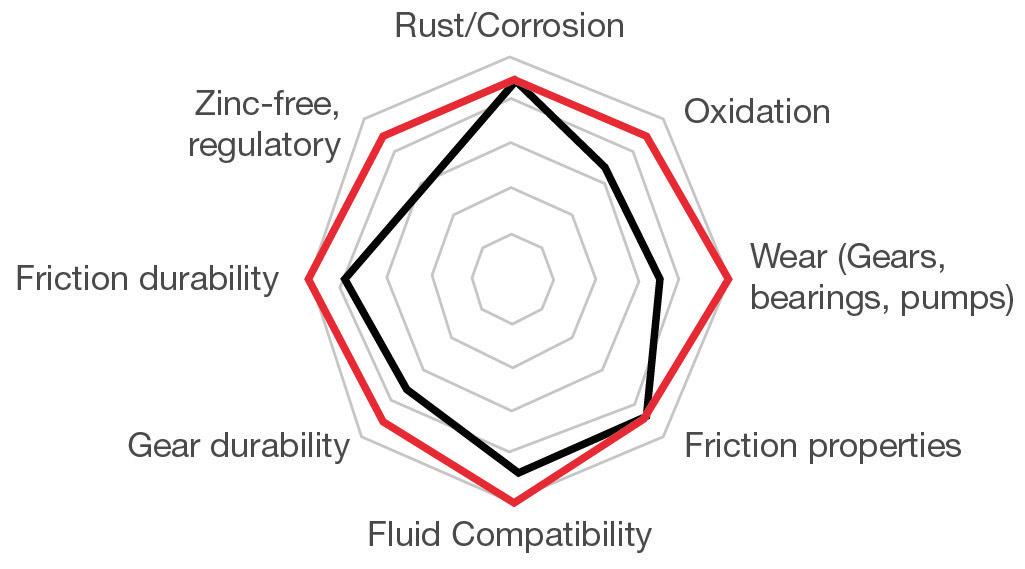


and contributes to ecological concerns, making ultra-low zinc an attractive alternative for companies looking to meet sustainability goals. Mining is a 24/7 operation with no room for unplanned downtime. Every piece of equipment is pushed to its limits, making the choice of lubricant a strategic investment in long-term productivity and profitability.
Resistance to Oxidation
Whether in industrial machinery, automotive transmissions, or heavy-duty mining equipment, gears operate under extreme loads. High performance lubricants can mean the difference between seamless performance and catastrophic breakdown, making the selection of the correct oil a strategic priority for mine operators.
Well-established testing methods continue to validate that nextgeneration formulations outperform traditional zinc-based chemistry in terms of wear resistance, friction durability and oxidation stability. One of the most reliable industry tests for assessing lubricant performance under extreme conditions is the D4998 FZG Test.
TEST?
The D4998 FZG Test is used to evaluate lubricants for gear wear protection. Conducted according to ASTM D4998, this test evaluates wear via gear weight loss at steady state test conditions (load, temperature, and speed).
Think of it as the ultimate stress test for lubricants. When using a specialized FZG test rig, lower wear values indicate that the fluid has performed better in terms of gear durability and protection.


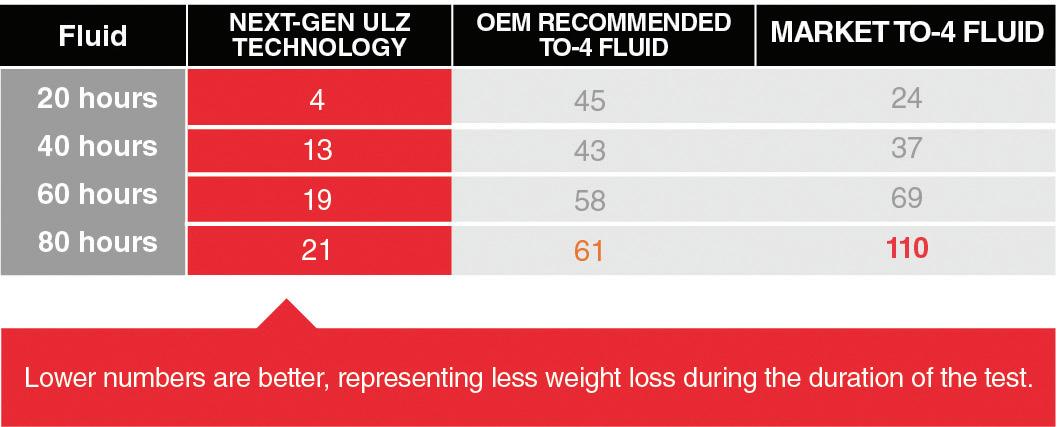
With the test duration now extended from 20 hours to 80 hours, with measurements taken at 20-hour intervals, the results were clear: next-generation ultra-low zinc technology significantly outperformed all benchmark fluids evaluated. After extended FZG Gear Wear testing, gear teeth treated with ultra-low zinc
Transmission Drive Train Oil remained in excellent condition, demonstrating superior wear resistance compared to legacy technology. The proof is undeniable – next-generation ultra-low zinc technology offers enhanced protection for critical gears under severe loads.
Ultra-low zinc technology is more than just a response to regulatory shifts – it is a transformative leap forward in lubrication science. As the mining industry continues to push the boundaries of efficiency, reliability, and sustainability, advanced lubricants play a crucial role in ensuring equipment longevity and reducing operational costs.
For mine managers seeking a competitive edge, ultra-low zinc technology presents a real opportunity to raise their game. And in an industry where every minute of uptime counts, the right lubricant isn’t just an operational necessity – it’s a strategic investment. Ultra-low zinc technology is on it’s way to redefine the standards of heavy-duty lubrication.
TOMORROW STARTS TODAY... ARE YOU READY?
Extended D4998 FZG test duration
Extended D4998 FZG pictures: Zoomed in Tooth Wear
Breaking new ground:
Electrification, automation, and digitalization of
mining drills
The relentless pursuit of greater efficiency, enhanced safety protocols, and a reduced environmental footprint is necessitating a profound transformation within the mining industry. At the forefront of this evolution lies the modernization of mining equipment, particularly drill rigs, through the integration of advanced technologies. Electrification, automation, and digitalization are no longer distant aspirations but tangible realities reshaping drilling operations, promising significant impacts on operational expenditures, overall productivity, ecological responsibility, and the well-being of the workforce.
One of the most significant shifts underway is the industry’s move away from traditional diesel-powered machinery towards electric alternatives. This transition is propelled by several factors, including increasingly stringent environmental regulations aimed at curbing emissions, a growing ethical imperative for sustainable practices, and the compelling prospect of long-term cost advantages.
Electric drill rigs present a compelling value proposition compared to their diesel counterparts. Their most obvious advantage lies in the elimination of exhaust emissions at the point


of operation, contributing to a cleaner and healthier working environment for operators. Furthermore, the inherent simplicity of electric motors translates to reduced mechanical wear and tear, leading to less frequent maintenance schedules and a corresponding extension in the operational lifespan of the equipment. This increased uptime directly contributes to enhanced productivity. Economically, electric power often proves to be a more stable and ultimately less expensive energy source than diesel fuel, promising substantial cost savings over the long term.
Recognizing this paradigm shift, companies like Sandvik are actively deploying electric drill rig solutions tailored to meet these evolving demands. It is estimated that electric-powered drills currently constitute 15% to 20% of global sales for the surface drilling market, a figure projected to reach the 30% mark soon. Sandvik’s commitment to this electric future is evident in the launch of its electrically powered iSeries rigs, including models like the DR416iE, and the subsequent expansion of this fleet to include the DR413iE, DR412iE, DR411iE, and DR410iE.
The rapid integration of automation technologies into mining operations is complementing the electrification trend. Automated drill rigs offer a powerful means of mitigating the inherent risks associated with manual drilling tasks, significantly enhancing worker safety by reducing or eliminating human intervention in potentially hazardous zones. Beyond safety, automation also unlocks substantial gains in efficiency and productivity. Through continuous, around-the-clock operation and the optimization of drilling parameters, autonomous systems can consistently outperform manual operations.
Sandvik has positioned itself as a frontrunner in the realm of automated drilling solutions. Their iSeries drill rigs are equipped with advanced features such as onboard automation features and remote operation capabilities. These functionalities not only bolster safety by removing personnel from the immediate drilling environment but also enhance efficiency by minimizing downtime associated with manual interventions and ensuring optimal drilling performance. With a strong focus on data analytics and automation, iSeries drills empower mining operations with a crucial competitive edge by driving more informed decision-making, streamlining operational workflows, and ultimately boosting productivity.
Central to Sandvik’s automated drilling capabilities is the DRi operating system. Built upon Sandvik’s Intelligent Control System Architecture (SICA), the DRi platform offers several key advantages: a unified platform that streamlines maintenance, updates, and troubleshooting across all iSeries drills; enhanced automation capabilities, providing a robust foundation for advanced functionalities like fully autonomous drilling; a strong
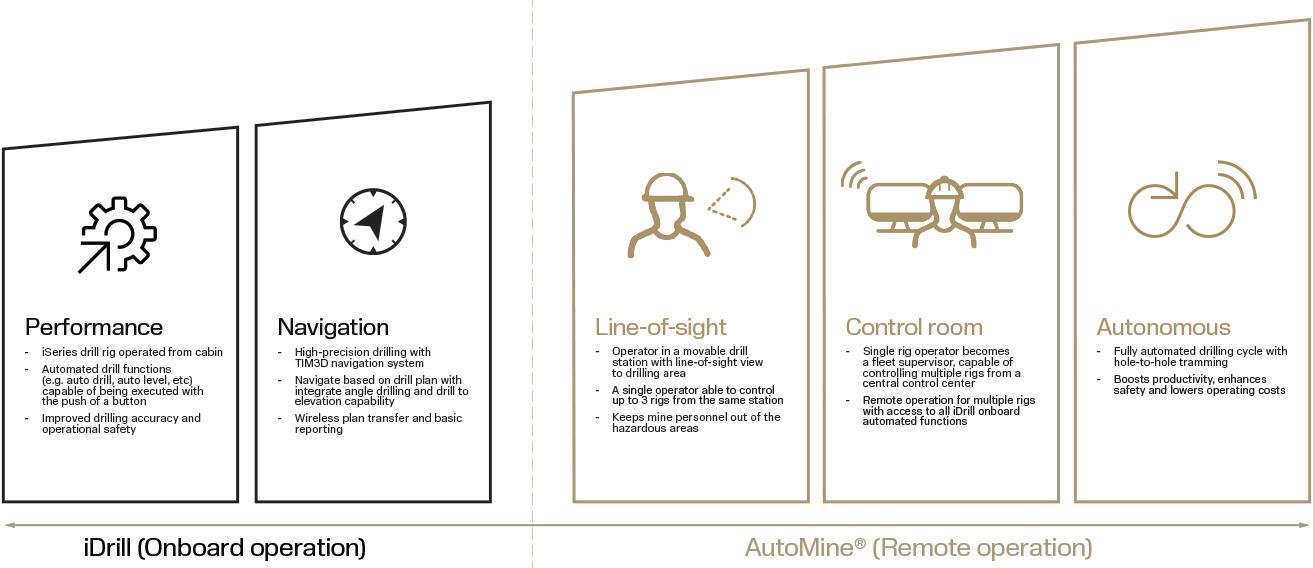
focus on digitalization, facilitating comprehensive data collection, storage, and analysis for optimized operational insights; seamless integration with other mining systems, enabling a holistic view of the entire mining ecosystem; and an open architecture that supports integration with third-party software and hardware. This common development platform accelerates the rollout of product improvements across the entire iSeries rotary solution portfolio. DRi empowers operators with real-time data access, while also simplifying operator training through a consistent control system interface across all iSeries drill models.
platform.
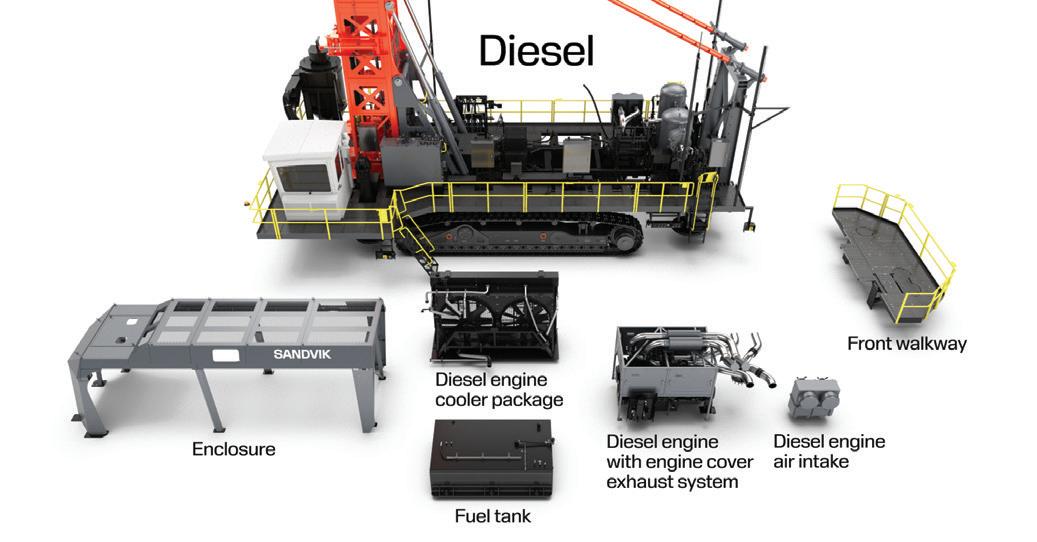
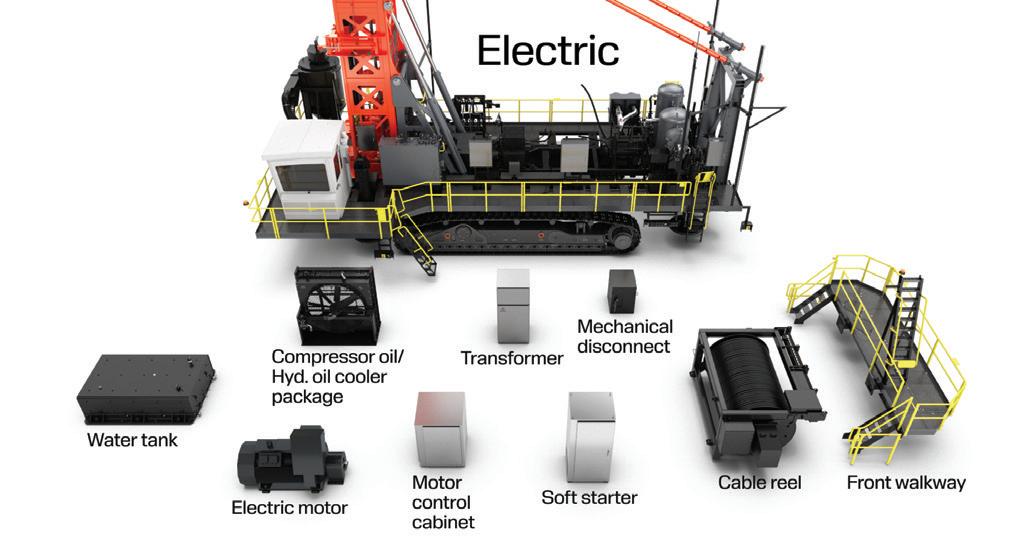
Another characteristic of modern drill rig design is the adoption of modularity. Sandvik’s modular approach offers significant benefits in terms of flexibility, maintainability, and long-term sustainability. Modular rigs can be readily customized and upgraded, allowing mining operations to adapt their equipment to evolving site conditions and operational requirements. Maintenance and repair are simplified as individual components can be quickly replaced or serviced, minimizing
overall downtime. Modular design also plays a crucial role in facilitating the transition towards electric-powered equipment. Sandvik emphasizes that their new modular designs are specifically engineered to ease the shift from traditional diesel to electric rotary blast hole drills, promoting a more sustainable future for the industry. This modularity allows for the easier integration of electric power units and provides a flexible framework for future electric drill rig development.
The intelligent utilization of data is crucial in optimizing drilling operations. Sandvik’s solutions underscore this principle, characterized by My Sandvik Onsite. Built upon Sandvik’s OptiMine technology, My Sandvik Onsite leverages time-stamped data to generate detailed reports on equipment utilization, operational status, productivity levels, and overall equipment health. The insights derived from this data can be used to refine drilling parameters, enhance operator training programs, and optimize mine planning strategies, leading to significant improvements in both productivity and profitability.
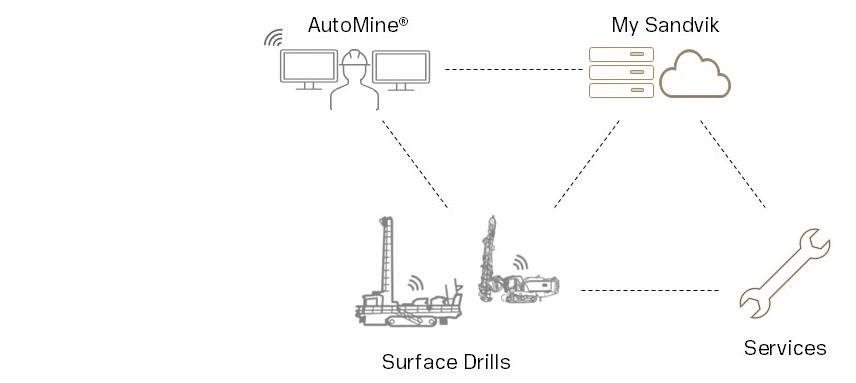
The convergence of electrification, automation, and digitalization is not merely a trend but a fundamental shift reshaping the future of drilling in the mining industry. These technological advancements are driving a holistic transformation, enabling mining companies to achieve greater operational efficiency, minimize their environmental impact, and foster more sustainable practices. As the mining industry continues to navigate evolving demands and increasing societal expectations, these technological innovations will undoubtedly play an increasingly critical role in ensuring a sustainable and efficient path forward.
Nellaiappan Subbiah is the global product manager, rotary drills, at Sandvik.
Sandvik rotary drill rig diesel modular
Sandvik rotary drill rig electric modular platform.
Sandvik digital solutions.
Sandvik rotary drill rig scalable automation offering.
Optimizing development drilling at Haile gold mine
At Haile gold mine in South Carolina, OceanaGold is transitioning from surface to underground mining — a shift that brings new challenges in training, workflow, and technology adoption. Haile is the only active gold mine east of the Mississippi River, and notably, 85% of the workforce is drawn from the surrounding region. While this community-first model strengthens ties to the area, it also presents a unique challenge: South Carolina does not have a long history of underground hard rock mining. That means upskilling is essential — not only to ensure productivity but also to guarantee safety and long-term success underground.
To support this transition, Hexagon partnered with OceanaGold to trial and implement the Development Optimizer system, a technology designed to improve drilling precision to reduce overbreak, underbreak, and face dishing in underground development.
The challenge
Development drilling is the foundation of all underground advancements. Operators must drill a precise pattern of blast holes to create a tunnel of specific shape and size. Deviations, whether too wide (overbreak) or too narrow (underbreak), can increase cycle times, require rework, and increase costs.
This challenge is especially pronounced in manual drilling environments, where success is heavily reliant on operator skill and training. Without consistent guidance, even experienced crews can struggle with repeatability. Inherently complex underground conditions amplify these challenges, often leading to inaccurate and inconsistent drilling. The result is poor blasting outcomes, unplanned overbreak, face dishing, and reduced advance — all of which slow development, increase haulage volumes, and inflate costs. The net effect is a lower net present value for asset owners and tighter margins for contractors.
At Haile, these issues were already surfacing. Overbreak rates averaged 16.9% prior to the trial — well above the ideal target of under 10%. Operators were using analog Sandvik DD421 and DD422i jumbos in a “bolt-bore” configuration, meaning the same rig is used for drilling, bolting, and scaling. This multi-purpose use supports flexibility and capital efficiency, but prevents the use of fixed onboard navigation sensors, which can be damaged during bolting.
Without digital guidance, drill alignment relied heavily on manual processes and operator judgment — introducing variability and reducing repeatability.

The solution: Development Optimizer System
Hexagon’s Development Optimizer is an OEM-agnostic alignment system that equips each boom with a removable, wireless sensor called the “Optibox.” Paired with a ruggedized tablet and Hexagon’s CORE Web platform, the system provides real-time alignment feedback and shift-to-shift drill performance insights. It enables operators of all experience levels to drill accurately to design — delivering more consistent blast outcomes for every cut. The result is improved fragmentation, reduced overbreak, and increased rate of advance. Importantly, it is designed to support the operational realities of bolt-bore rigs, with sensors removed prior to bolting to prevent damage.
Trial scope and results
At Haile, a structured three-week trial was conducted in late 2024 using a dedicated Sandvik DD421 jumbo. Six operators participated, each receiving in-cab coaching and working through a standardized competency checklist. Haile’s engineering team surveyed each development cut post-blast to measure overbreak and assess profile accuracy.
The following results were compelling:
• Overbreak was reduced by 35.6%, from 16.9% to 10.8%.
• Drill alignment improved, with operators consistently staying within tolerance.
• Rework and re-drills were reduced, while scaling and bolting became more predictable.
Quantifying the impact
One way to ground these improvements is in material movement. Across Haile’s three-jumbo fleet, approximately 12,000 development cuts are planned annually. By reducing overbreak from 16.9% to 10.8%, the site avoids an estimated 2,973 tonnes of excess material over the course of a year, representing roughly 225 fewer loader buckets moved annually. It is a small change in percentage but a meaningful operational impact. Less waste means reduced fuel consumption, fewer haulage cycles, and more available equipment time, resulting in faster, more efficient development overall.
Without digital guidance, drill alignment relies on manual processes and operator judgment. This can introduce variability and reduce repeatability.
CREDIT: HEXAGON
Implementation and adoption
Following the trial, Haile expanded Development Optimizer across its full fleet of three jumbos. The rollout followed a hands-on training model. Hexagon’s team returned to site, spending three to five in-cab sessions with each operator. This hightouch approach prioritized face-to-face coaching over remote support, and each operator worked through a structured competency checklist to ensure confident, independent system use.
Adoption, in this context, goes beyond installation — it is about embedding the tool into daily operations until it becomes second nature.
That shift was already beginning to show underground, as is obvious from the following quotes from jumbo operators:
“I like that it stays aligned with your backsights, so I do not have to get out of the cab to make sure my booms are facing the right direction.”
“It saves time marking up when you only need one backsight. It is very useful for making sure the perimeter holes are parallel.”
“I am impressed with the precision of the sensor — after drilling a tight burn, none of the holes intersected.”
These early indicators of operator trust suggest that the system is beginning to take root. When drillers use it without prompting it and engineers begin integrating the data into planning workflows, true adoption is underway.
As with any operational change, it takes time, but the foundations at Haile are firmly in place.
Expanding the approach: Production Optimizer
While the Development Optimizer system focused on improving accuracy and repeatability during lateral advance, Haile has also taken steps to improve production drilling.
In 2024, OceanaGold implemented Production Optimizer, Hexagon’s sister solution designed for longhole drilling. The system uses a similar alignment and feedback model, tailored specifically for open stoping applications. By providing drillers with real-time collar accuracy at each hole, Production Optimizer supports tighter drilling, reduced dilution, and improved stope shape, delivering downstream benefits to fragmentation, recovery, and mill performance.
The goal is simple: straighter holes, better stope shapes, and less dilution. Improved drilling precision upstream translates

Successful development drilling depends on operators drilling a precise pattern of blast holes to create a tunnel of specific shape and size.
CREDIT: HEXAGON
Deviations from the drilling pattern — whether too wide (overbreak) or too narrow (underbreak) — can increase cycle times, requiring rework and increased costs.
CREDIT: HEXAGON
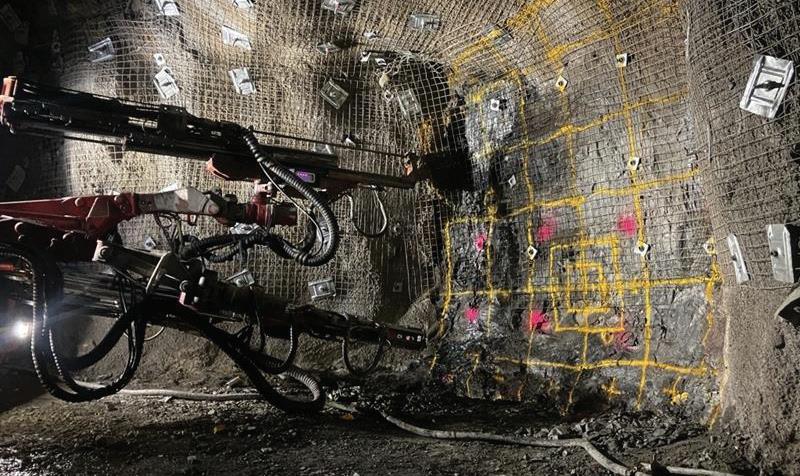
into stronger fragmentation, cleaner recovery, and more predictable mill feed downstream.
Together, Development Optimizer and Production Optimizer represent a unified, system-agnostic approach to underground drilling optimization. With both systems now deployed at Haile, the site is building a digital drilling foundation — one that enhances precision, reduces rework, and supports smarter decision-making across the mine’s full development and production cycle.
Technology adoption: Lessons in change management
At Haile, adoption is still work in progress. Operator feedback has been strong, and early wins have helped build momentum, but long-term change takes time, especially in dynamic, high-turnover environments. Hexagon continues to support the site through follow-up training, product updates, and periodic on-site engagement to help embed the system into the daily development workflow.
The following lessons have emerged from this process:
• Start with buy-in: Not every operator sees the value on day one. It took one-on-one coaching and multiple in-cab sessions to build understanding of how the system supports both individual performance and the bigger operational picture.
• Build confidence through support: Real-time guidance, structured training, and a clear sign-off process gave operators the tools and confidence to trust the system and use it effectively.
• Enable long-term success: Technology alone is not enough — sustained adoption requires alignment between operators, engineers, and site leadership. When all three groups are engaged, the system becomes more than a tool — it becomes part of the culture.
Looking ahead
Following the trial, OceanaGold expanded Development Optimizer across all three jumbos at Haile. As underground mining projects in North America look to improve efficiency, reduce rework, and strengthen safety outcomes, the approach at Haile offers a strong example of how technology — paired with training and process change — can modernize drilling practices without overhauling entire fleets.
For Hexagon, this is just the beginning. New developments in automation, planning integration, and alignment analytics are already underway. But as the team emphasizes, precision starts at the collar — and the path to better mining begins with better drilling.
Garrett Doll is the team lead of underground services & support at Hexagon’s Mining Division.

Blasting into the future of mining
The global mining industry is at a turning point. Confronted by declining ore grades, rising operational costs, and a growing talent shortage, mine operators are under increasing pressure to rethink how they extract and process minerals. At the same time, demand for mineral resources is outpacing supply, fueled by global electrification, renewable energy technologies, and expanding urban infrastructure. The result: stagnant productivity and profit margins under constant pressure.
While automation and artificial intelligence (AI) have transformed many aspects of modern mining, one critical process remains largely outdated — drilling and blasting. This essential step still depends on static designs, fragmented systems, and informal, experience-based decision-making. The consequences of suboptimal blasting are well-known: poor fragmentation, excess fines, increased energy consumption, higher dilution, and elevated processing costs. In short, ineffective blasting drives up costs, reduces revenue, and slows down production.
Watoga Technologies, a Canadian mining-tech startup, is directly addressing this challenge. Their flagship platform, RockHound, acts as the digital brain of the modern mine — a centralized AI-driven system that optimizes blasting operations and the downstream processes.
Reimagining blasting with RockHound
RockHound is not merely a digital blast design tool; it is a data-integrated, predictive analytics platform developed by mining professionals with deep domain expertise. Leveraging geology models, drill and blast data, explosive characteristics, and real-time feedback from downstream operations, RockHound enables data-informed decision-making at every stage of the blasting process. It provides granular insight into in-situ rock conditions, prescribes optimized blast designs tailored to variable geology, and models the downstream impacts on material handling, comminution efficiency, and overall plant performance.
The core vision is simple: Blast smarter, process faster, and extract more. Key features include the following:
• Predictive blast optimization: RockHound uses machine learning (ML) models to forecast the geological and structural conditions of the bench before the first hole is drilled. The system then recommends optimal design, charges, and delay timings based on fragmentation targets, crusher constraints, or dilution thresholds.
• Mine-to-mill integration: The software does not stop at the blast. It correlates blast outcomes with crusher throughput, mill energy usage, and recovery metrics. This closes the loop and allows future blasts to be continuously refined.
• Data-agnostic architecture: It can integrate with a wide range of sensors, software, and file types, including PDFs, Excel spreadsheets, and paper logs using optical character recognition (OCR). It centralizes fragmented datasets into one live, actionable dashboard.
• Vendor-neutral ecosystem: Unlike traditional solutions tied to specific explosives manufacturers or drill rigs, the platform is designed to work with any hardware provider, making it easy to implement in diverse operational environments.
• Reconciliation: It simplifies the creation of reconciliation reports by leveraging its easily navigable data architecture and centralized database, offering users flexible export options to support accurate, efficient, and transparent reporting workflows.
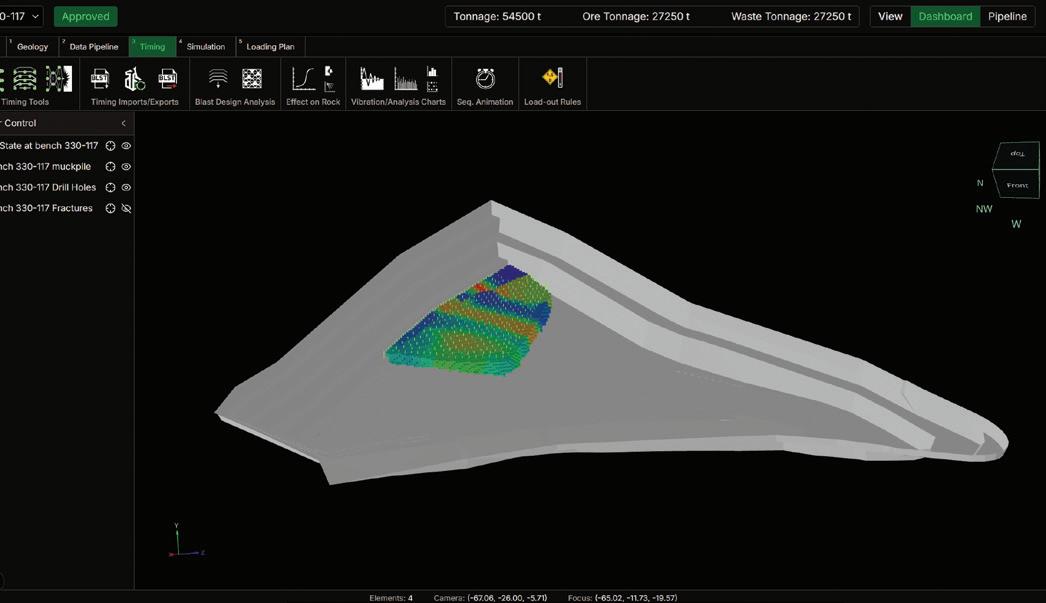
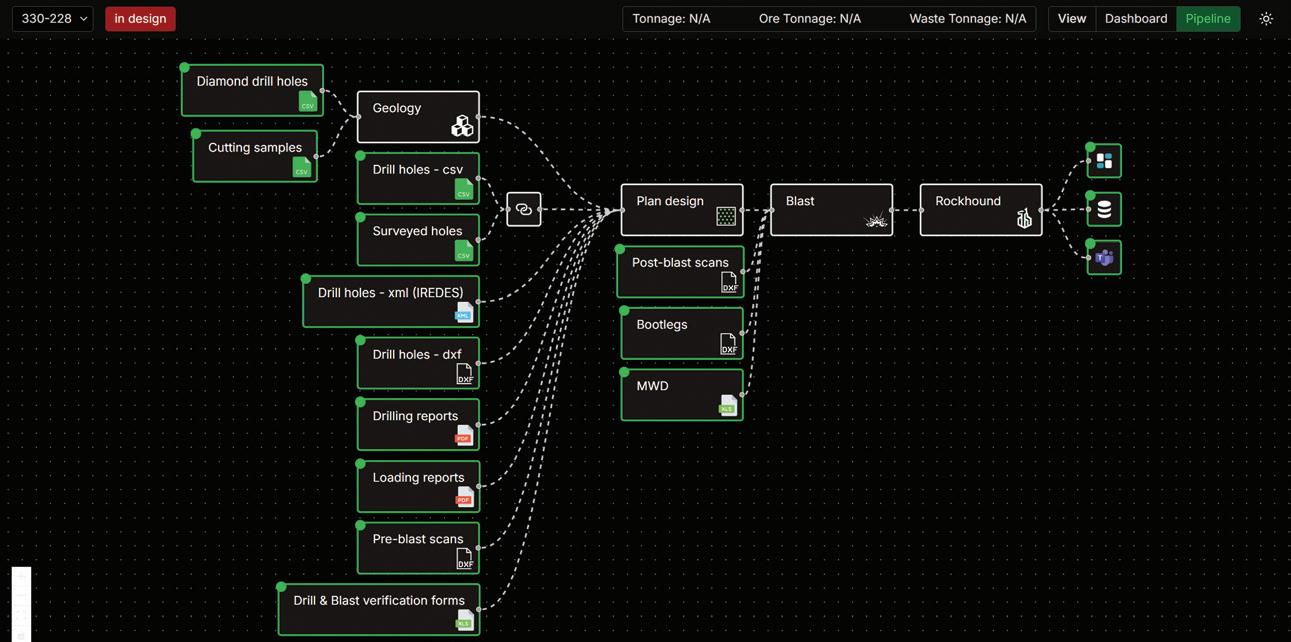
The result is a platform that not only optimizes blasting, but it also transforms it into a predictable, repeatable, and continuously improving process.
Born in the mine, built by miners
The story begins not in a corporate boardroom, but in the classrooms and research labs of McGill University. It was there that three students — Elliot Forcier-Poirier, Samuel Desjardins, and Roko Baljak — crossed paths during their studies in mining engineering, computer science, and applied mathematics. Driven by a shared frustration with the shortcomings of existing blasting technologies, they combined their technical expertise to explore a better way forward. Informed by interviews with over 200 mining professionals, their early prototypes evolved into a robust solution that is now attracting significant attention and adoption across the mining industry.
Just one year later, their startup, Watoga Technologies, has grown to six full-time employees and completed a successful funding round in El Segundo, California — a growing hub for military, agricultural, and mining technology startups alongside players like Durin and Metionic.
Pilots across the globe: Multi-commodity, multi-method
RockHound is poised for significant field deployment, with six pilot projects currently underway in partnership with mining operations across two continents, encompassing both open-pit and underground operations. Project sites include some of the world’s highest-tonnage copper producers, as well as emerging operations targeting critical and precious minerals such as lithium, gold, silver, nickel, and tungsten.
This operational diversity highlights the software’s capability to adapt to varied mining settings, orebody characteristics, and methods. Whether the objective is optimizing fragmentation to accelerate mucking in large-scale open pits or reducing overbreak in narrow-vein underground stopes, the data-integrated platform dynamically tailors blast designs to site-specific conditions and operational goals.
Critically, these pilot deployments not only validate the platform’s technical versatility and scalability, but also underscore a broader industry shift toward AI-driven blasting optimization — signaling increasing confidence in intelligent, data-centric approaches to mine-to-mill integration.
The
competitive edge: A new breed of mining software
While many companies are racing to capitalize on the promise of digital mining, few approach it with the clarity and operational focus of Watoga Technologies. Unlike most mining tech startups — often led by outsider talents with limited field experience — Watoga was founded by insiders who understand the complex realities of mining operations.
This firsthand perspective enables Watoga to prioritize what truly matters on-site: robust data interoperability, real-time system responsiveness, and seamless alignment with the workflows of mine engineers and blasting crews.
Critically, RockHound’s open architecture and integration-friendly design have drawn interest from major players across the mining ecosystem, including major equipment manufacturers, explosive suppliers, and mining software providers. These stakeholders have expressed a willingness to connect their data streams to the RockHound platform — an uncommon level of engagement for an early-stage software platform, and a strong vote of confidence in both the technology and the team behind it.
The future is intelligent, integrated, and automated
The mining industry is steadily evolving toward a model where AI, automation, and human expertise work in tandem. In this context, tools like RockHound represent a significant step forward — not as a replacement for engineering judgment, but as an augmentation of it. By providing real-time data, predictive insights, and powerful simulation capabilities, the software supports more informed and consistent decision-making in blasting operations.
Blasting, historically seen as a blend of experience and intuition, is increasingly being redefined as a controlled, data-driven process. With advanced tools, mine operators can reduce variability, improve fragmentation outcomes, and achieve measurable efficiencies and savings across the production cycle.
As pilot programs progress and additional deployments are launched, early results will help clarify the role of AI-assisted blasting in broader mine-to-mill optimization. This software is not just a tool; it is a leap forward in this shifting mining landscape.
The right tool at the right time
As the mining industry faces mounting pressure from declining ore grades, rising costs, and escalating demand for critical minerals, the companies that will lead are those capable of optimizing every stage of the value chain. This software enters the field at a pivotal moment, offering tools to improve one of mining’s most fundamental — and often under-optimized — processes: blasting.
Built by industry experts and powered by a modern, scalable technology stack, RockHound has demonstrated adaptability across a range of commodities, geologies, and mining methods on multiple continents. It has the potential for wide-scale adoption as mines seek smarter, more integrated operational systems.
In a sector undergoing digital transformation, this new phase of innovation starts at the blast face.
Real-time data pipeline. CREDIT: WATOGA
The mining of tomorrow is here now: Advanced sample scanning enhances human expertise
Geoscience is entering a new era. As the demand for resources grows and the pace of decision-making accelerates, the ability to quickly and accurately understand rock and minerals with altered characteristics is becoming more critical. Traditional visual identification methods are giving way to advanced technologies that offer deeper insights and greater precision. At the forefront of this transformation are sensors with their advanced sample scanning systems: a powerful approach that enhances data quality, accelerates workflows, and empowers geologists to make more confident, informed decisions. Rather than replacing human expertise, it amplifies it, laying the foundation for a smarter, faster, and more sustainable future in geoscience.
The mining of tomorrow is not on the horizon; it is already here.
Visual observation has long been a cornerstone of geological work, but it has limits. Even the most experienced geologists can struggle to distinguish fine or complex mineral signatures with the naked eye. Sample scanning technologies, such as advanced X-ray fluorescence (XRF) and hyperspectral spectroscopy (HS), close this gap. These tools deliver fast, consistent, and high-resolution data on a rock’s geochemistry, mineralogy, and physical properties — details that traditional methods often miss. Scanning reveals a deeper, more accurate picture of the materials driving modern mining by detecting trace elements invisible to human perception. Trace element geochemistry is a prime example: advanced scanning exposes critical insights about metal and mineral content that visual inspection simply cannot.
Sample scanning technologies do more than enhance observation; they redefine how geological data is analyzed, interpreted, and applied. These tools do not just improve immediate analysis; they accelerate automation and power the development of predictive models. With faster, richer data, geologists can move from static observations to real-time insights, navigating complex datasets and adapting strategies on the fly. What once took weeks can now happen in hours, streamlining decisions across the mining value chain, from exploration to production.
The power of scanning lies not only in the data it captures

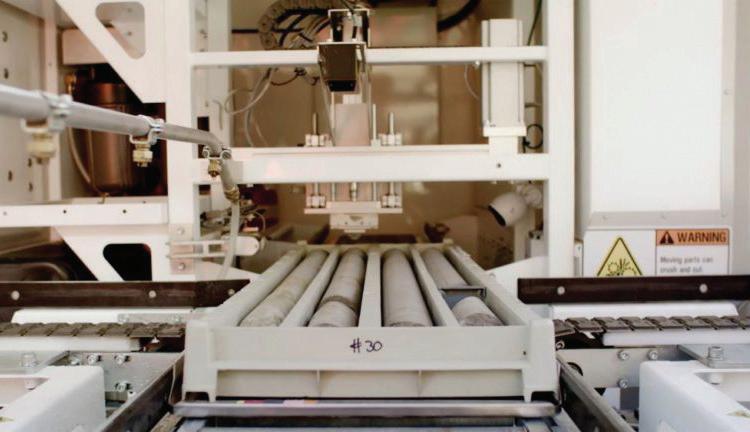
but also in how that data fuels smarter decisions. By unlocking high-resolution insights into mineralogy and geochemistry, scanning empowers teams to validate models, refine targets, and reduce geological uncertainty. This precision drives efficiency, cutting down unnecessary drilling, minimizing waste, and increasing confidence at every stage of a project. In an industry where margins are tight and timelines matter, better data is not a luxury; it is a competitive edge.
These technologies are not here to replace geologists; they are built to work with them. Scanning amplifies human expertise by expanding the volume, precision, and immediacy of data available for interpretation. It accelerates decision making and empowers exploration geologists, geotechnical engineers, and metallurgists with richer datasets, enabling higher-quality analysis and more confident calls. In this new era, real-time data is not just helpful; it is transformative.
The closer the data is captured to the drill, the faster teams can adapt. Real-time scanning cuts wasted steps, streamlines workflows, and puts insight directly where it is needed. How geologists assess and act on drilling-derived data is now central to unlocking critical mineral deposits and advancing the discoveries that matter most.
The mining of tomorrow is not on the horizon; it is already here. Sample scanning is redefining how we explore, evaluate, and extract. It is not a replacement for geological expertise; it is a force multiplier. The future of mining belongs to those who blend human insight with real-time intelligence, and we are building the technologies to make that future real.
Lori Martin is vice-president of global commercial at Veracio.
TruScan provides fast, accurate results. CREDIT: VERACIO




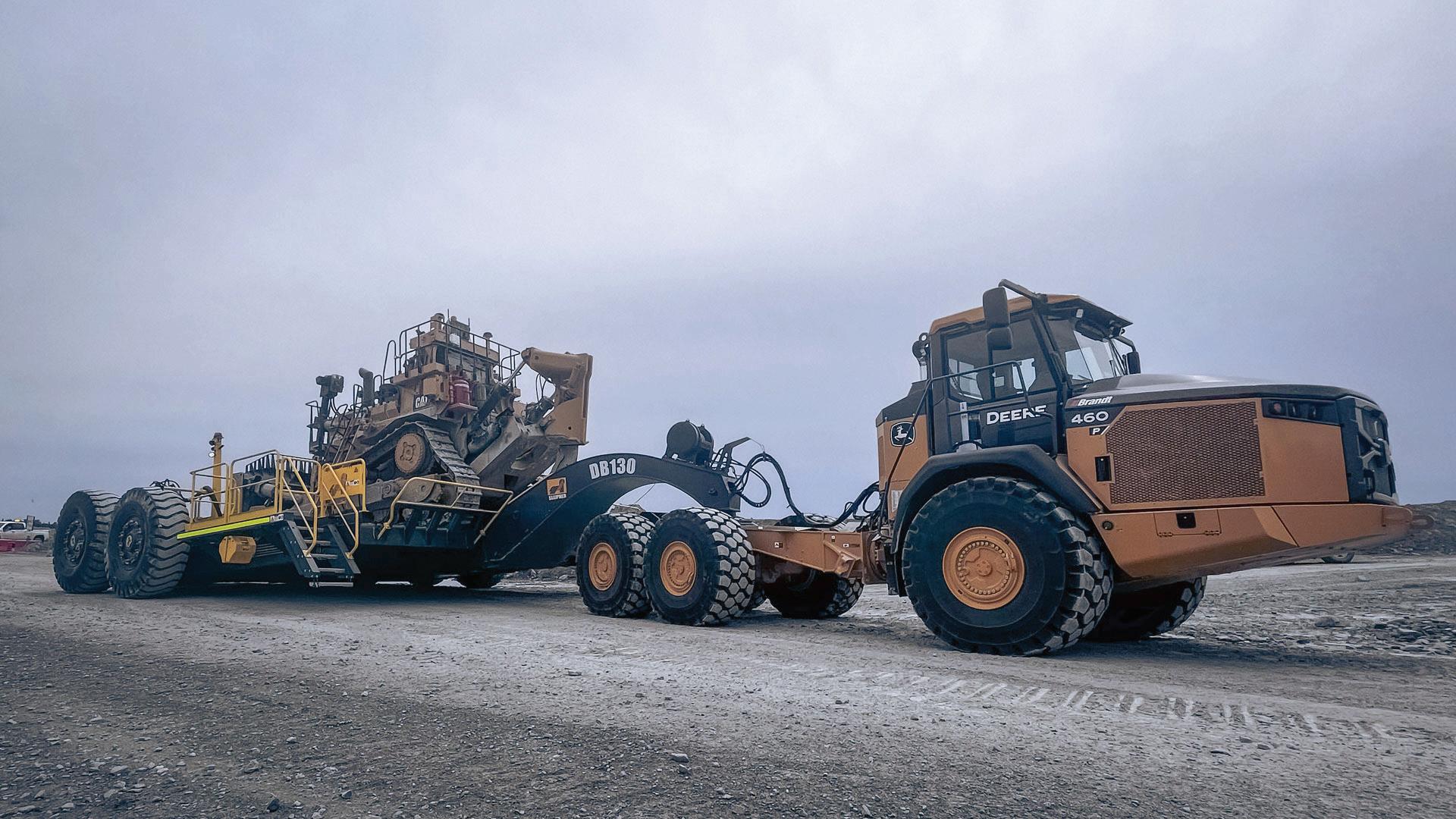
The hidden cost of transporting equipment
In surface mining, load and haul operations are the engine of production. But in that engine, there is a persistent leak — one that costs operations time, money, and machine life every single day: moving tracked equipment across the site.
It is a challenge so baked into mining operations that many see it as inevitable. Moving an excavator/shovel to a new bench or pit face? Budget for hours of downtime, thousands in undercarriage wear, and a truck queue backing up while you wait.
“There are many issues with the typical way of moving equipment on a mine site that interfere with productivity and profitability,” said Jim Thompson, vice-president of mining sales at Brandt. “There is total cost of ownership, which is not only the cost of the machine, but also maintenance and re-
pairs; mechanical availability — the downtime you experience during the time it takes to do that maintenance; and effective availability — using the machine in the most efficient and effective way. The ability to move equipment quickly and easily allows for more flexible and efficient mine planning that takes changes in production needs into account,” added Thompson.
Safety is also a concern. The vibration caused when moving a machine not only wears out components, but it also causes operator fatigue and even long-term health effects. “Reducing vibration improves work comfort and job satisfaction, leading to greater productivity and alertness, which reduces the chances of an incident,” Thompson said.
And then there are the CO2 emissions. The many hours spent
Every hour your machines spend in transit is bleeding your bottom line. A smarter haul solution changes everything.
DB130 in action towing a tracked bulldozer.

moving machines can result in hundreds of thousands of tonnes of emissions per mining operation each year. “The mining industry is always looking for ways to eliminate waste and reduce its environmental footprint,” notes Thompson.
An alternative to crawling machines to get them from point A to B is to employ a transportation system using lowboy trailers or dollies, such as those by Sleipner Finland.
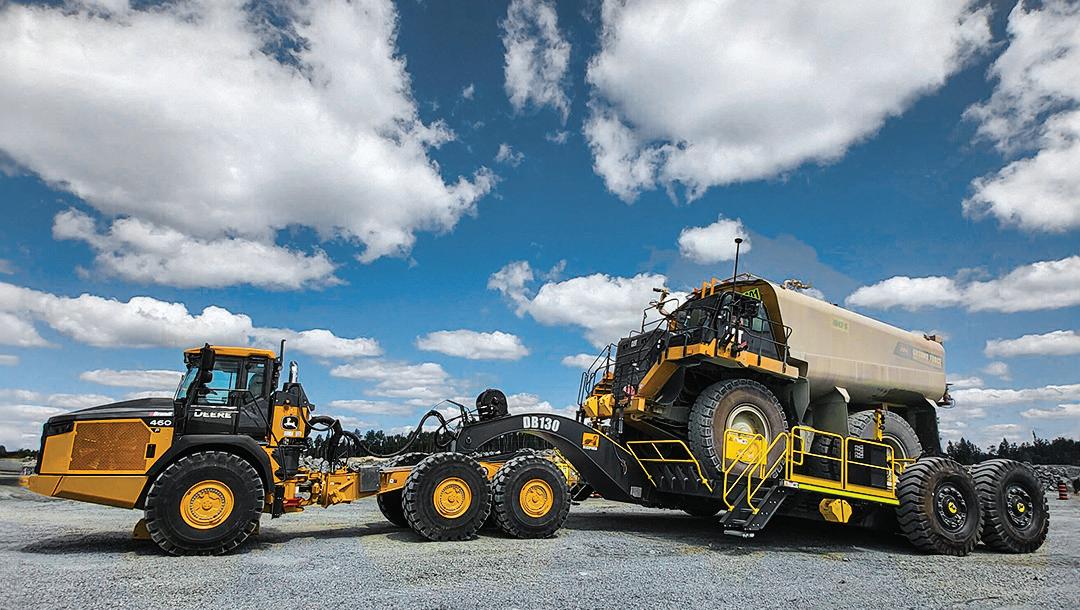
“We had a customer who used the Sleipner system to relocate a 570-tonne capacity machine. That move would normally have taken 40 hours. They now do it in 45 minutes. With a 12-hour workday, that means you can move 14 trucks in a single shift. When each truck carries thousands of dollars per load of materials, the time savings pays for the system in a single move,” Thompson says.
According to a calculator on the Sleipner website, using E-Series dollies to move a single 570-tonne excavator means a savings of money, time, and emissions over the course of a year. Here are the stats:
• Annual production increase: $2,613,600
• Annual undercarriage rebuild part savings: $231,000
• Life cycle costs reduction percentage: 10.75%
• Annual saved travelling time: 396 hours
• Fuel saved in year: 96,228 litres
• CO2 reduction in year: 257 tonnes
Sleipner’s DB Series Trailers have also been a hit with mining operations. “Operators appreciate the way these trailers are set up. With competing systems, you must disconnect the trailer and drive the equipment on the front, a process that takes 45 minutes and leads to safety concerns. With the Sleipner system, trailers are permanently connected with a rear-loading system, and you can load or unload the same piece of equip-
ment in two minutes. Our customers really value the time savings and increased safety,” Thompson says.
A case example for Sleipner DB130 trailers shows that, for a fleet of 19 dozers, two dozers tram always and 11 full-time mechanics are required per shift. When a Sleipner trailer is used to transport dozers to a workshop for service, it saves 20% of time compared to field service, meaning two fewer mechanics are needed per shift. Using the DB130 increases dozer efficiency by at least 5% — the equivalent of two dozers — so, the same job can be done with 17 dozers instead of 19. That leads to a huge reduction in annual life cycle costs.
“I have been in mining for over 30 years, and rarely does a product come along that is this transformational and impactful, not only for mining operations, but also for the industry itself. It is simple and immediately effective,” concluded Thompson. What it adds up to for the mining industry is a lower total cost of ownership, higher mechanical availability of equipment, more productivity, and increased effective machinery use — all the elements that make the engine of production run smoothly and efficiently.
Sabrina
Cataldo is a senior copywriter at Brandt.
DB130 which offers fast loading and agile transportation.
CREDIT: BRANDT
Side by side of the Sleipner E50-800 shortly after use.



Let’s talk tailgates





Key considerations to optimize return on investment (ROI)

Efficient hauling practices are at the heart of every successful mining operation. Maximizing capacity with each load while minimizing maintenance requirements and unnecessary downtime leads to increased profits and a healthy bottom line.
Many mining and aggregate producers have found simply adding a tailgate to their haul trucks makes a significant impact on their overall efficiency. Tailgates are not standard on rigid-frame haul trucks from any manufacturer. However, aftermarket options are available from manufacturers specializing in off-highway truck customization.
Like any piece of equipment, adding a tailgate requires careful consideration for optimal results. Some benefits can be achieved with any old tailgate, but to truly enhance their overall operation — and return on investment (ROI) — producers should look for a tailgate with features that align with their specific application. Let’s look at how tailgates can improve efficiency and what options are available.
Tailgate to the rescue
For being a relatively simple piece of equipment, tailgates can have a significant impact on how and how much material loader-operators will fill. This underhauling is often unintentional but usually results in loads that are 10% to15% below rated capacity. Sacrificing 15% of the load per trip is simply not affordable for mining and aggregate producers looking to remain profitable.
Hauling a half-full load costs relatively the same amount
of money in labour, fuel, and wear on a truck as a full load. By allowing loader-operators to meet the truck’s rated capacity without fear of spillage, tailgates quickly and easily boost an operation’s profitability. For example, a 70-tonne-capacity truck with a tailgate hauls its rated payload, which is nearly 11 more tonnes per load than a 70-tonne truck without a tailgate. Underhauling costs operations millions of dollars per year. If a fleet of six trucks adds 11 tonnes to each of their respective 12 loads per day, additional 792 tonnes are hauled daily. That equates to nearly $7,049 in profits if hauling aggregates at an average of $8.90 per tonne. It is like adding another truck to your fleet without the increase in fuel, maintenance, or labour.
Even with a single truck, adding a tailgate can greatly reduce underhauling. A mining producer using a custom tailgate on its Volvo A40D articulated hauler was able to increase capacity by 17% per load. Before adding the tailgate, the Volvo A40D averaged 31.48 tonnes per load. With the tailgate, loader-operators now average 36.7 tonnes per load.
Hitting the target
Whether it is increasing productivity or reducing downtime and freeing up equipment, moving material from point A to point B in fewer trips is important for maximizing productivity. By increasing capacity with each load, the above mining
A tailgate optimizes the loading target and equalizes weight distribution while reducing the risk of damage to a truck’s frame and suspension system.
CREDIT: PHILIPPI-HAGENBUCH
LOAD AND HAUL
producer was also able to reduce the overall number of trips back and forth with its VolvoA40D. This not only increased overall efficiency but also reduced wear and tear on the truck. Additionally, tailgates further reduce wear and stress on trucks by providing the loader-operator a better, larger loading target. Tailgates allow loaders to safely dump materials in the middle of the body, rather than near the front, improving loading target, weight distribution, and overall truck stability. Without the added benefit of the tailgate, loader-operators avoid spillage by placing most or all the materials toward the front of the bed. This loading technique ends up overloading and stressing the front tires, axles, and hydraulic hoist cylinders of the truck, resulting in premature tire wear, body maintenance, and potential axle and hoist cylinder damage. Typically, rigid-frame haul trucks are designed to carry onethird of the payload on their front axle and two-thirds on the back. Placing heavy materials toward the front puts excessive stress on the chassis, axles, front tires, suspensions, and hydraulic systems. Front tires are designed to support 33% of the weight, and when overloaded, rim damage may occur, or worse, they blow. Sometimes tires can be salvaged, patched or re-treaded, but even repairs are expensive, costing up to 60% of their original cost, in addition to the labour associated with repairing the tire and equipment downtime. An optimized loading target, equalized weight distribution, and reduced spillage means that trucks with tailgates can extend a tire’s service life by as much as 40% or up to 13,000 hours in some cases.
One thing to remember — even if a tailgate makes loading easier, that does not mean loader-operators should overload. A 150-tonne truck cannot haul 175 tonnes of material without operating outside of the OEM truck manufacturers guidelines; this can cause damage and safety hazards in addition to voiding the truck warranty. Squeezing an extra 25 tonnes in a load might seem like a quick way to bring in extra profits; however, repair costs far exceed the additional revenue if you blow a tire or cripple the chassis and axles. The goal of tailgates is to achieve the trucks rated payload.
Maximizing uptime
Optimizing payload capacity and reducing tire and axle wear are only the beginning. The benefits of adding a tailgate extend beyond the truck to haul roads and the other equipment, as well. Anyone who spends their day in a mine knows roads are narrow, rough, and littered with spillage, which makes them hard to navigate and poses risks to the trucks and other equipment operating at the site. All options for dealing with the challenges result in lost time or increased expenses. Deploying road grading crews to clean debris off haul roads equates to lost productivity and the added costs associated with the fuel, labour, and expense of additional equipment.
Navigating debris can damage tires as well as the truck’s suspension systems. In some large mines, more than 200 tires are replaced per month because of debris damage or overloading. Many businesses are not equipped to handle the negative impact that has on overall profitability, especially since the cost
of rubber has skyrocketed over the last decade. Most mining truck tires cost upward of $50,000 apiece, with some larger models topping out at $100,000 each. Combine those extra costs with downtime caused by the repairs and replacement, and the impact can be devastating. A global tire shortage for mining-class vehicles only compounds the problem with longer-than-normal wait times just to receive replacement tires.
Weighing the options
Crunching the numbers, it does not take long to realize the benefits of a tailgate quickly add up. A tailgate enhances operations whether you are hauling aggregates, copper, coal, iron, gold, oil sands, or soupy, viscous materials. But to truly maximize profitability, certain design aspects should be considered before making a purchase decision, such as durability and versatility. There are a variety of tailgate options on the market. Finding the design that complements the specific quarry or mining operation is important.
First and foremost, work with a manufacturer that engineers their tailgates for each specific make and model of truck and truck body. Options exist for rigid and articulated frames. Some custom manufacturers have even engineered models that bolt directly to the undercarriage of the off-highway truck. Quick disconnect options, such as fluidic seals or cushion pads, are customizations that are available and should be considered, depending on the application. Operators should look for designs that do not require any welding to the frame, as welding to the frame of an off-highway truck may invalidate the OEM warranty, while making sure that the brand they choose offers stability, quality, and structural integrity.
How a tailgate opens is also important for efficiency and long-term durability. A tailgate that lifts, for example, provides increased efficiency over a model that drops down. A dropdown tailgate is sometimes slower when opening and closing and is more susceptible to damage from the dumped materials. These designs often rely on pins or hydraulic systems, and when there are more grease points, cylinders, and joints, the risk of increased maintenance and failure exists. They might seem like quick, economical solutions, but dropdown tailgates often end up costing more for repairs and replacement in the long run and are simply not an option for large ultra-class rigid frame mining trucks.
Ultimately, a lifting, scissor-style tailgate has fewer moving parts, so there is less potential maintenance. However, it is important to ensure these few parts are tough enough for the job since not all tailgates are created equal. A tailgate will not last long if it cannot withstand the breadth of material being hauled. Find a tailgate that is built with durable materials, such as high-strength steel, and features strong components including steel alloy chains and fiber bushings that do not require ongoing lubrication. Certain manufacturers design their tailgates specifically for durability, resulting in a tailgate that can take a beating but still lasts for decades with minimal maintenance.
Customizations to tailgates are also a way to tie them into
the truck fleet methodology employed at any given site. Truck bodies frequently have sideboards that add height to the sides for either added volumetric capacity or to keep material within the bed. In this case, having the tailgate built up to the height of the sideboards creates a unified height around the entire bed, as opposed to a high-sided body with a low-sided tailgate.
Adding cushion pads to a tailgate will soften the blow when it is raised and lowered in harsh worksite conditions. When operations have extremely bumpy haul roads, or when mining underground, the cushion pads minimize noise and increase the tailgate service life and other truck components.
Operations that haul large amounts of wet material arguably need a tailgate more than any other operation that uses off-highway haul trucks. In these applications, a tailgate with a fluidic seal can create a near-perfect seal, resulting in minimal fluid leakage during transport. Few manufacturers can contain 100% of the liquid material, but manufacturers with years of experience have engineered designs that can contain up to 99.5% of wet materials, which are invaluable for specific applications.
For operations that require a 100% positive seal, there are specialty tailgates available from select manufacturers. These designs build up the rearmost portion of the truck body or container to create a cohesive flange from which the tailgate compresses. Two hooks on either side of the base of the flange intercept a corresponding tag on the tailgate, allowing the tailgate to pivot inward as the sidearm and over-center locking mechanism compressively lock the rear tailgate into place.
This creates a water-tight seal that contains liquid materials within off-highway truck bodies or roll-off containers. Finally, make sure the tailgate lifts high and fast enough to get out of the way before material starts to unload. The last thing you want is the tailgate to hold back the material during dumping rather than allowing it to flow freely out of the back of the truck body. Fast dumps lead to increased efficiency and productivity. Materials left behind in the bed or stuck in grease points damage hinges and overall structure, and the amount of carryback reduces the volume of the next load.
Optimizing ROI
Increasing volume, reducing maintenance, and maximizing hauling efficiency — for a simple piece of equipment, a tailgate, can sure make a big difference. Six 100-tonne-capacity trucks with tailgates hauling ore could result in approximately $10,700 in additional profits per day. Even with the average tailgate cost between $22,500 to $30,000 — based on the size of haul truck and options chosen — a producer purchasing six tailgates for his 100-tonne truck fleet would see a complete ROI on a tailgate project purchase in less than 17 days with those numbers, and that is based on profit alone. Factor in additional fuel and tire cost savings associated with the use of tailgates on a truck fleet, and the numbers really start to add up. Pay for tailgates once and reap the benefits for the truck fleets lifetime.
Josh Swank is chief growth officer for Philippi-Hagenbuch. He oversees their global sales team.
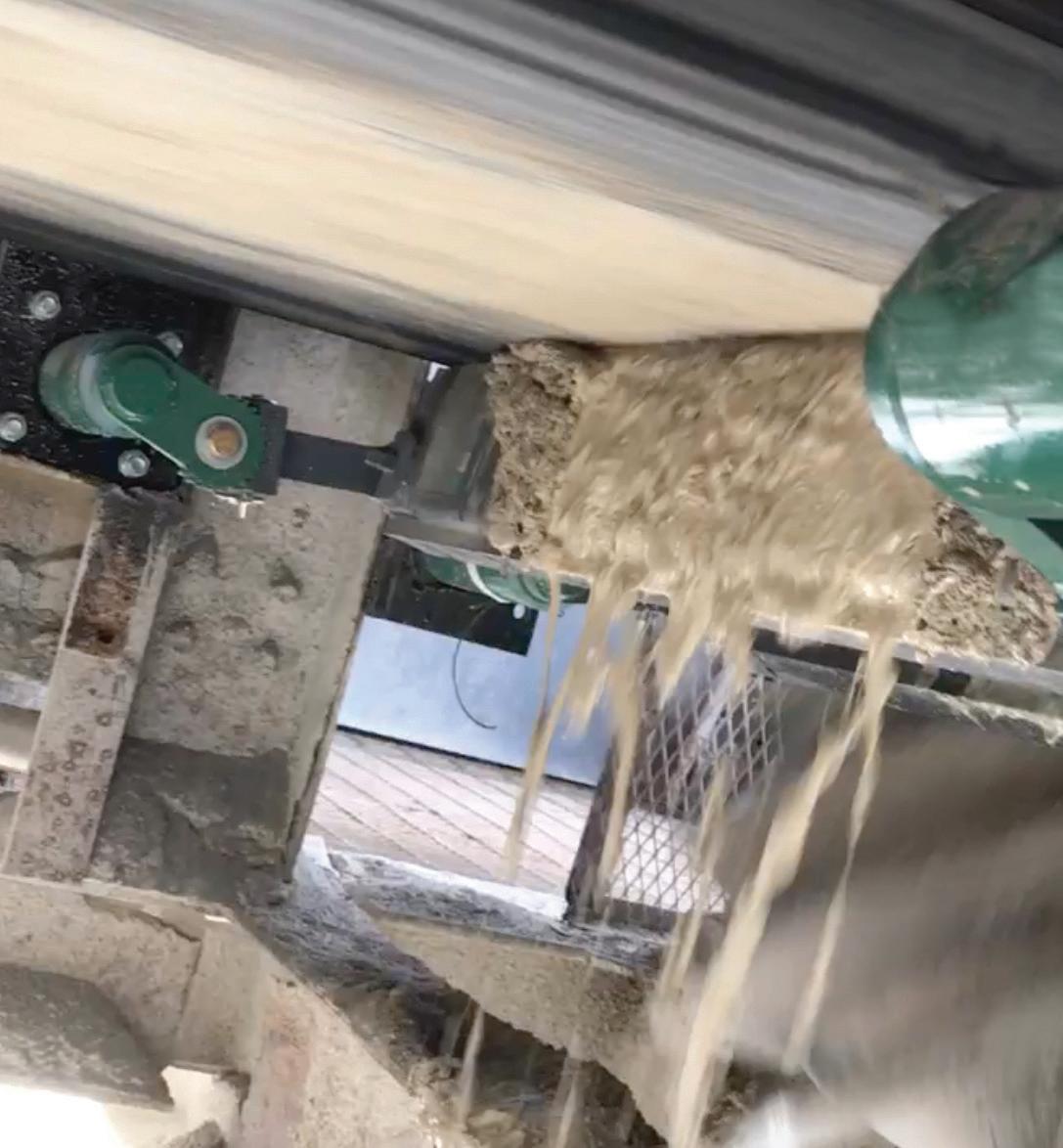
By Greg Wabik

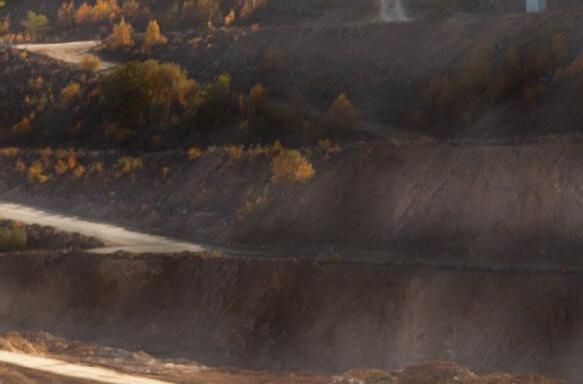
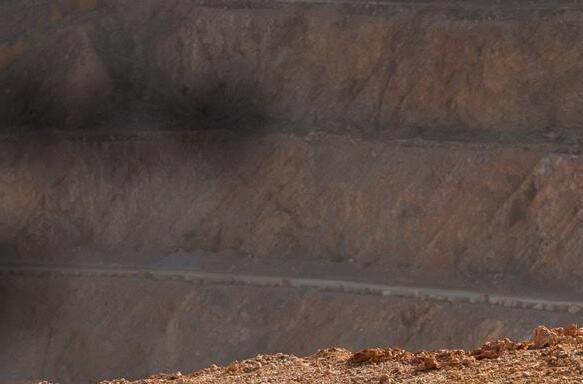
Subsurface imaging: Theriseofnewtechnologies
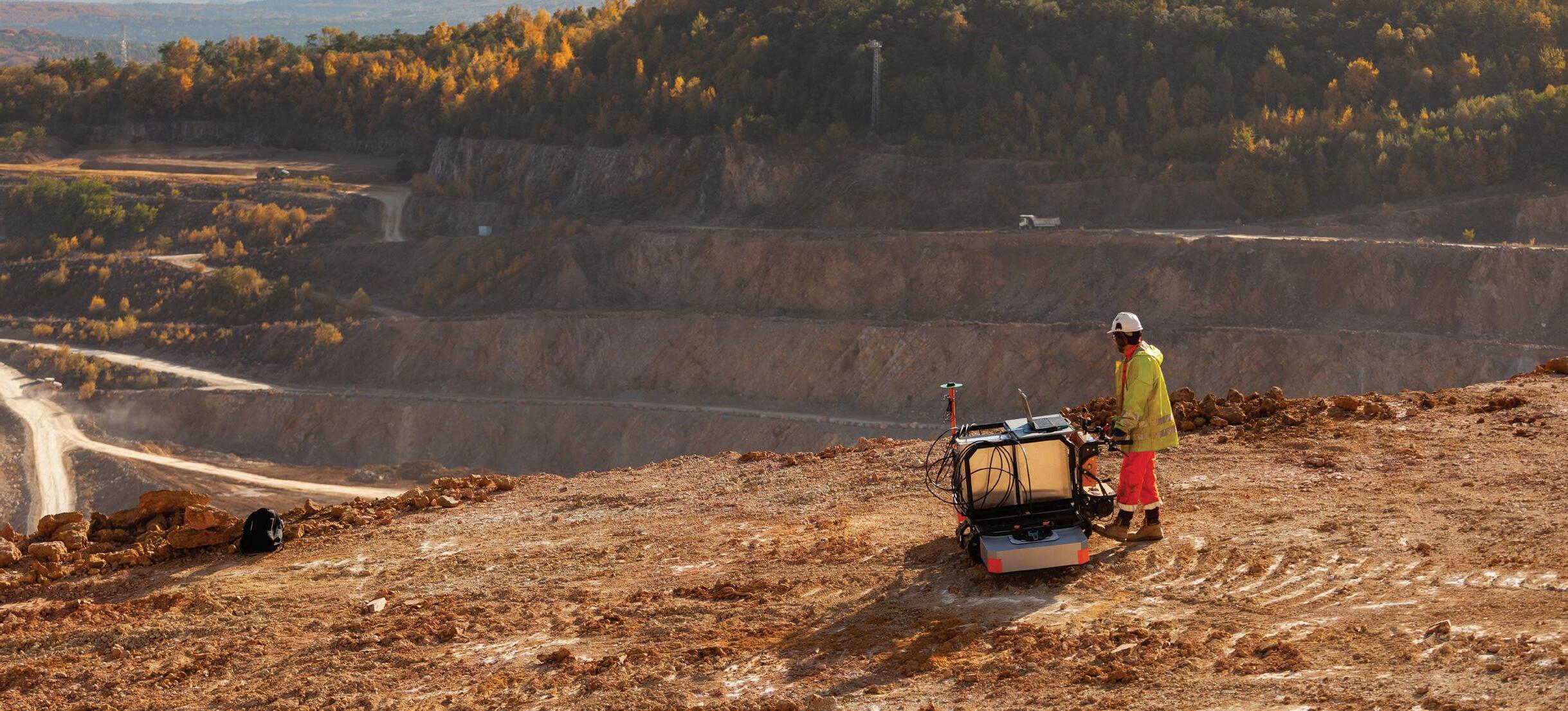
In an era defined by the urgent need for more efficient, sustainable, and financially sound mining practices, the methods used to explore the subsurface are under scrutiny. Traditional drilling, once the undisputed cornerstone of mineral discovery, is increasingly seen as too slow, too expensive, and too limited for today’s complex mining landscape. As exploration targets become deeper, more remote, and more technically challenging, the industry is turning toward innovative technologies that promise to transform how resources are identified and valued.
The future of subsurface exploration is poised to be shaped by advancements in artificial intelligence (AI), remote sensing, and autonomous systems. Subsurface imaging paired with AI engines is expected to enhance the speed and accuracy of decision-making during exploration activities. As demand for critical minerals rises, integrating these cutting-edge technologies will be essential for meeting global resource needs efficiently and responsibly. The mining sector is now ripe for disruption and becoming cleaner, safer, and far more precise.
Rethinking risk in the mining industry
According to McKinsey’s 2024 report, “The Capex Crystal Ball: Beating the Odds in Mining Project Delivery,” approximately 83% of major mining and metals projects have experienced significant cost and schedule challenges, with more than 40% experiencing capital expenditure overruns, while project timelines were delayed in 20% to 30% of the cases. The outlook is even more concerning for megaprojects valued at $1 billion or more, where the incidence and magnitude of overruns are notably higher.
Deviations from cost and schedule estimates often arise from poor initial budget or time assessments or from poor execution. It has been shown that two-thirds of cost overruns and schedule delays could be attributed to poor initial assessments, with the remaining one-third related to poor execution. According to McKinsey’s report, one of the three notable things that the “winners” (companies that experience less cost overruns) do right is investment in the rigorous feasibility studies. Surprisingly, the solutions to these inefficiencies are not in abundance.
Critical minerals, critical moment
Global venture funding has been heavily skewed toward software and emerging technology while investment in mining technology has been volatile. Mining-tech startups have been facing funding hurdles, which directly impact their advancements. This landscape is slowly changing with the increased demand for raw materials and growing trade tensions between regions. Materials such as copper and nickel, which play key roles in the energy transition technologies, are expected to experience significant demand growth. In fact, for these two metals alone, capital expenditures of $250 billion to $350 billion could be needed by 2035 to expand and replace the depletion of existing supply.
Can the traditional methods keep up?
Borehole drilling has long been the backbone of both greenfield and brownfield mineral exploration, but its limitations are hard to ignore. Boreholes provide only point-specific data, offering a narrow view of subsurface geology and leaving large areas between drill sites unexplored. Interpolating this data to fill the gaps adds uncertainty to geological models and increases the risk of costly errors. In greenfield projects, where little prior geological information exists, this can lead to missed opportunities or wasted investment. On the other hand, in brownfield sites with known geology, drilling can overlook critical features like karsts or old mine workings. The high time and cost demands of drilling further reduce its efficiency as a stand-alone method.
Revival of old mines
More companies are reactivating previously abandoned mining assets — once considered financial liabilities — as they reassess profitability in the context of the new economy. In Canada’s Yukon Territory, the Selkirk First Nation recently took over the Minto mine — once a significant copper producer — after its previous owner declared bankruptcy. In Quebec, Doré Copper Mining, now under Australia’s Cygnus Metals, is reopening a site dormant since 2008. In Spain, Denarius Metals is reviv-
Spectral scanning technology delivers full subsurface coverage in days.
CREDIT: WIDMO
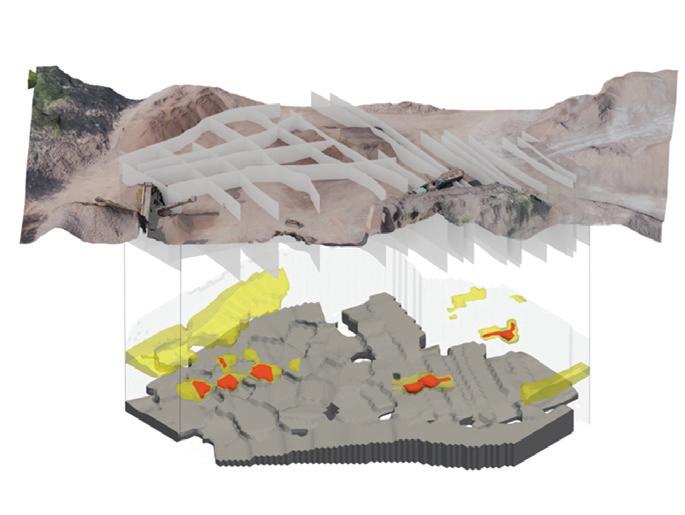
Gravel mine in Germany: Gravel deposit volume and clay lens locations were mapped using Widmo SGPR scanner.
ing the Aguablanca mine following a seven-year hiatus. To minimize uncertainty and confidently evaluate the return on investment (ROI), investors now demand higher-quality data upfront.
Traditional borehole drilling methods often fall short in identifying the full range of risks associated with reviving old mines, including outdated plans, newly formed cavities, and other unexpected challenges. This gap has created opportunities for innovation in geophysical technologies. One rising player in this space is the European startup “Widmo,” which has recently expanded into Canada and the U.S. to address growing demand for advanced, data-driven subsurface imaging technologies.
The rise of smart geophysical methods in mining Zygmunt Trzesniowski, one of the minds behind Widmo, combined his field expertise as a former Saudi Aramco engineer with seismic imaging technologies studied by Dr. hab. Andrzej Kułak, a physicist affiliated with the AGH University of Science and Technology and the Astronomical Observatory of the Jagiellonian University. His research adapted solar observation techniques — typically used in astrophysics — to monitor Earth-based phenomena using waveforms. Building on passive seismic imaging, Widmo’s solution integrates two innovations:
Safe ground starts here
These technologies offer significant advantages when used alongside borehole drilling. Time-lapse measurements enable ongoing subsurface monitoring, allowing detection of geological and tectonic changes over time. Advanced scanning methods also identify subsurface anomalies — such as cavities, voids, or fractures. This early detection helps reduce the risk of ground instability or collapse, ultimately enhancing worker safety.
Expert perspectives on geophysical integration
Leading experts in mineral exploration emphasize the transformative impact of integrating geophysical methods into traditional exploration workflows. In a previous interview, Aaron Tomkins, principal geoscientist at GBG Group, highlighted that combining geophysical data with geological insights enhances the accuracy of subsurface models, enabling more informed decision-making and reducing exploration risks. This integrated approach allows for the identification of mineral targets with greater precision, optimizing resource allocation and increasing the likelihood of discovery. The SGPR methodology is ideal for identifying rare earth minerals at shallow depths, up to 50 metres, based on dielectric parameters and ohmic resistivity. As the mining industry continues to evolve, the synergy between geophysics and geology is becoming increasingly vital for successful exploration campaigns.
BRAKE SYSTEMS
Greg Wabik is a business development associate at Widmo Spectral Technologies.
• MANUFACTURER
BRAKE SYSTEMS INC
• REMANUFACTURER
• First, its Spectral Ground-Penetrating Radar (SGPR) combines frequency-modulated continuous-wave (FMCW) technology with a broadband antenna to detect the dielectric “fingerprints” of different materials across frequency domains.
• MANUFACTURER
• WAREHOUSE DISTRIBUTOR
• REMANUFACTURER • WAREHOUSE DISTRIBUTOR
• AIR CYLINDERS • BSV /WILLIAMS
AIR CYLINDERS
BSV /WILLIAMS
AIR VALVES
• Second, soon to be launched, is WIDMO Analytics — a machine learning (ML)-driven processing suite designed to automatically ingest borehole logs alongside SGPR data to generate real-time, continuous three-dimensional models. On a broader mission, Widmo aims to bridge the gap between shallow, limited Ground-Penetrating Radar (GPR) technologies and deep geophysical methods like seismic imaging and high-resolution electrical resistivity tomography, making advanced subsurface exploration more accessible, faster, and far more precise.
Cost and time efficiency
The immediate time and cost savings of accurate subsurface scanning are easy to calculate. Mirosław Trzesniowski, Widmo’s CEO, notes that an exemplary hard-rock exploration over an area of 0.25 km2 would typically require approximately 150 boreholes, cost up to one million dollars, and demand more than 8,000 hours of drilling. Widmo’s profiling can save over $ 800,000 (80%) and more than 7,400 field hours. A survey of this size takes just three to four days. These efficiencies demonstrate how high-resolution scanning delivers full subsurface coverage in days, not weeks, radically lowering both capex and schedule risk. But the benefits go beyond cost savings: reducing capital risk — through more accurate data and diminished uncertainty — is the real payoff.
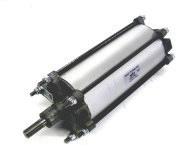

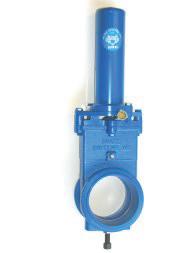
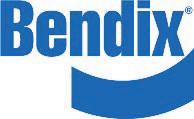






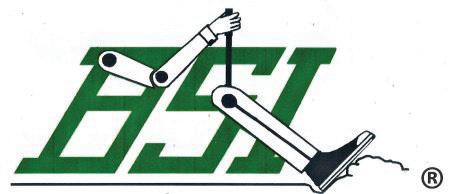
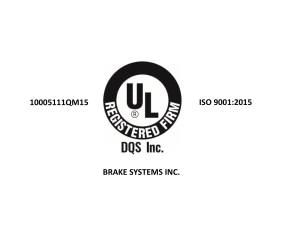


MINING SPOTLIGHTS
GOLD TERRA
Gold Terra (TSX.V: YGT) is advancing its Yellowknife City Gold (YCG) project and Con Mine option property near the namesake city in the Northwest Territories and on the Campbell Shear structure. The nearby Con Mine produced 5.1 million oz. grading 16 grams gold per tonne from that shear from 1938 until 2003. It closed because of the low gold prices.
Gold Terra reported in April that its first wedge hole at the Con property pierced the Campbell Shear from about 2,665 metres depth in hole GTCM25-056A. Assays are pending. The intersection is about 600 metres below the current depth of the historic Robertson Shaft. The result follows the initial piercing of the shear with hole GTCM23-055 that cut 1.7 metres at 12.63 grams gold from 2,075 metres in November 2023.
“The intersection proves the company’s model showing the high potential for the shear’s continuation at depth and down plunge of the historic deposit that was mined,” CEO Gerald Panneton said.
The wedge hole drilling program, which includes branches off the main hole comprises about 3,000 metres and started in January. The program aims to expand the September 2022 initial resource that outlined 450,000 indicated tonnes grading 7.55 grams gold for 109,000 oz. of contained gold; and 2 million inferred tonnes at 6.74 grams gold for 432,000 inferred oz.
Gold Terra’s 918-km2 YCG project, located on properties north, south and east of the city, hosts 24.3 million inferred tonnes grading 1.54 grams gold for 1.2 million ounces, according to a 2021 resource.
Gold Terra has a market capitalization of $24.27 million.
WESTHAVEN GOLD
Westhaven Gold (TSX-V: WHN) is progressing its Shovelnose gold property, located about 30 km south of Merritt, B.C. The project is advancing a high-grade gold discovery in the Spences Bridge gold belt, one of Canada’s most recently recognized gold districts.
Shovelnose has potential as a robust, low-cost and high margin underground mine with an 11-year life, according to an April 2025 updated PEA. Its average annual life-of-mine production is estimated at 56,000 oz. with an after-tax NPV of $454 million (at a 6% discount) and an IRR of 43.2%. The updated doubled the NPV over the initial PEA from 2023. Initial capital costs are pegged at $184 million, and the payback period is 2.1 years.
Shovelnose hosts 3.4 million indicated tonnes grading 6.1 grams gold and 32 grams silver for 677,000 contained gold oz. and 3.5 million contained silver ounces. Inferred resources total 2.2 million tonnes at 3.6 grams gold and 25 grams silver for 270,000 contained gold oz. and 1.8 million contained silver ounces.
Westhaven also drilled the highest-grade gold intercept ever on the Shovelnose property in April 2022 at the FMN zone. This intercept cut 23.03 metres grading 37.24 grams gold and 209.52 grams silver from 94 metres depth, including 1.12 metres at 294 grams gold and 2,110 grams silver.
In February, Westhaven announced its winter drilling program at Shovelnose that was to drill about 2,500 metres at the Certes 1, Certes 3 and Corral targets. That came one year after Westhaven received a five-year, 650-drill hole exploration permit.
The company plans to continue with exploration work at Shovelnose as it advances the project and de-risks it with environmental baseline studies and permitting work, CEO Gareth Thomas said.
Westhaven Gold has a market capitalization of $23.5 million.
By Habib
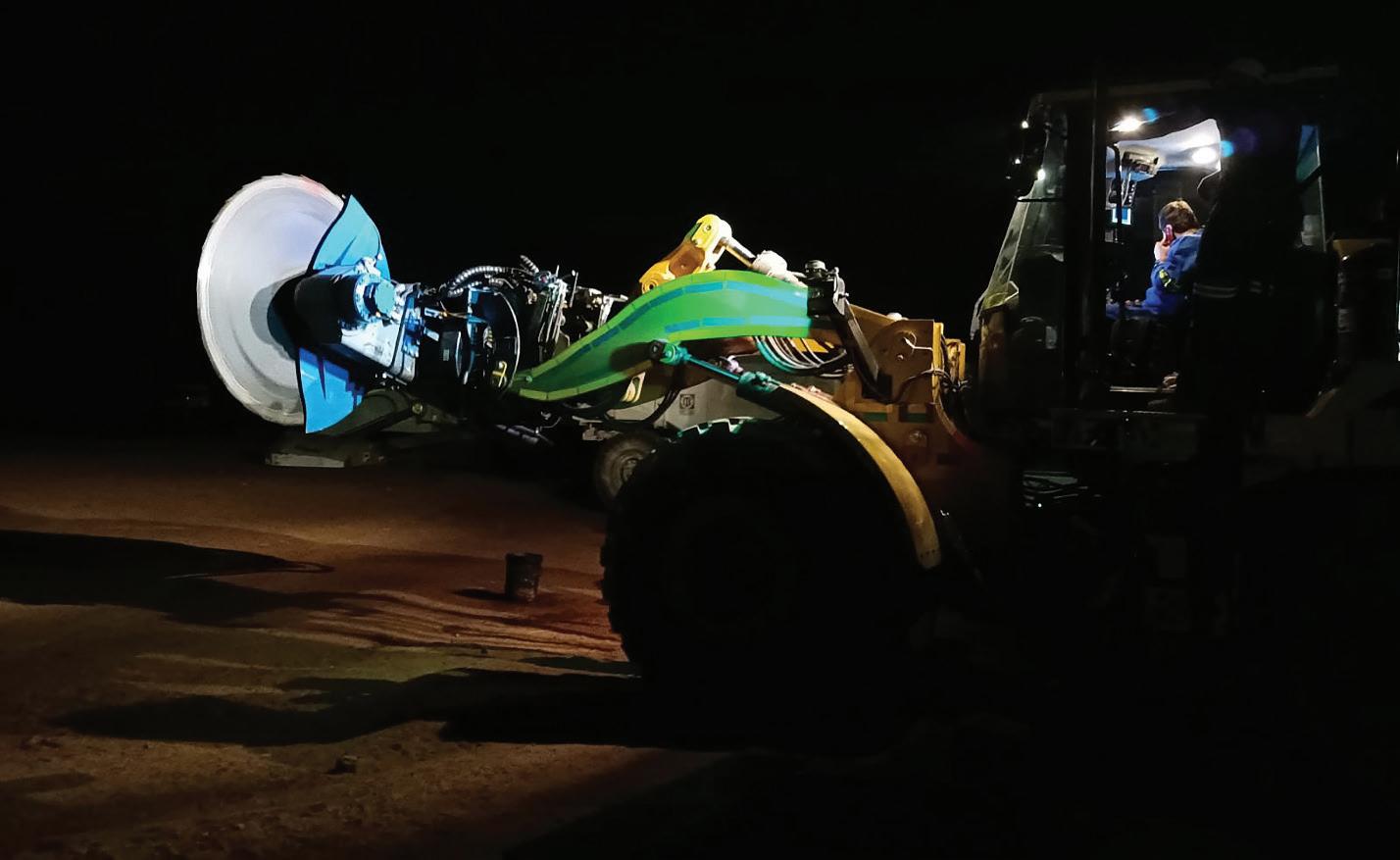
Revolutionizing tunnel development: Synthetic diamond technology
for mining and infrastructure applications
Anew strategic partnership promises to transform tunnel development technology. The recently announced collaboration introduces a novel diamond-enabled cutting system designed to enhance tunnel development speed, reduce costs, and minimize environmental impact across the mining, infrastructure, transportation, and energy sectors.
Element Six (E6), a member of the De Beers Group, has been at the forefront of synthetic diamond innovation for over seven decades. The company specializes in the development and manufacturing of polycrystalline diamond (PCD) and other advanced materials. As Thomas Trott, sales director for road, mining, and wear at Element Six said, “With more than 70 years of sustained investment and expertise, E6 was one of the first companies in the world to commercialize PCD industrial materials. Today, we continue to harness these capabilities to deliver novel solutions that can revolutionize critical industrial applications.”
Master Drilling, established in 1986, is a global company specializing in drilling technology solutions. The company provides a range of mechanized services to the mining, infrastructure, and energy sectors and is known for its innovative solutions and tailor-made engineering designs.
The strategic partnership
Both companies joined forces to develop a novel, synthetic diamond-enabled tunneling solution to develop high-tech solutions for industrial applications.
Tools for drilling applications dramatically increase the productivity per metre drilled. CREDIT:
The innovative tunneling solution reduces waste rock generation by more than 17% compared to traditional methods. The technology has been tested in various mining and construction sites across the U.K. and South Africa and has demonstrated improved performance and efficiency compared to traditional solutions.
Patented tools and application techniques of cut and break method have been applied to different manufactured and natural materials, including concrete, reinforced concrete, granite, kimberlite, limestone, and chromite-containing ore and waste rock materials in end-users ’ applications.
Key benefits delivered by this cutting-edge
PCD-enabled technology include:
• Safety and rock-stability: The absence of blasting and diesel requirements ensures safer working conditions and increased rock stability owing to the mechanized cutting and breakage process.
• Enhanced productivity: Synthetic diamond cutting tools can manage soft to ultra-hard and high-strength rock removal, resulting in higher productivity rates and longer cutter life.
• Reduced waste generation: The technology minimizes muck production, converting circular cross-sections to non-circular with a wider flat bottom, creating more usable space for ventilation and electric cable systems.
• Operational simplicity: The lightweight and mobile solution requires fewer operational crew members and offers versatile capabilities in confined underground conditions.
DRILLING AND BLASTING
• Cost effectiveness: The shorter tunnel development period allows for quicker ramp-up of mining and construction projects, reducing capital costs and shortening investment return times.
Why is this technology important?
Underground tunnels are essential for accessing mineral resources, creating efficient transportation routes, and housing utilities while minimizing surface disruption. Achieving high-quality, nonexplosive tunnel construction with various aspects of value generated compared to traditional rock excavation methods is a key global challenge for tunnel builders.
Synthetic diamond innovation holds immense potential to shape the future of industrial applications. By extracting a lower amount of rock during tunnel development, the new technology will significantly reduce waste and environmental impact, ensuring a better tomorrow for generations to come.
By using PCD cutting tools, this novel cut-break technology provides an innovative development platform for tunnel builders. Synthetic diamonds, with their exceptional hardness, high thermal conductivity, and low friction coefficient, outperform traditional materials, such as carbide and steel, in cutting hard and high-strength rocks. This leads to higher productivity with a minimal rate of cutting element wear during the excavation of hard-to-ultra-hard rocks.
Sustainability and prospects
This synthetic-diamond-based technology also aligns with a broader sustainability effort, reducing environmental impact through efficient resource use and lower energy consumption.
The use of synthetic diamond technology in tunneling not only improves operational efficiency but also contributes to the overall sustainability of mining and construction projects. By reducing the need for blasting and diesel-powered equipment, the technology minimizes greenhouse gas (GHG) emissions and enhances the safety and stability of tunnel structures. This innovative approach aligns with the global need to push towards more
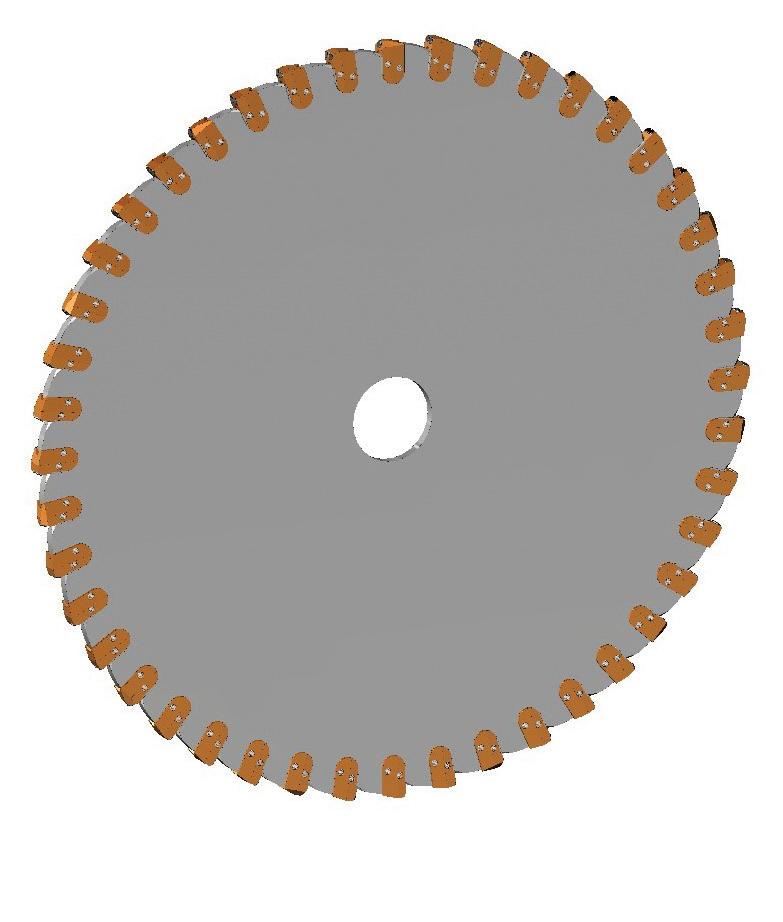
sustainable and environmentally friendly industrial practices. Furthermore, the technology’s potential applications extend beyond mining and construction to include trenching for fiber-optic cables or pipes. Additionally, the solution holds promise for general tunneling, widening, and custom excavations from tunnels that require non-explosive excavation, enlarging current tunnels for larger equipment or because of closure, excavation of overcuts to tunnels to fit equipment such as water doors and barriers, undercutting tunnels to allow for grouting barriers to be installed, breakaway tunnels for existing tunnels, without damaging camelbacks owing to ripping cable anchors and rock support out, and excavating niche excavation in TBM tunnels, such as laybys or chambers for services installation.
Conclusion
The introduction of this synthetic-diamond-enabled cutting technology stands for a major advancement in tunnel development. As industries continue to seek more efficient and sustainable solutions, innovation and progress can be fostered through strategic partnerships. The novel technology promises to revolutionize tunnel construction, delivering significant potential benefits to the mining, infrastructure, transportation, and energy sectors for years to come.
Habib Saridikmen is head of applications at Element Six, and Koos Jordan is executive director of Master Drilling.
ADVERTISERS INDEX



Find what and who you need
TNM Marco Polo is the next generation of The Northern Miner Mines Handbook. This new online data platform will allow you to quickly uncover market data, financial information, personnel, reserves and resources, and more on over 8,000+ companies and 13,000+ properties around the world.
8,000+ Companies
13,000+ Properties





20,000+ Executives + Personnel



Learn more at marcopolo.tnm.global

















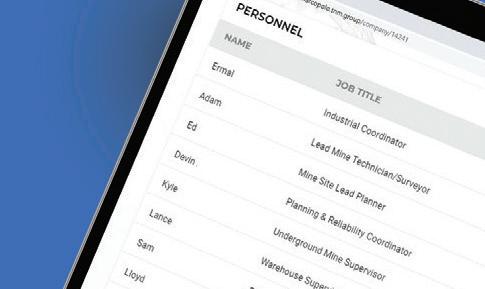

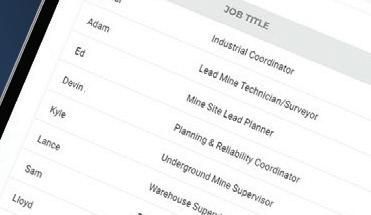







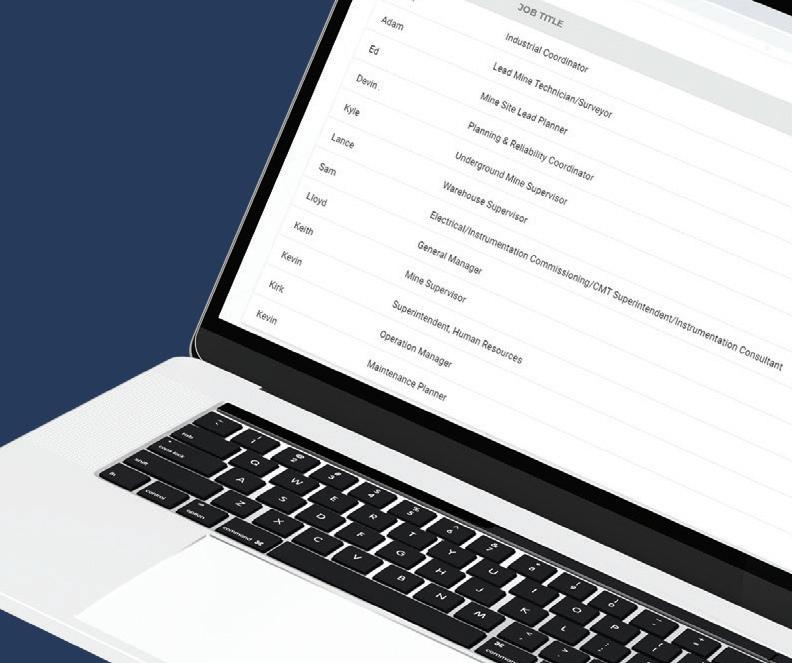

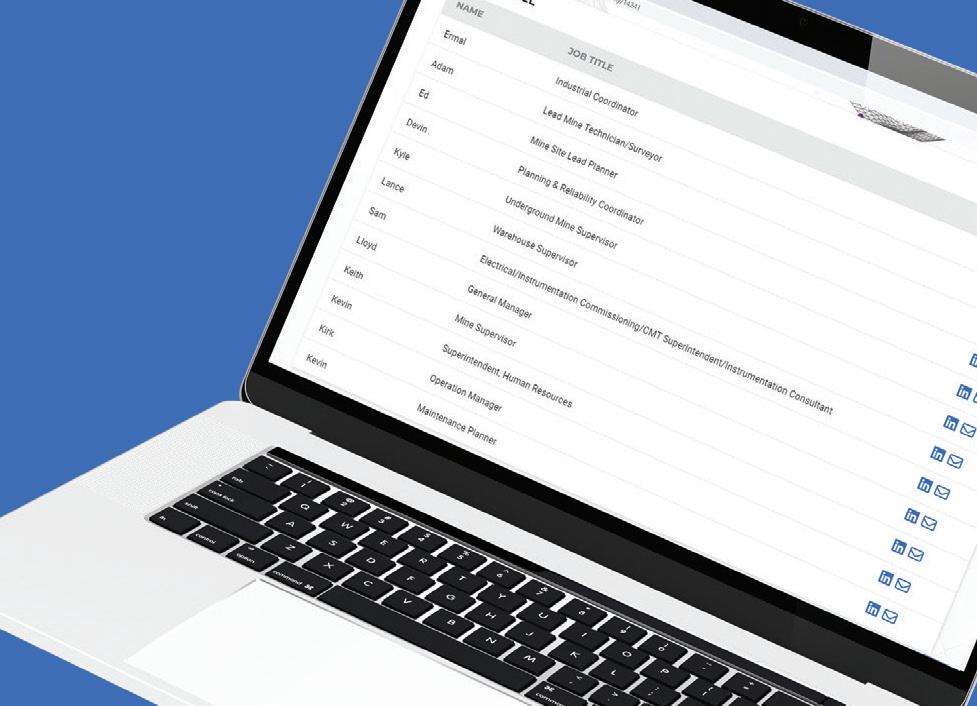





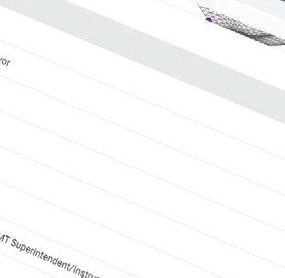
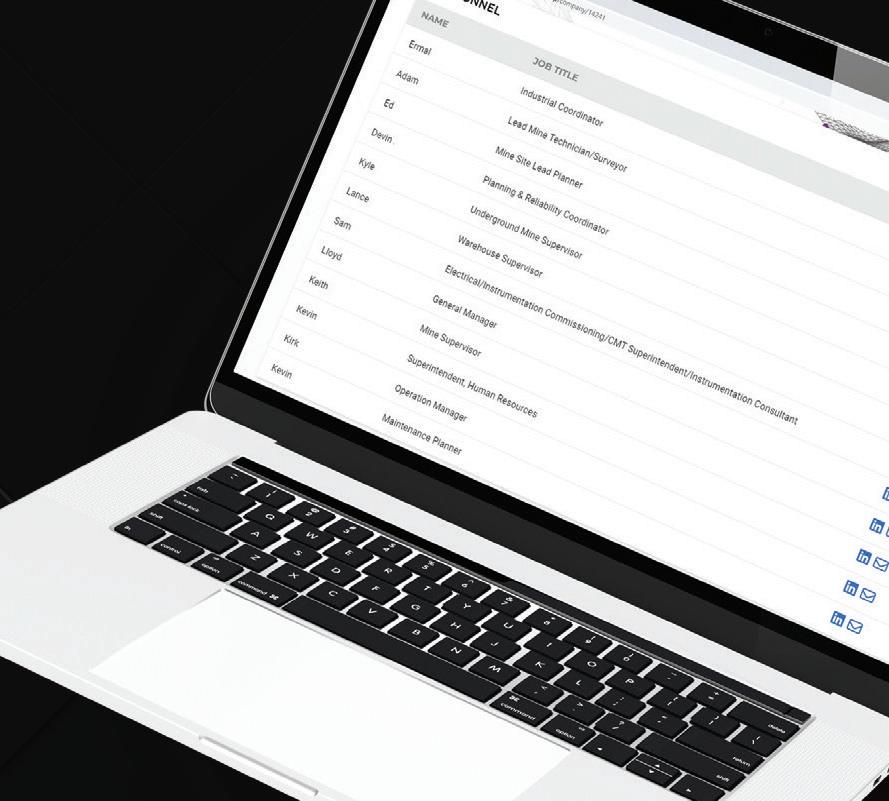
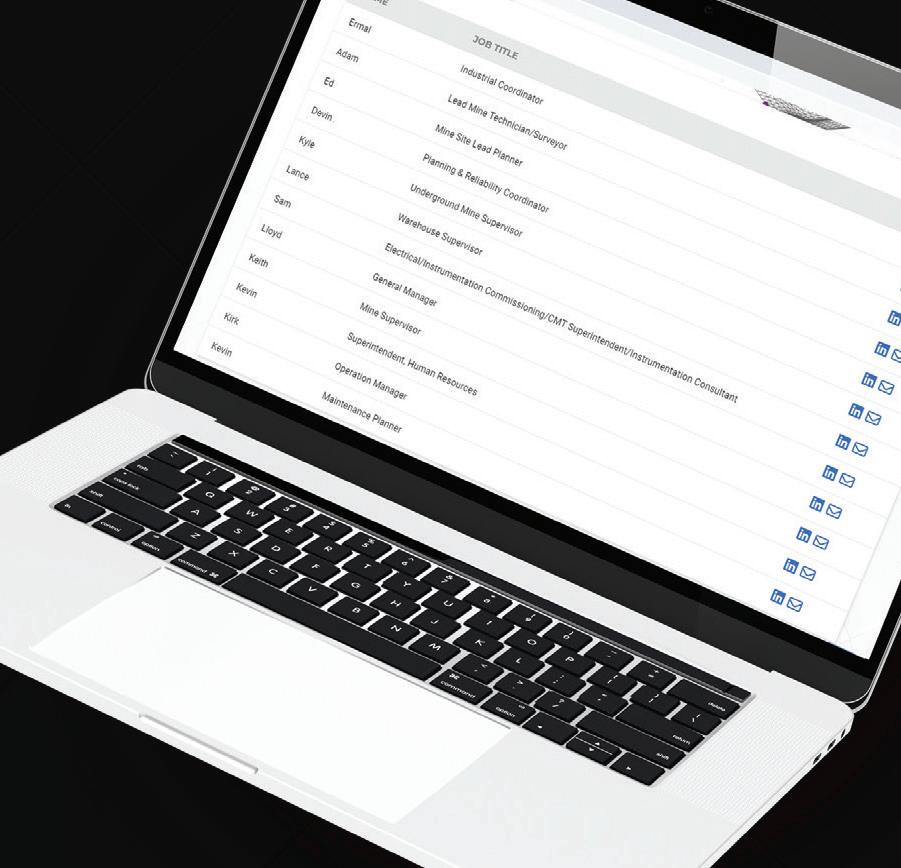















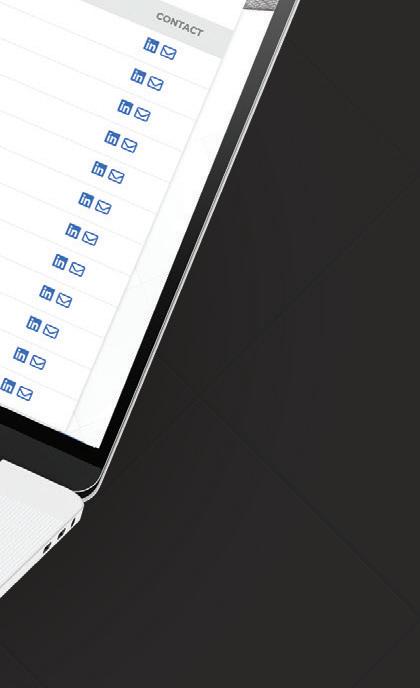
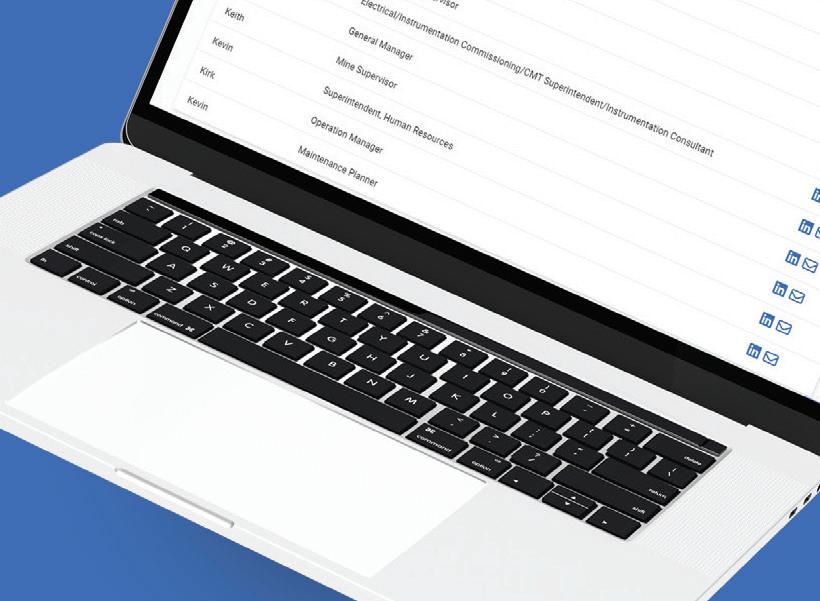













SCAN ME

Go electric. Go Sandvik.















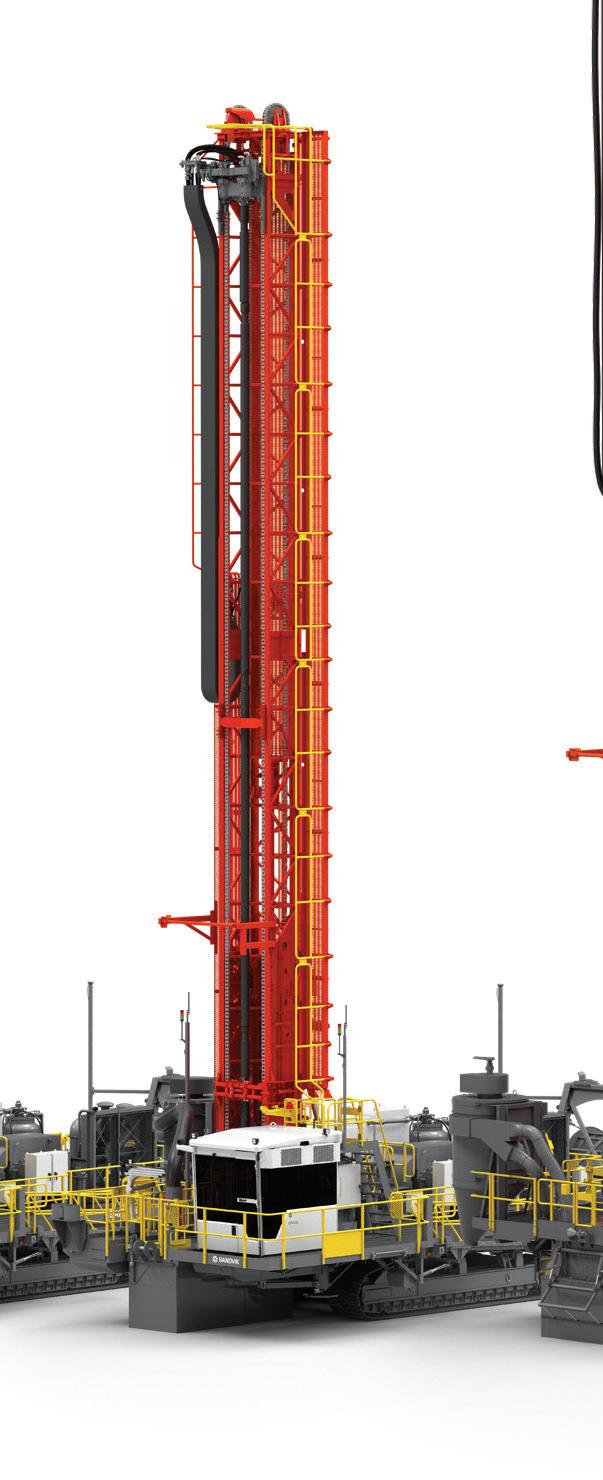


Sandvik iE series electric rotary drills are mining’s answer to a cleaner, greener future.
No emissions. No compromise. Just powerful performance that lowers your carbon footprint while keeping productivity high.


DR410iE
